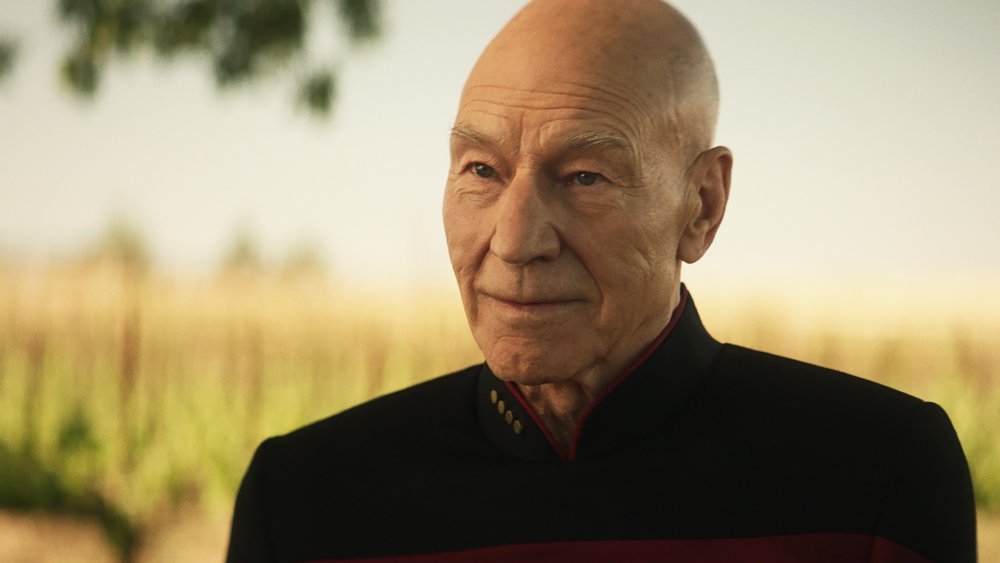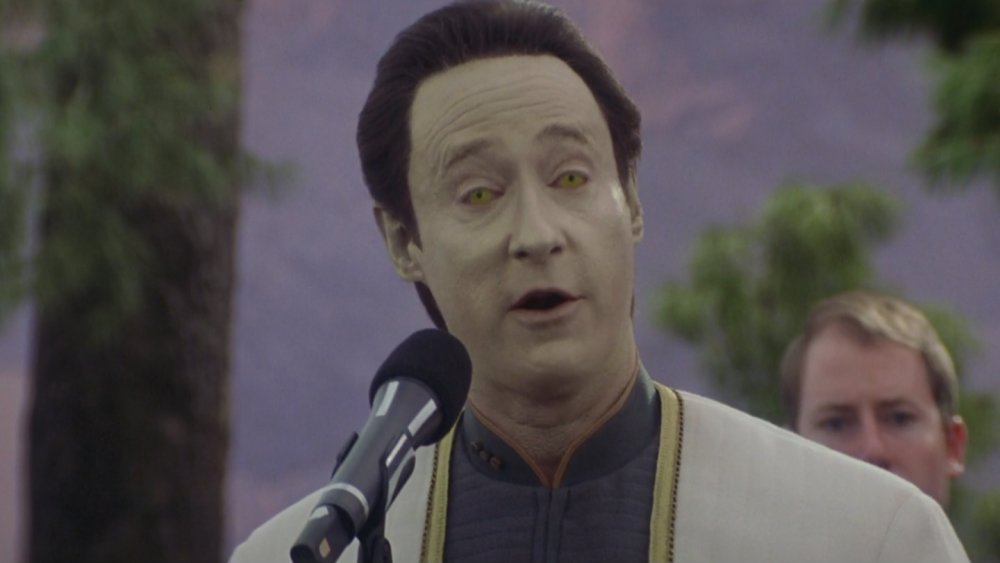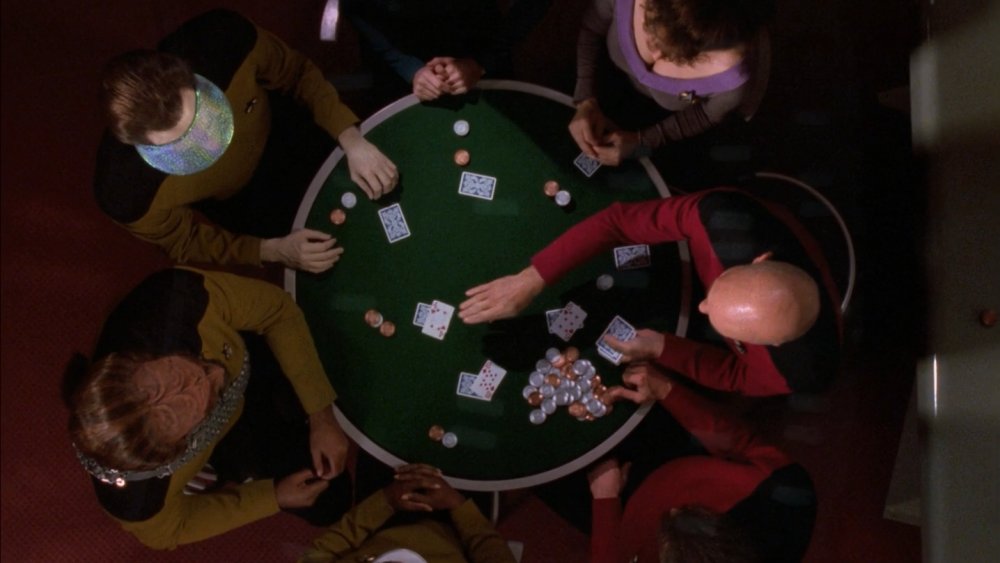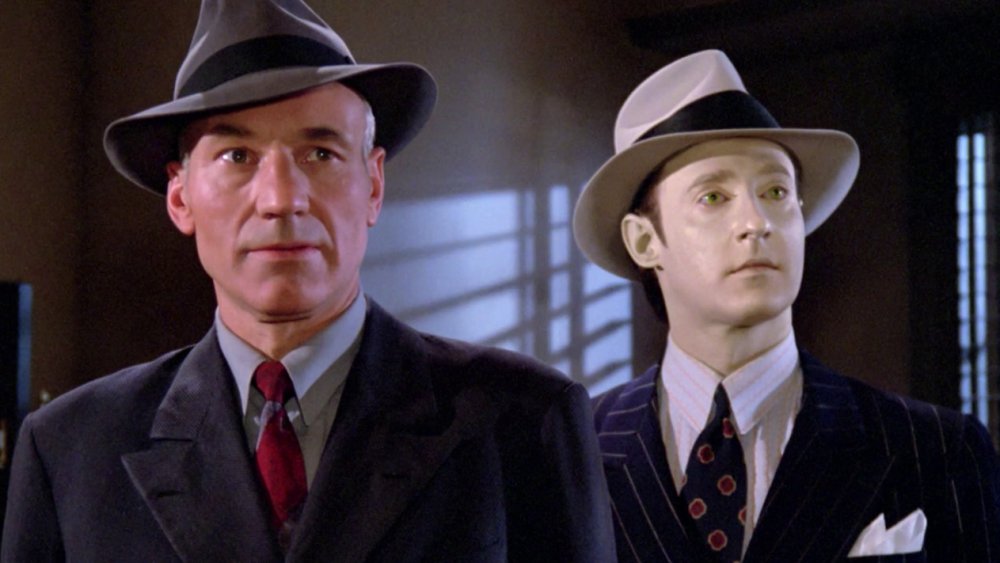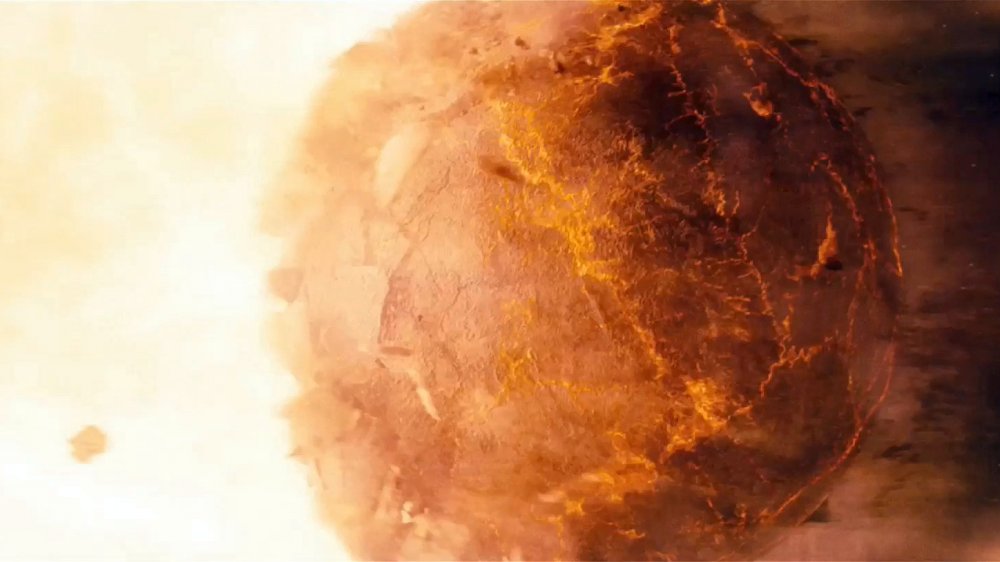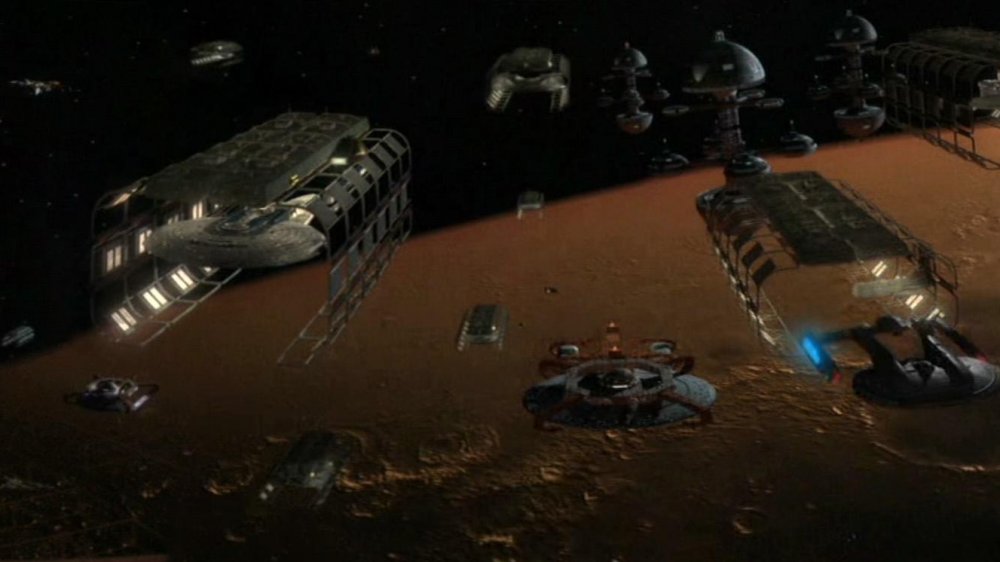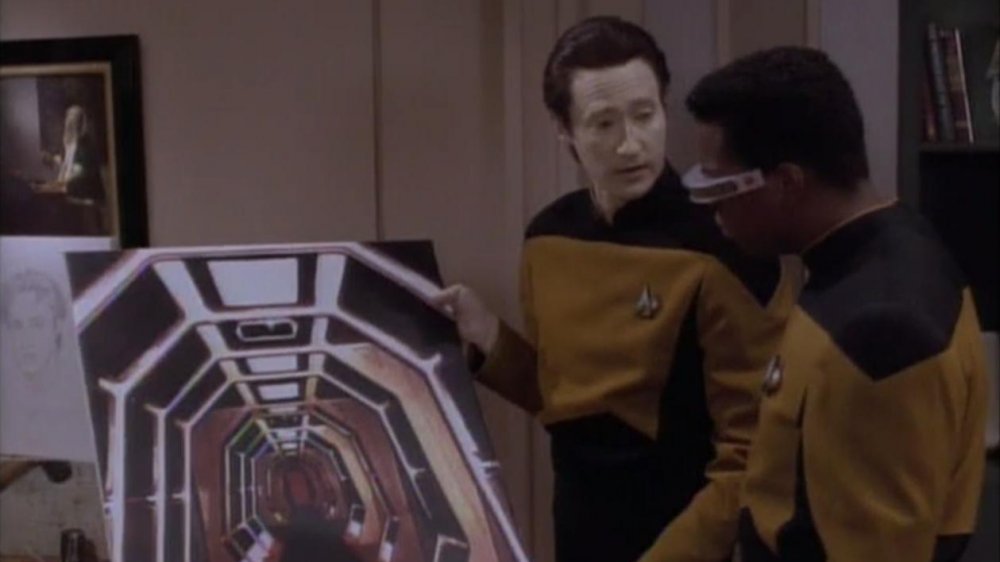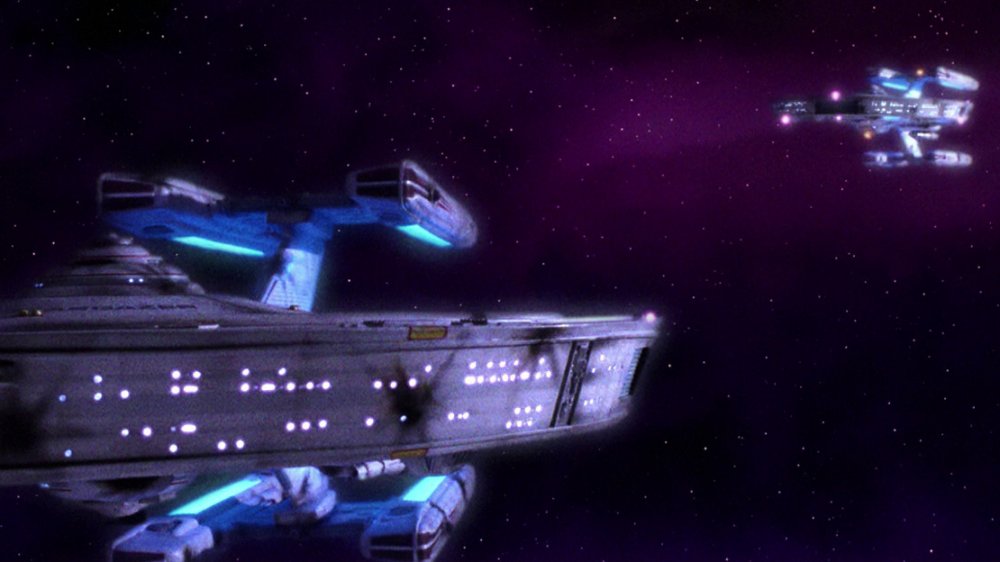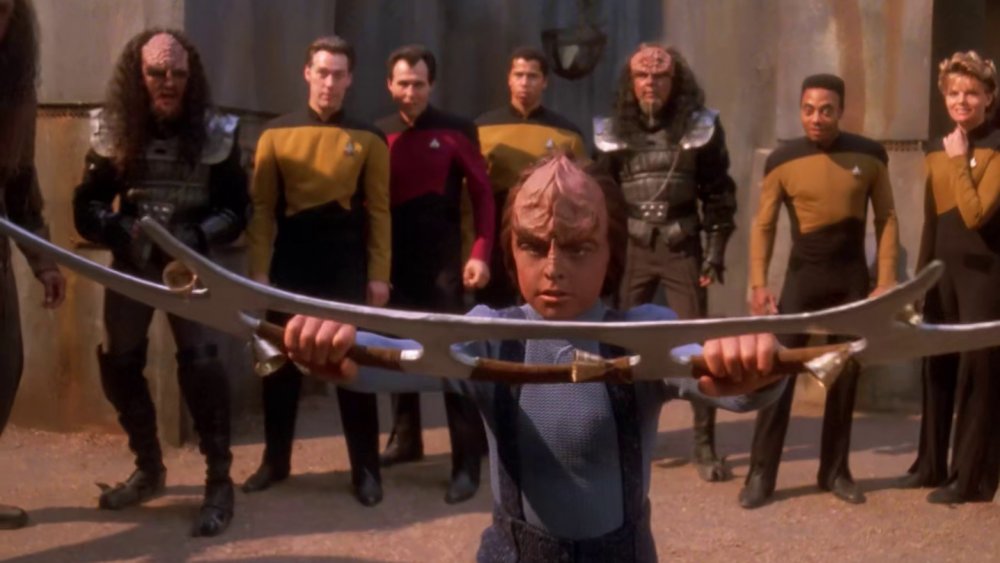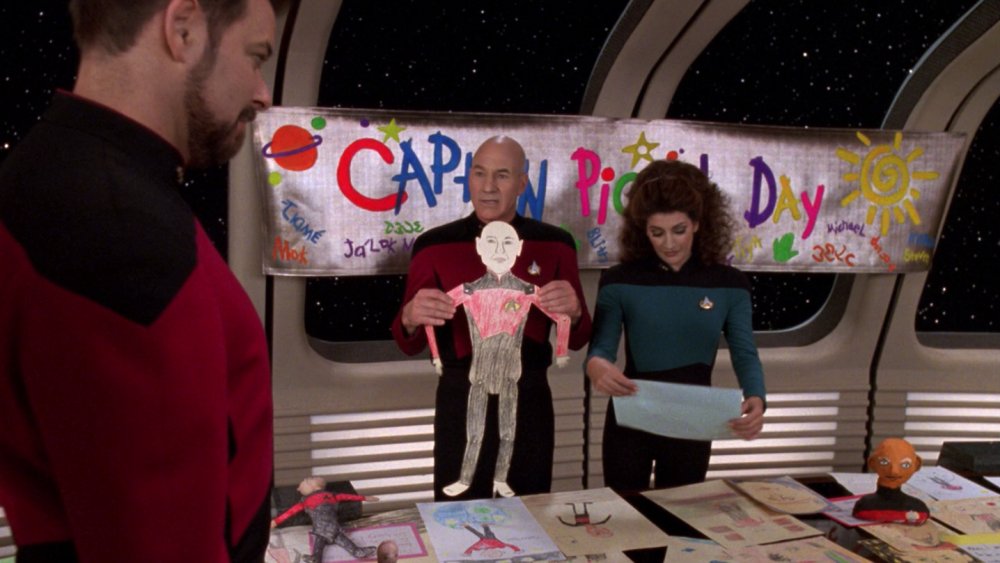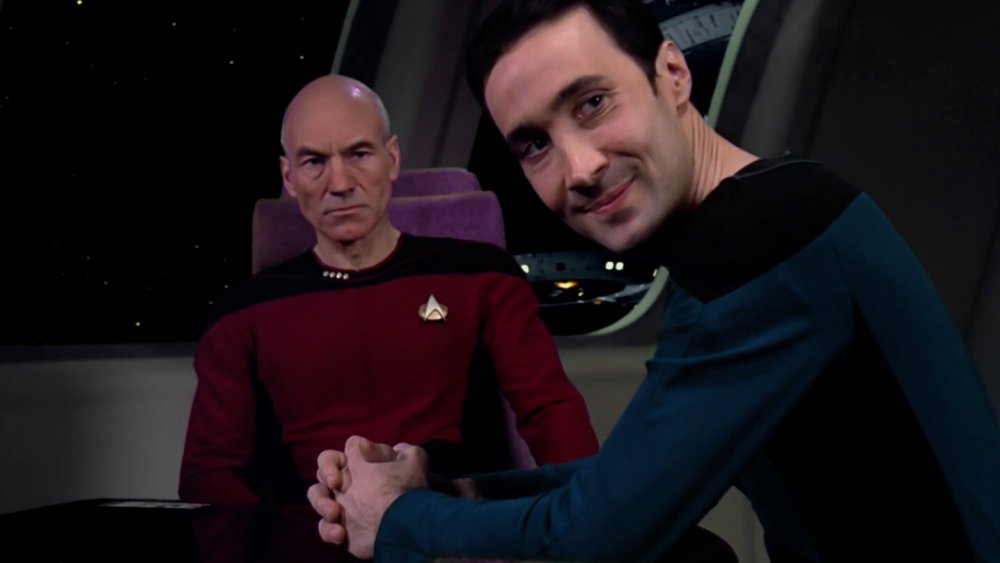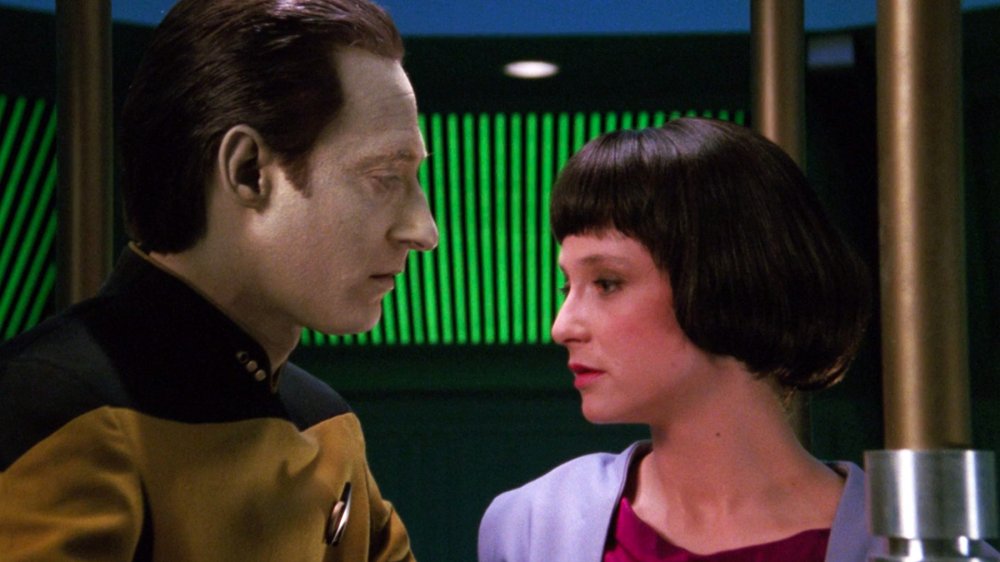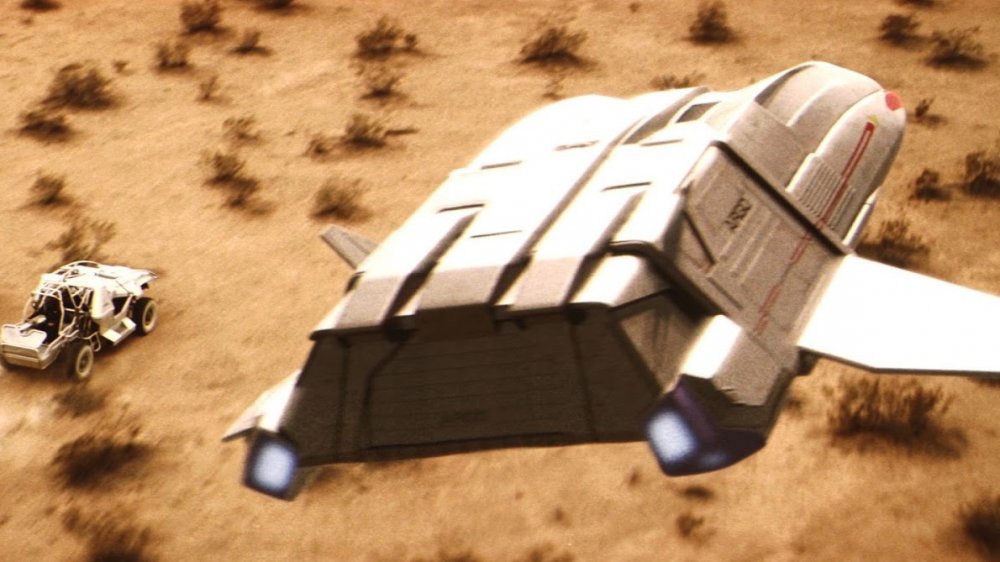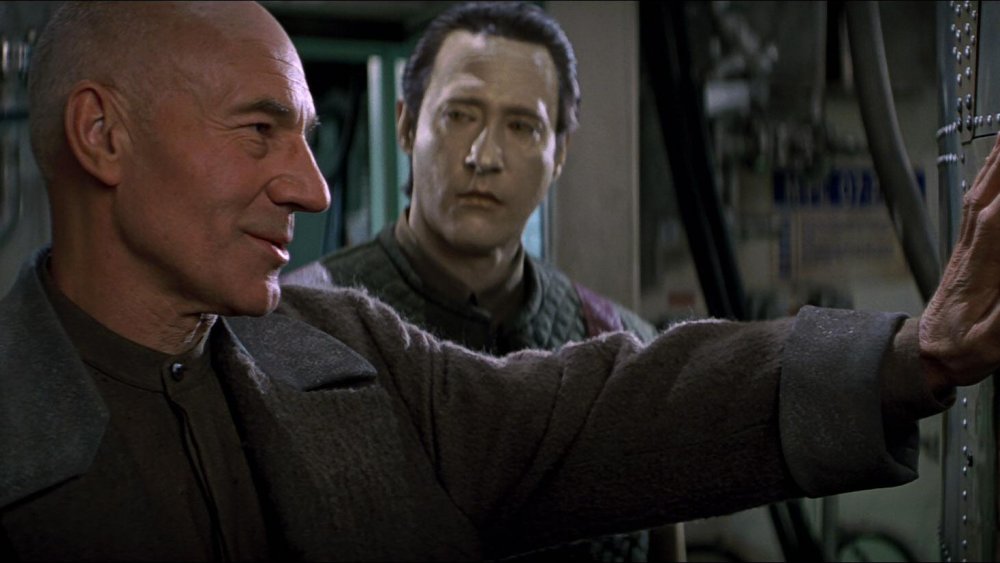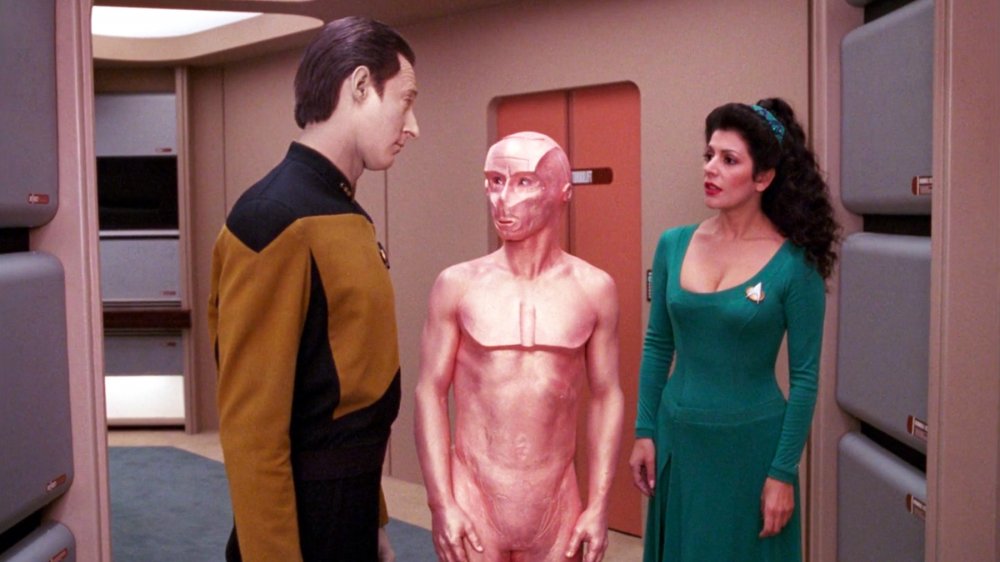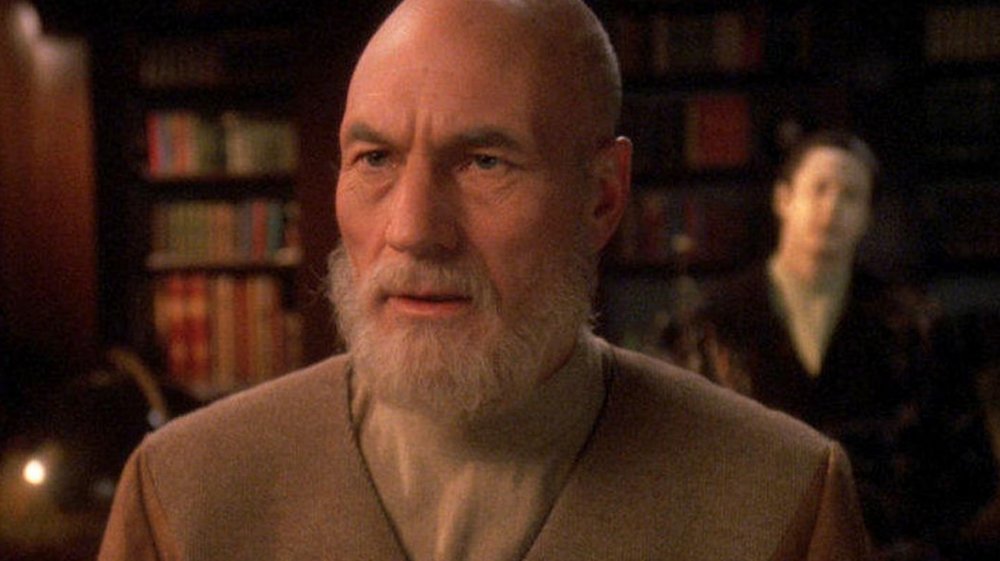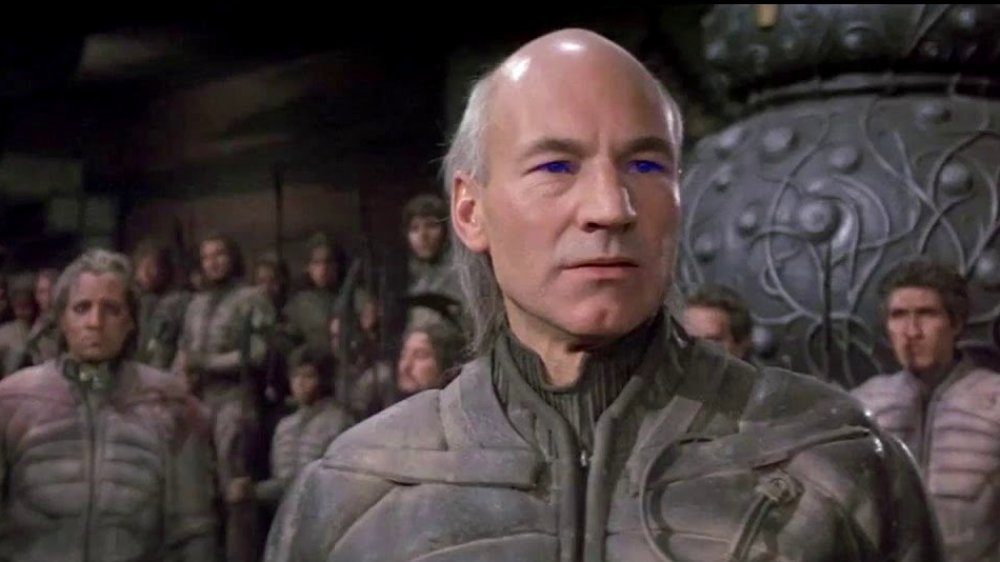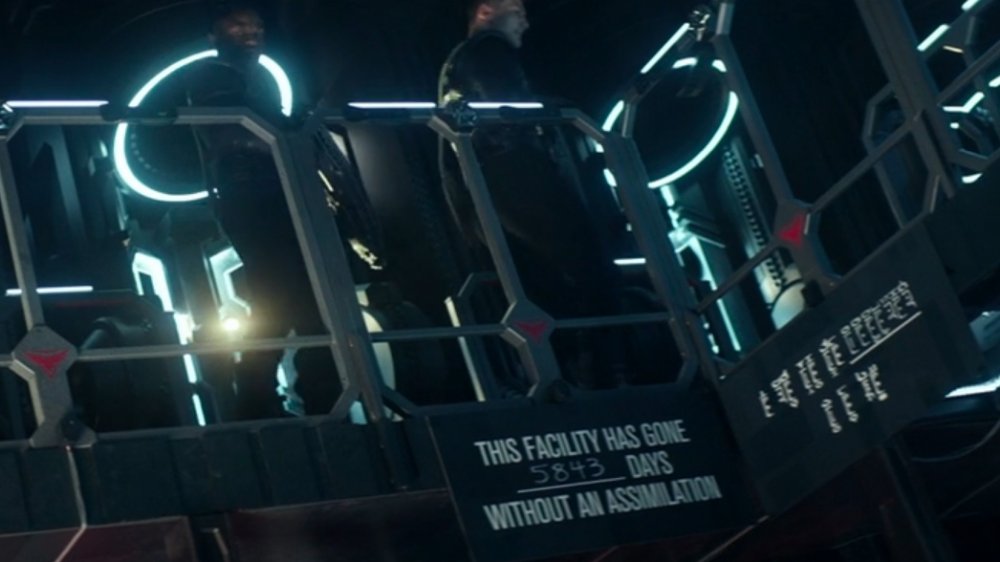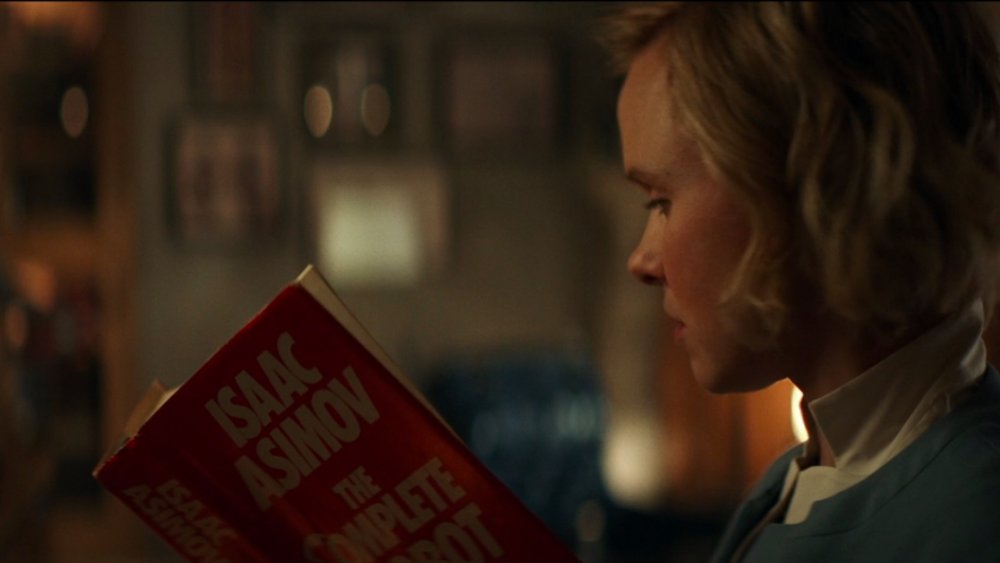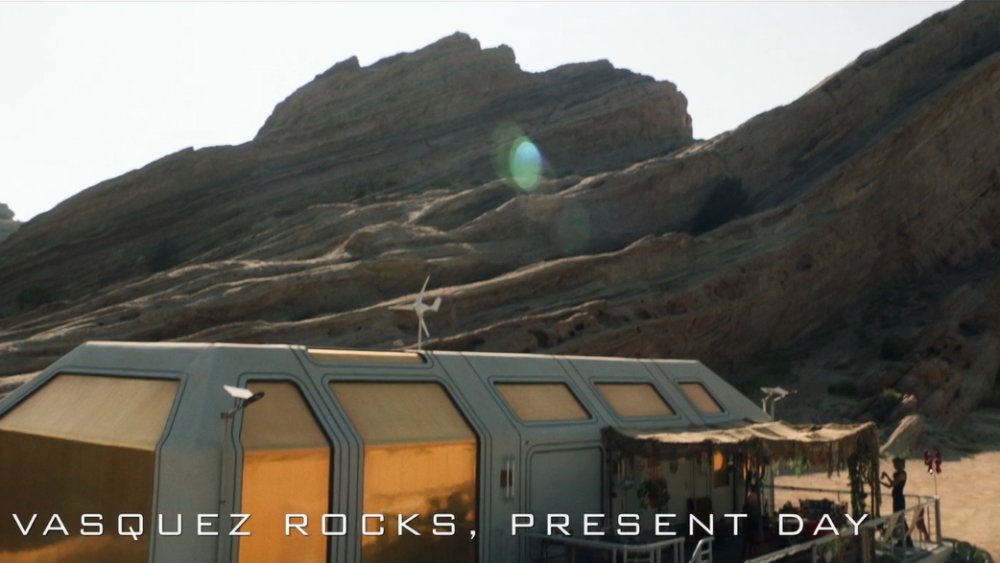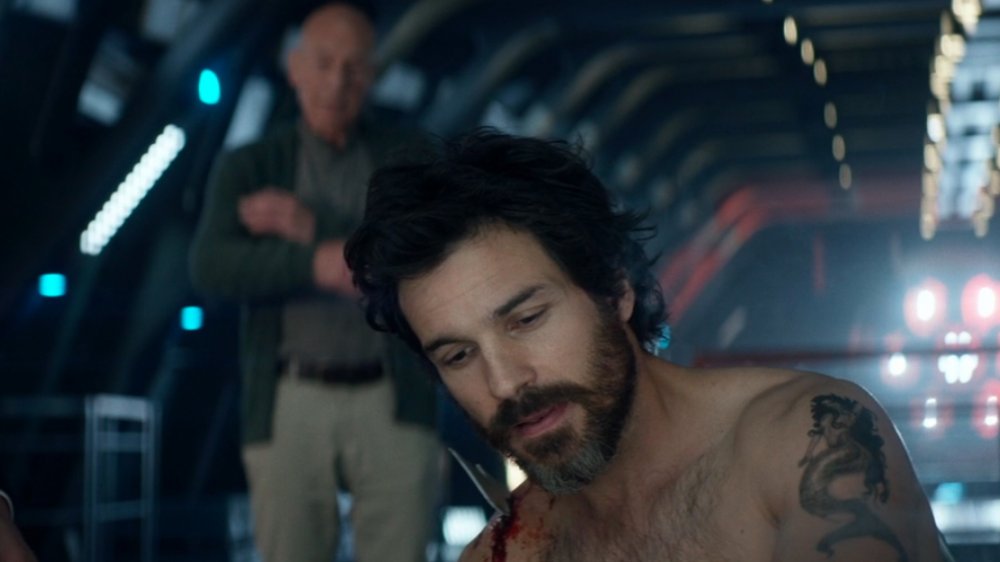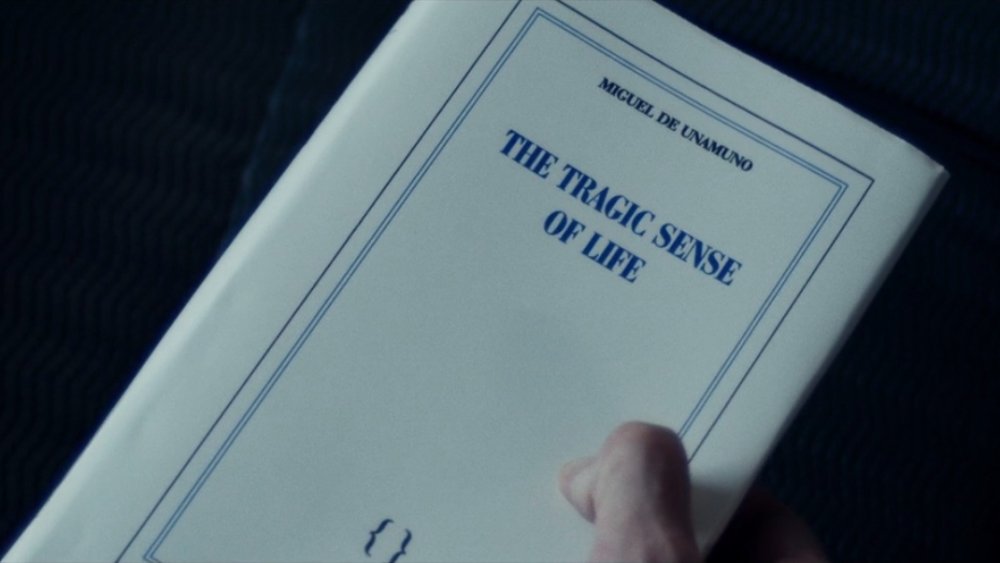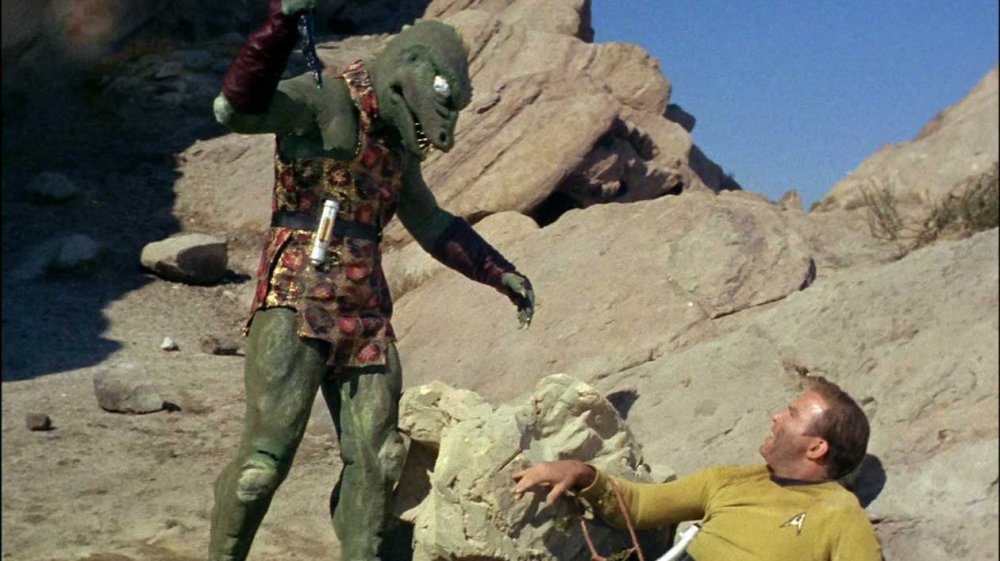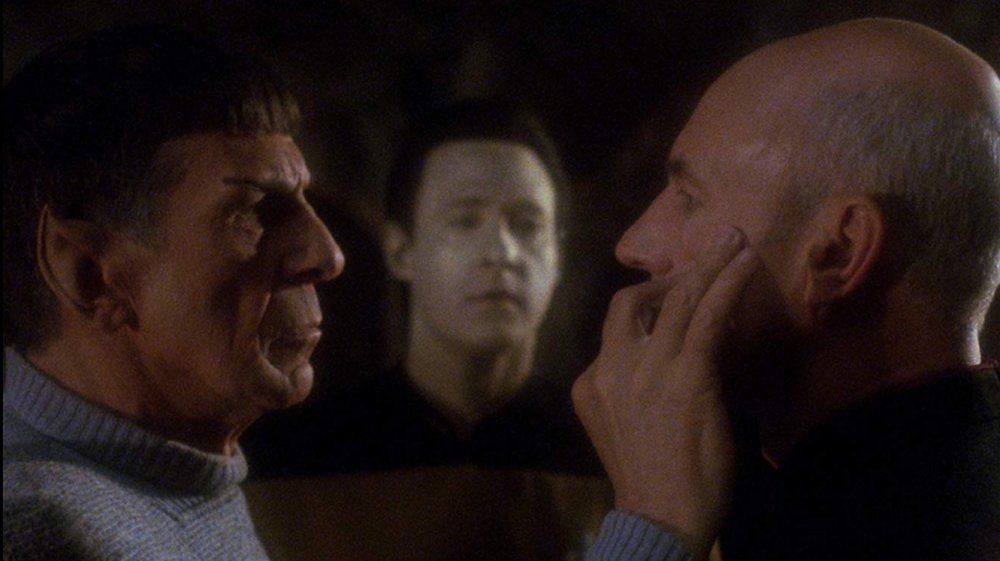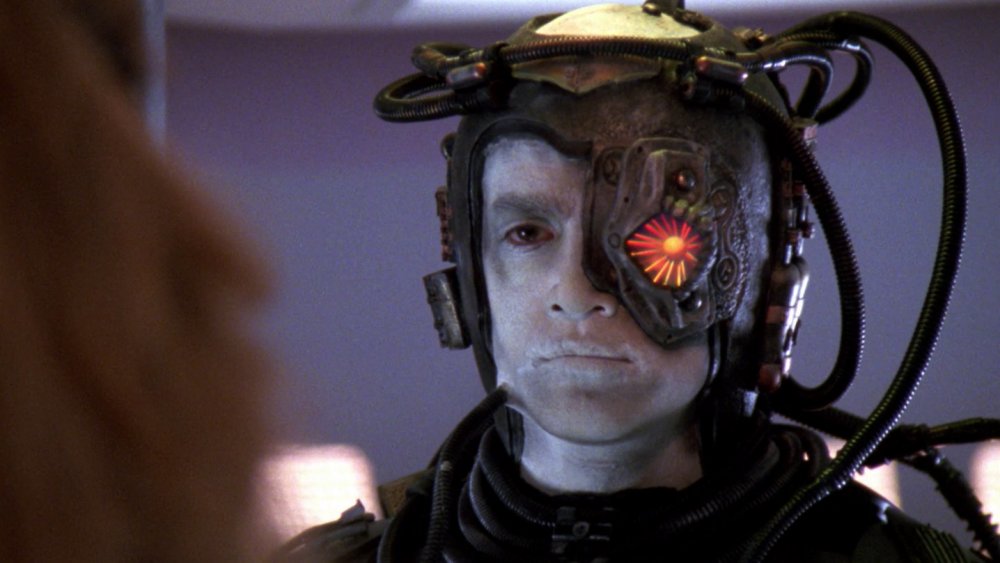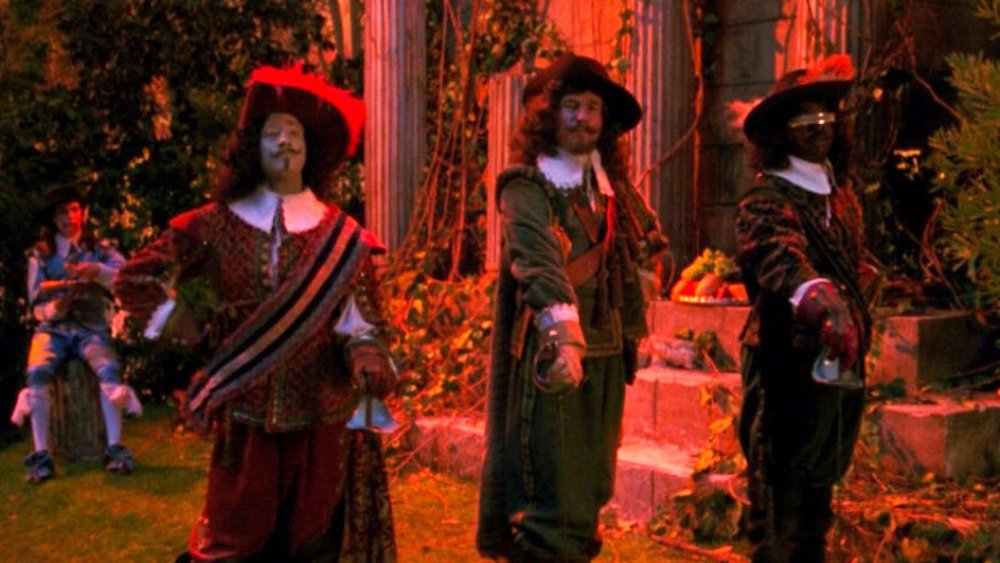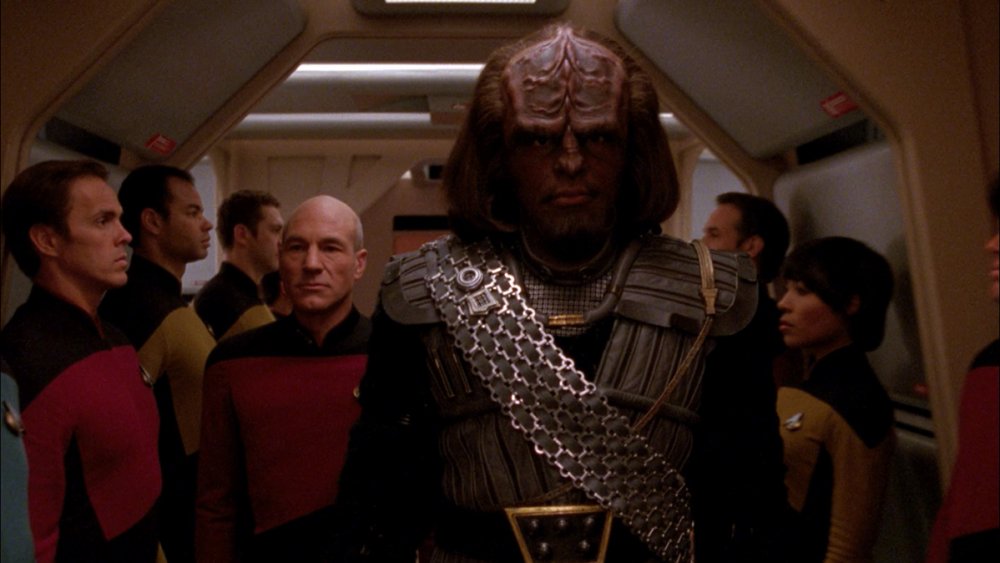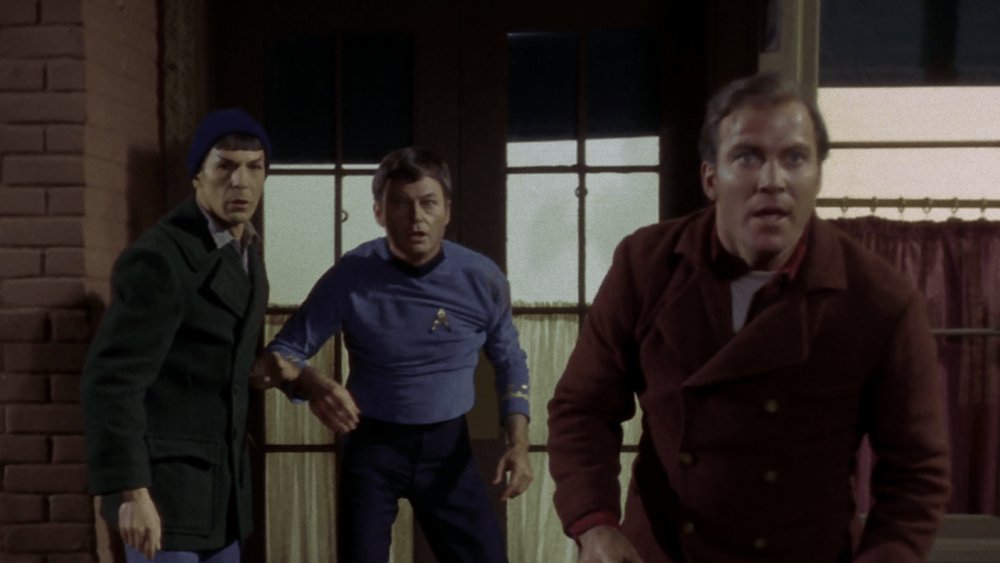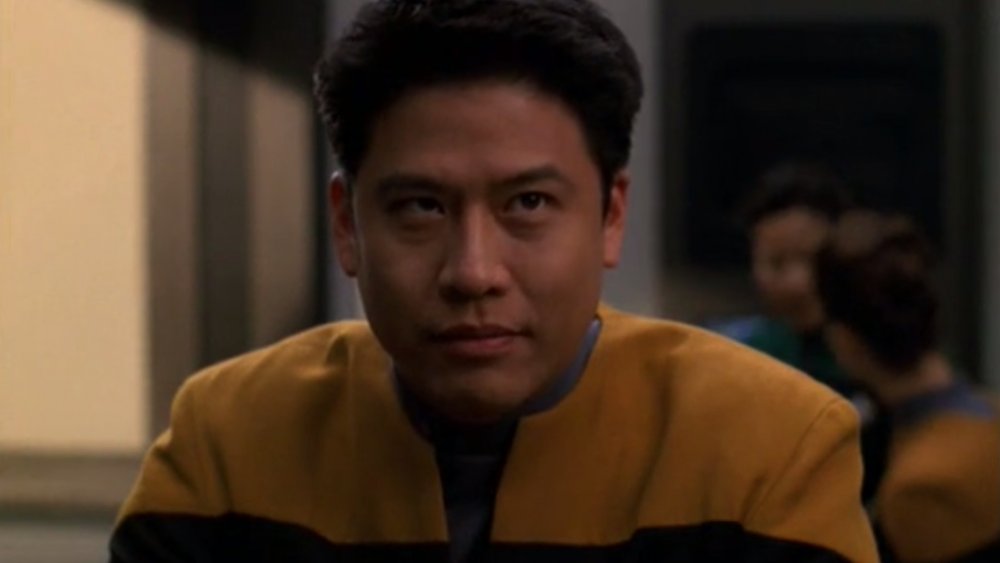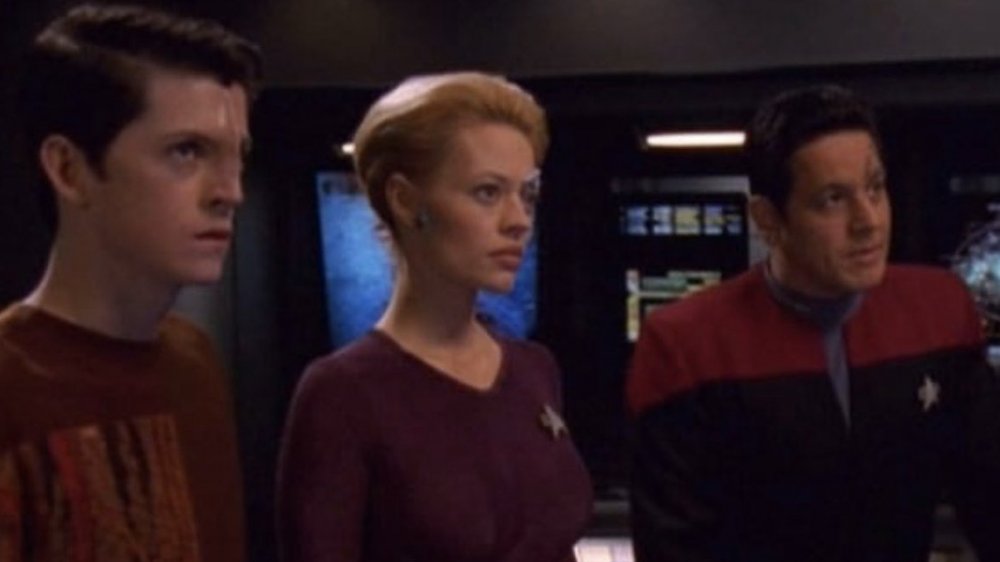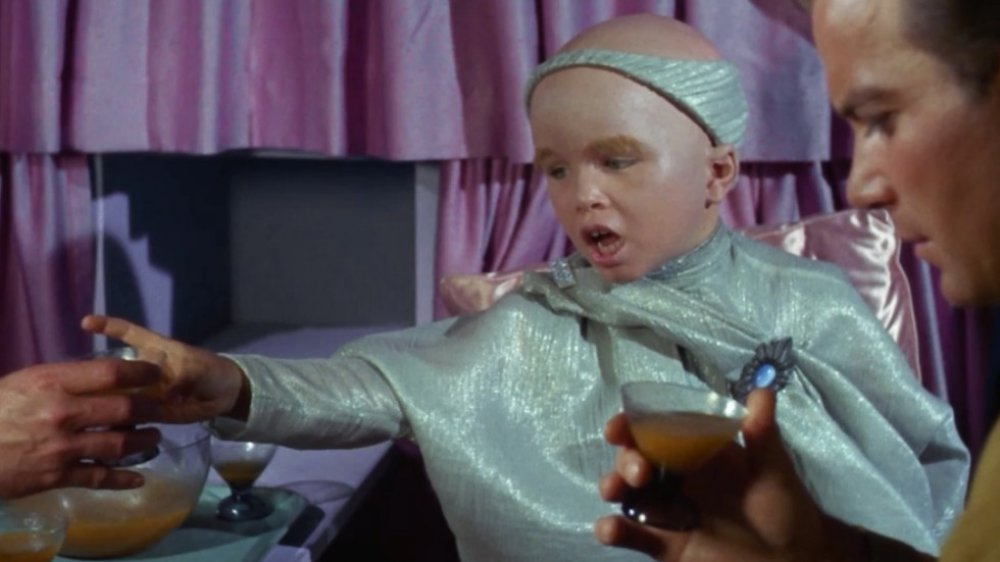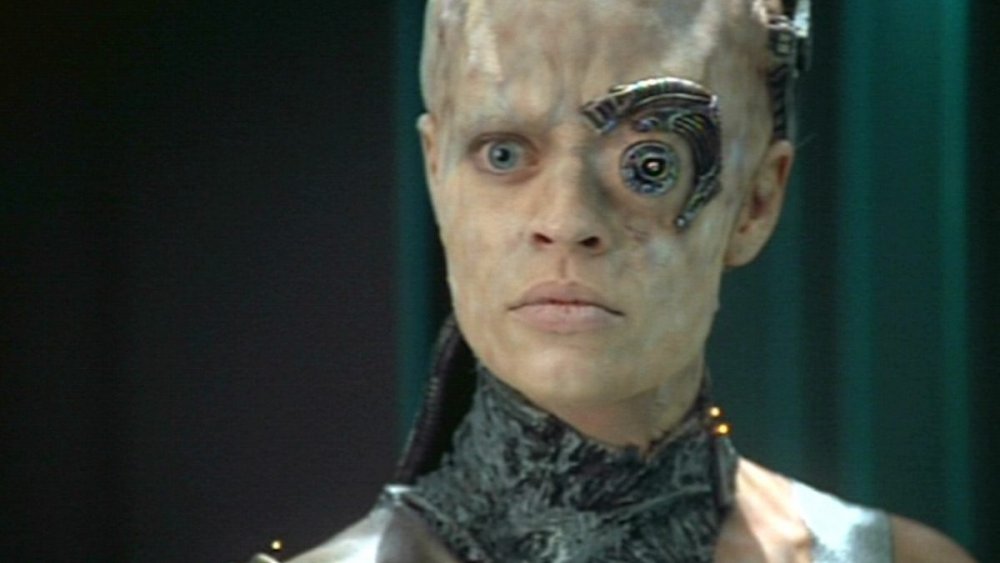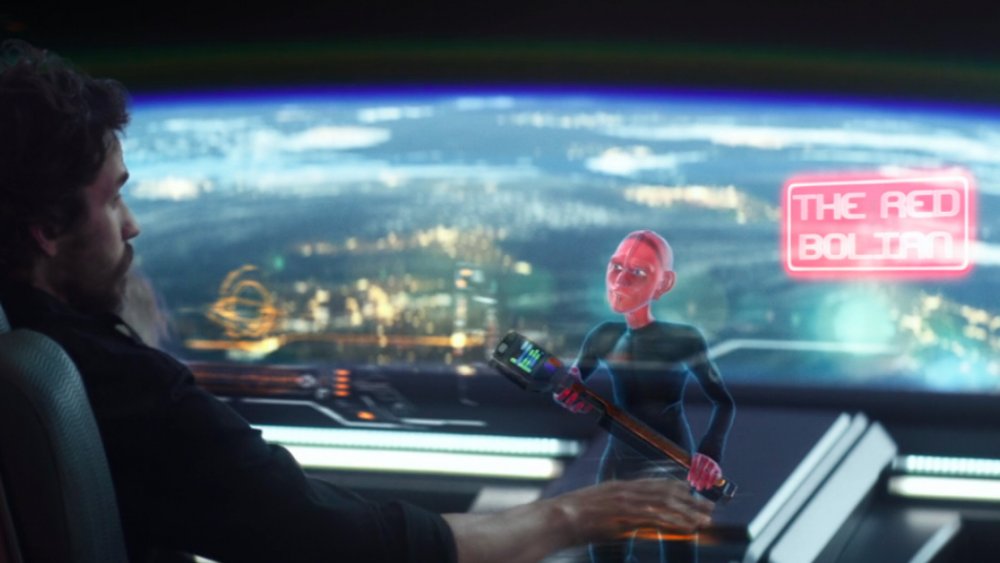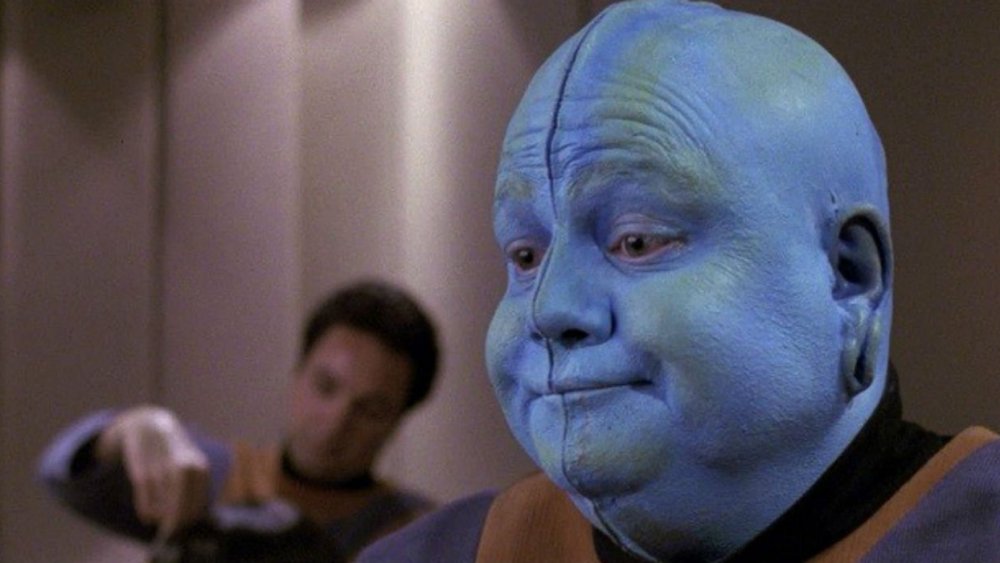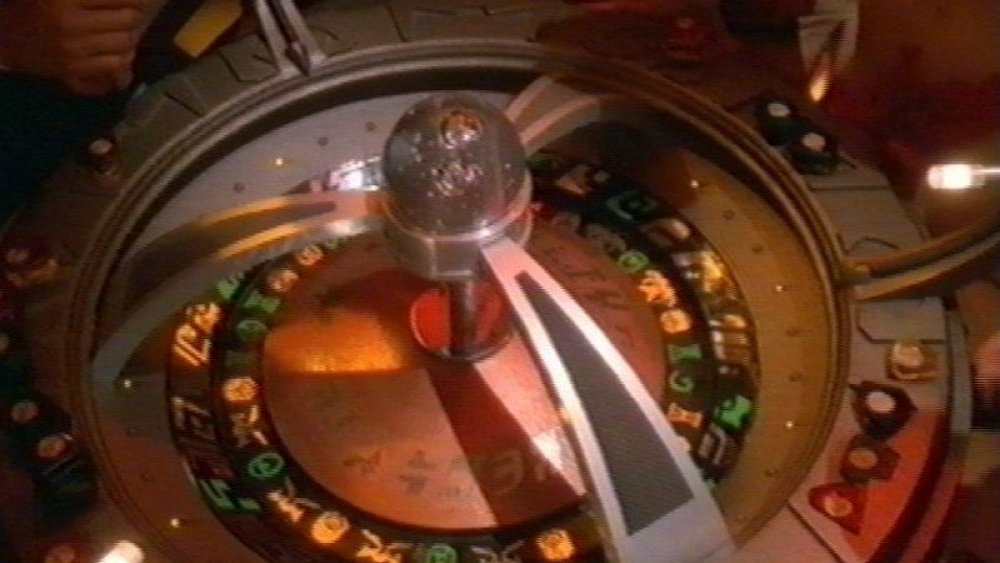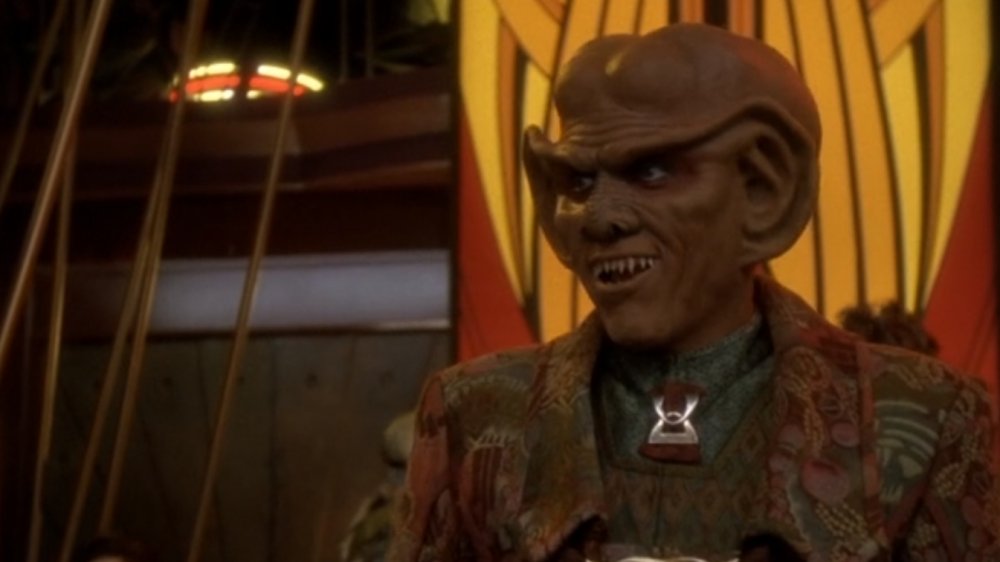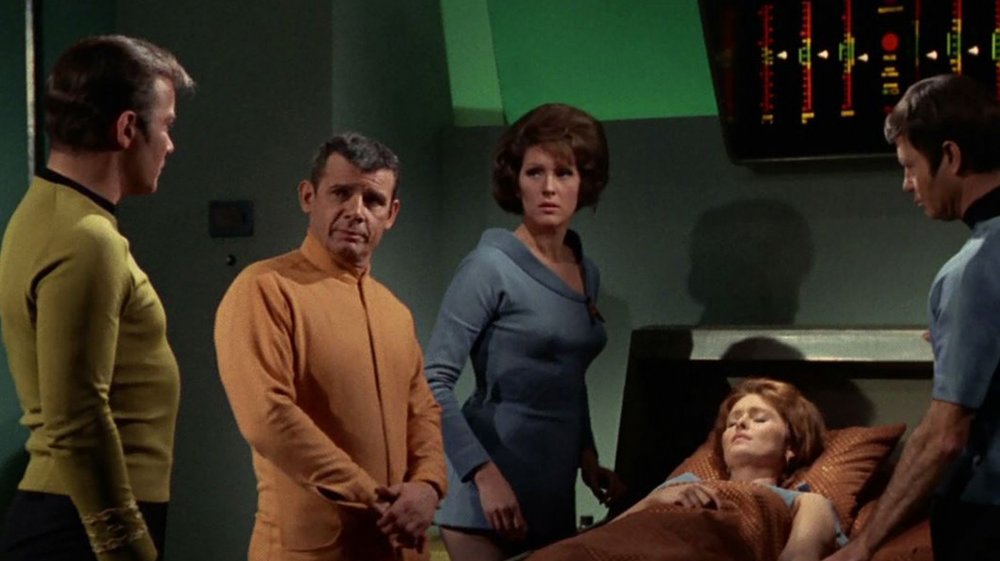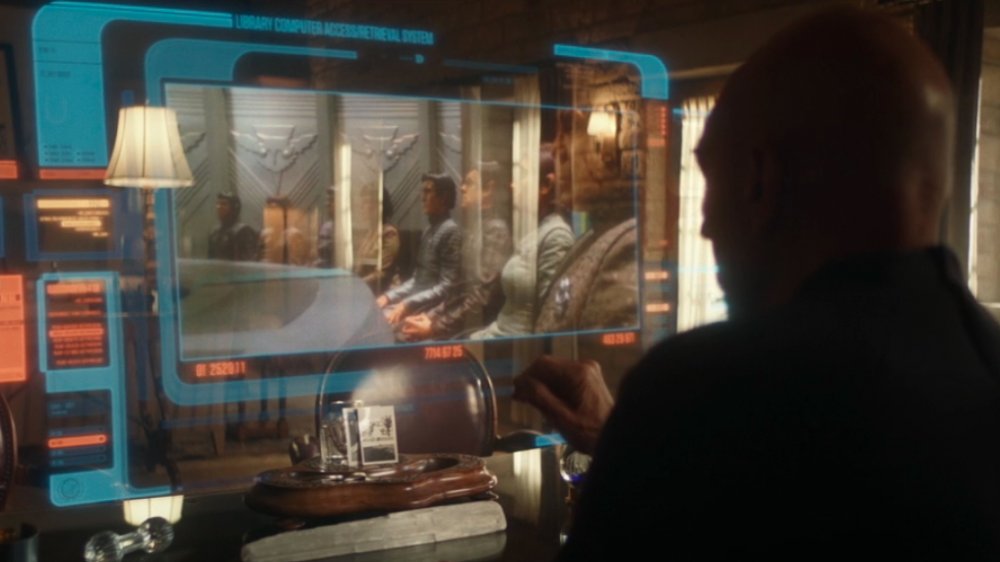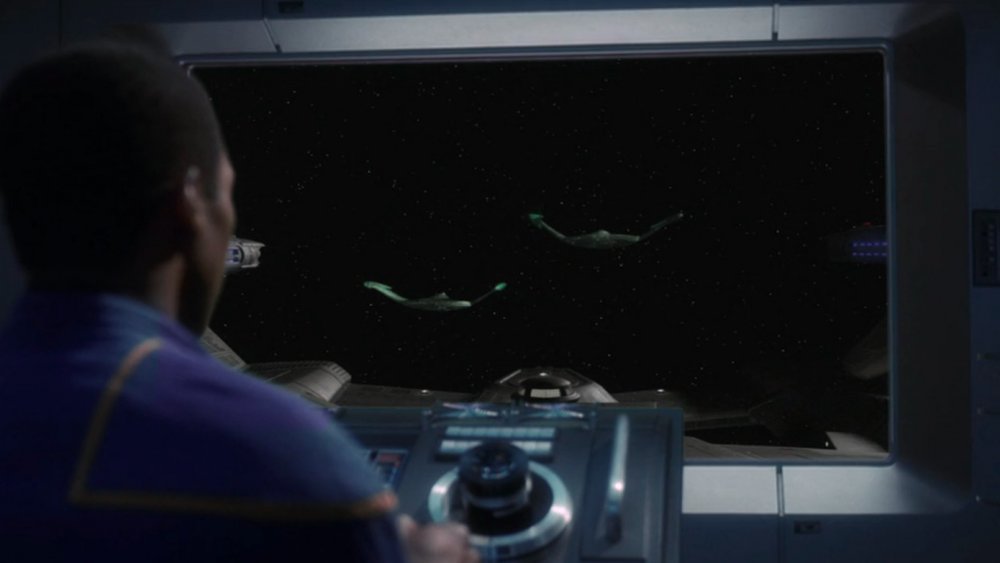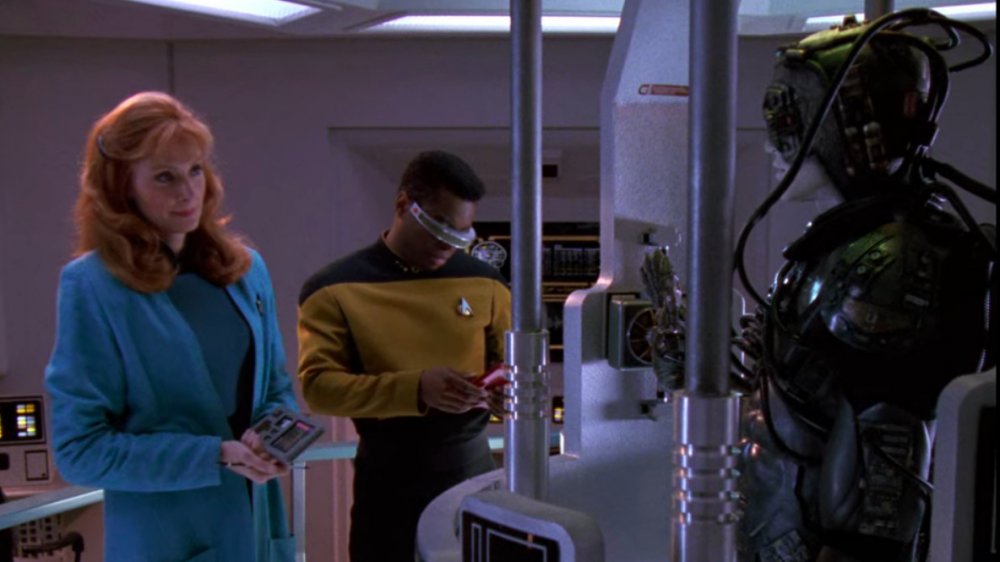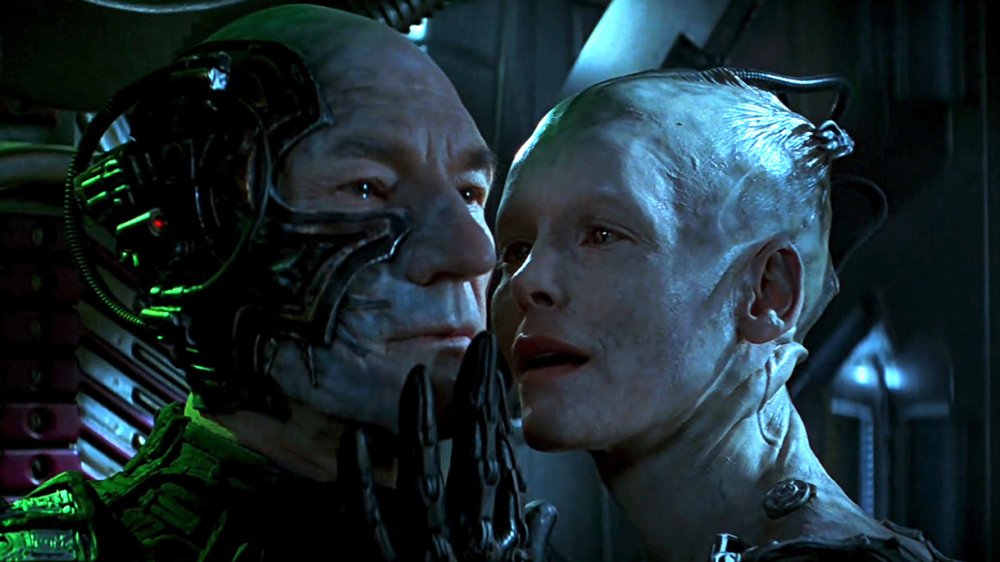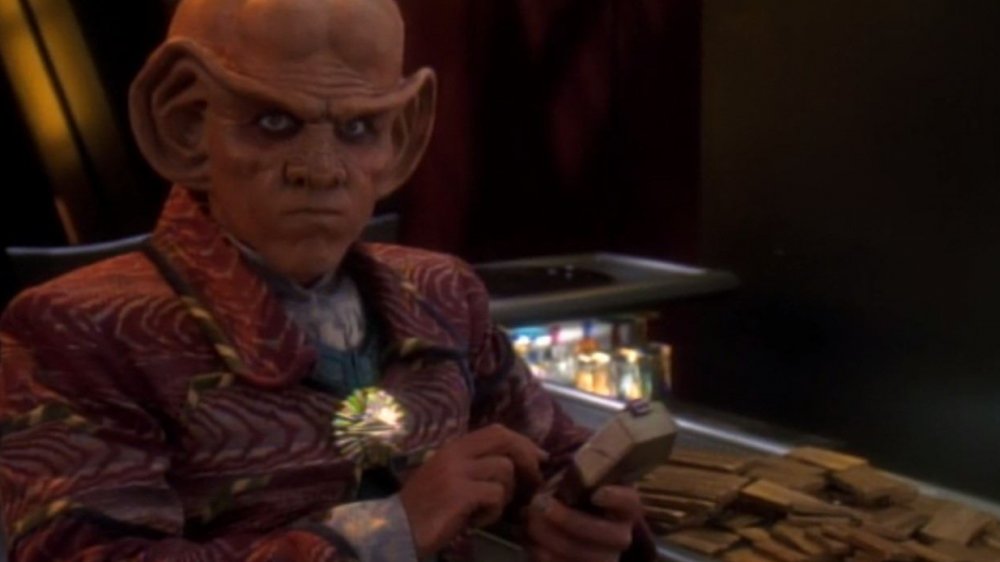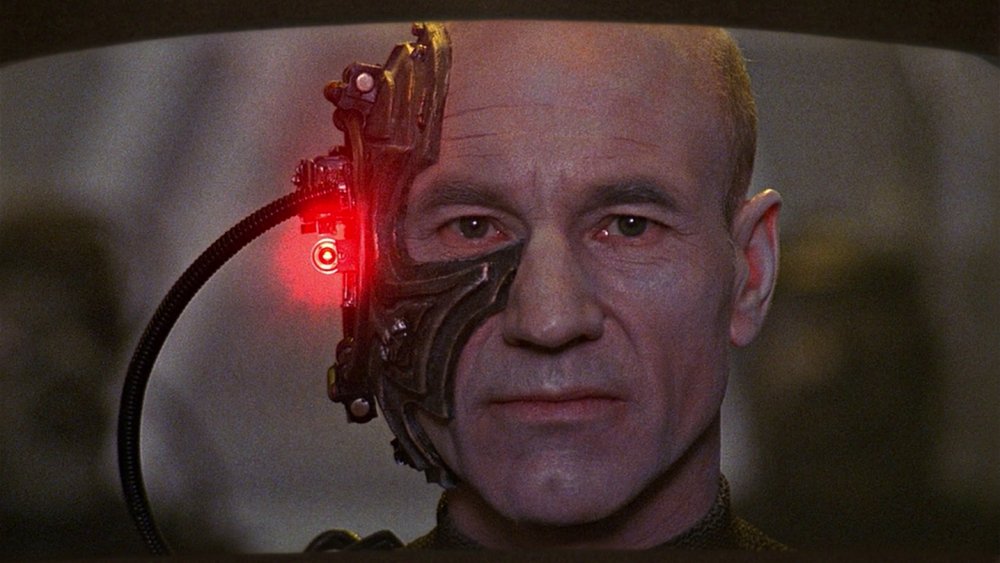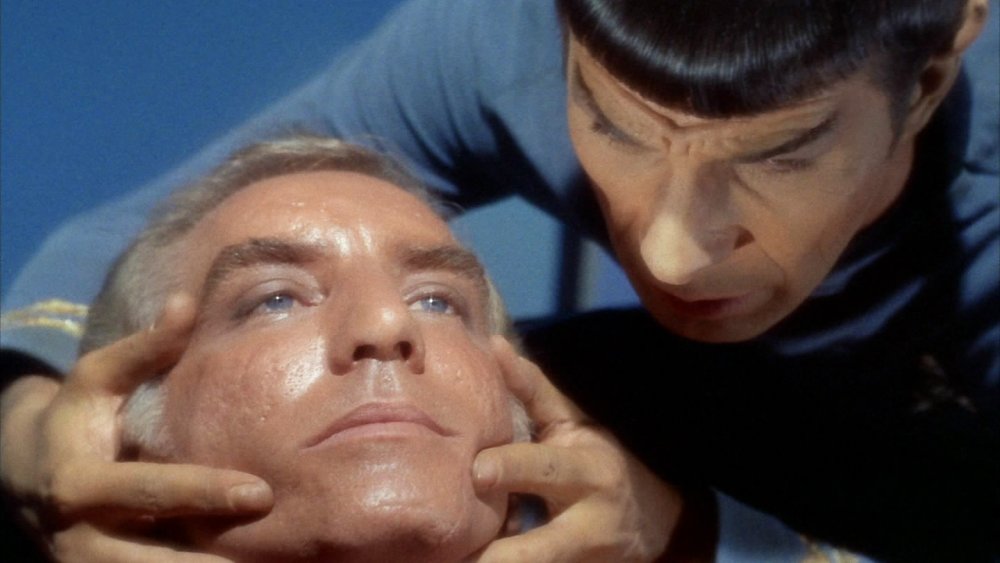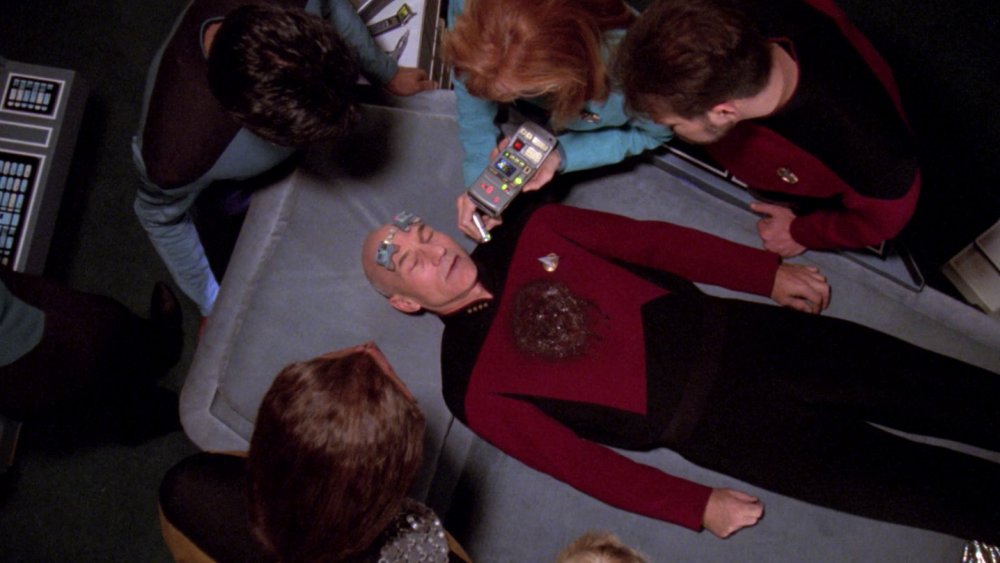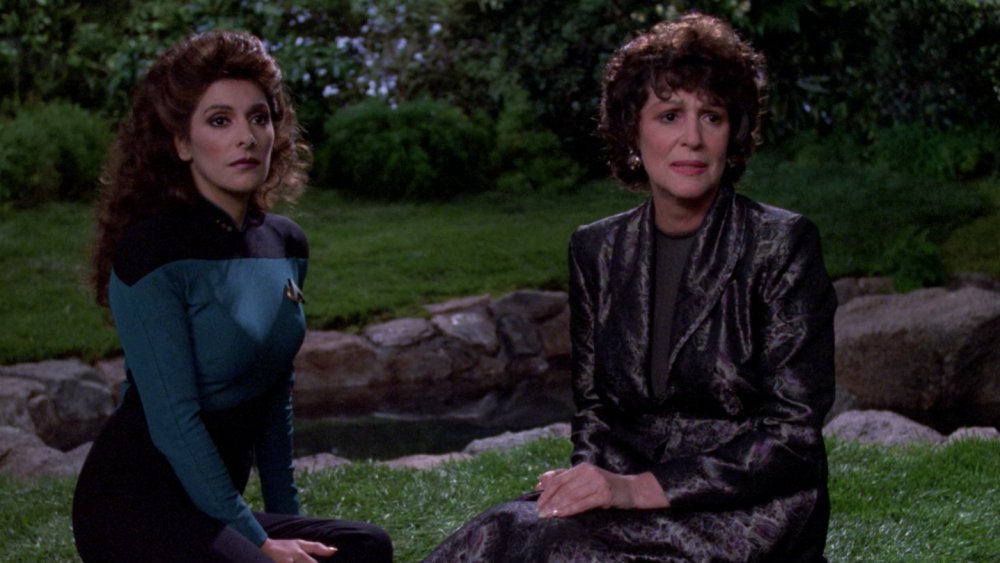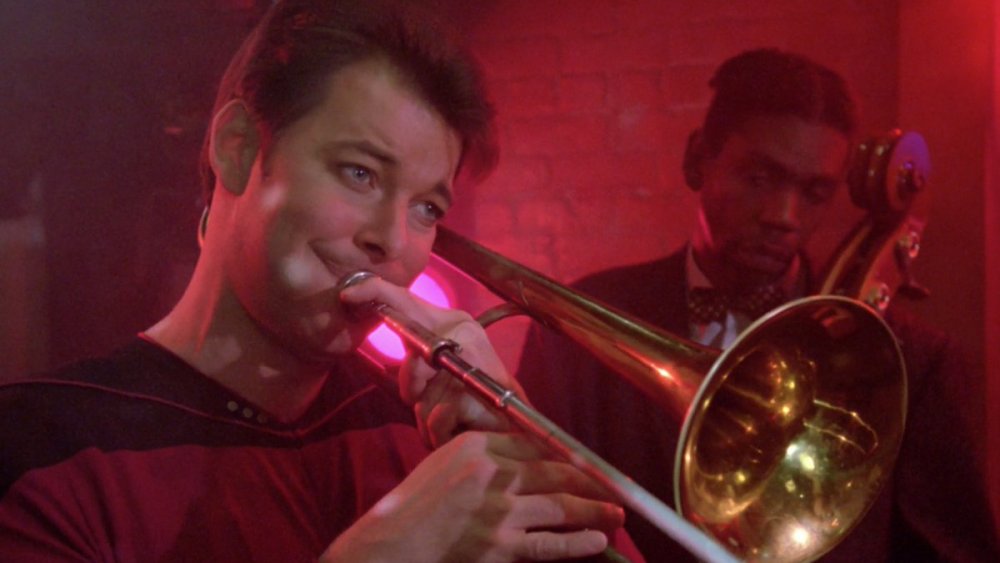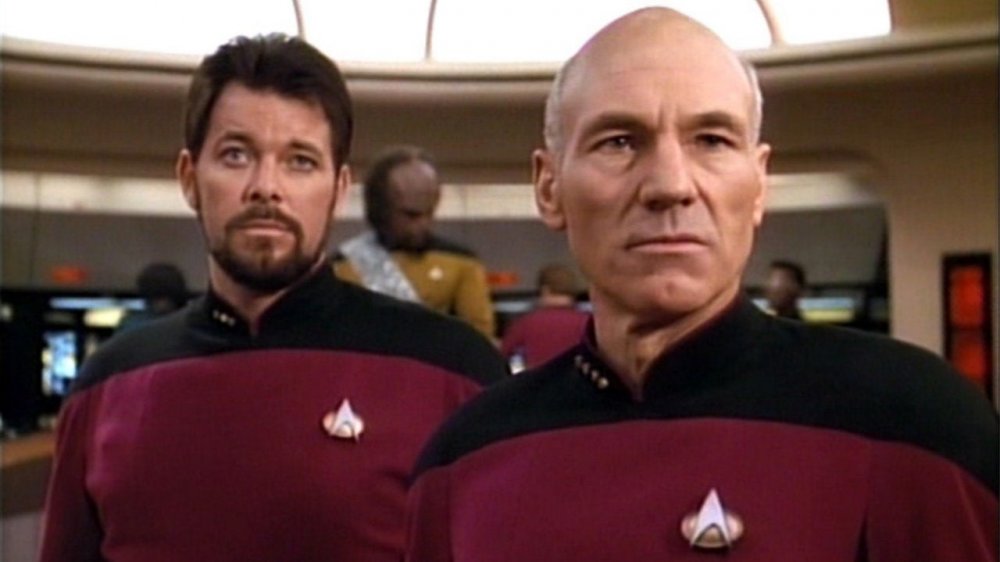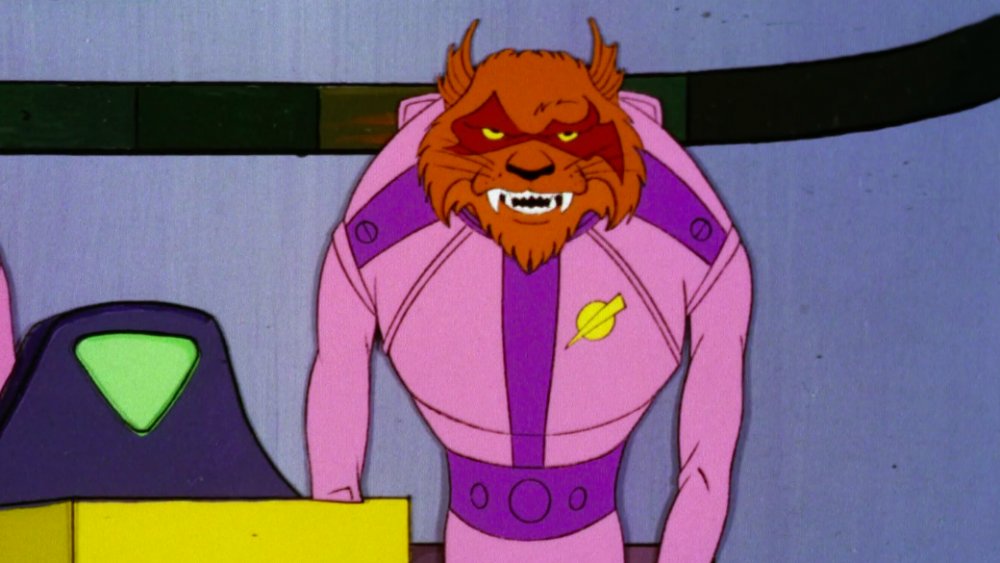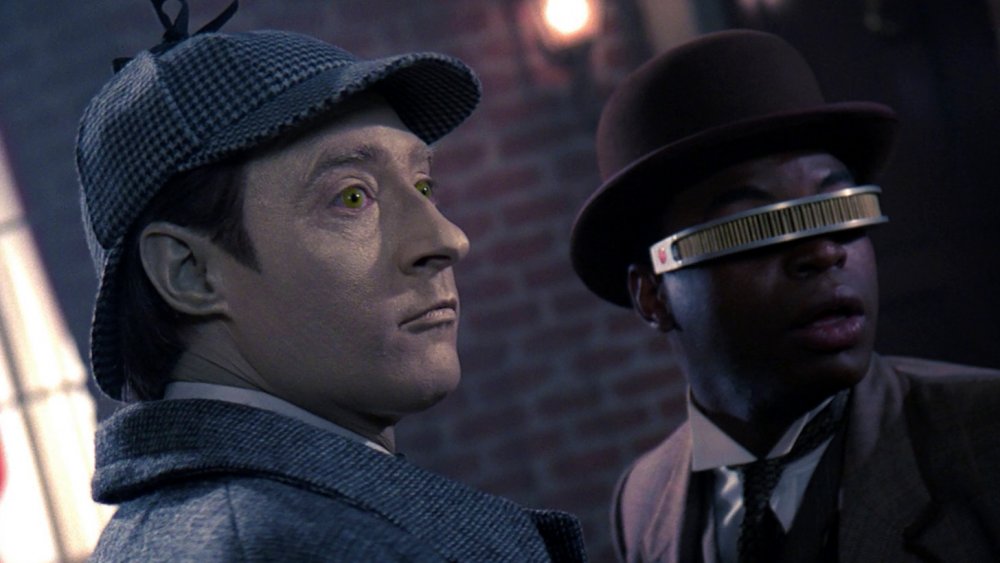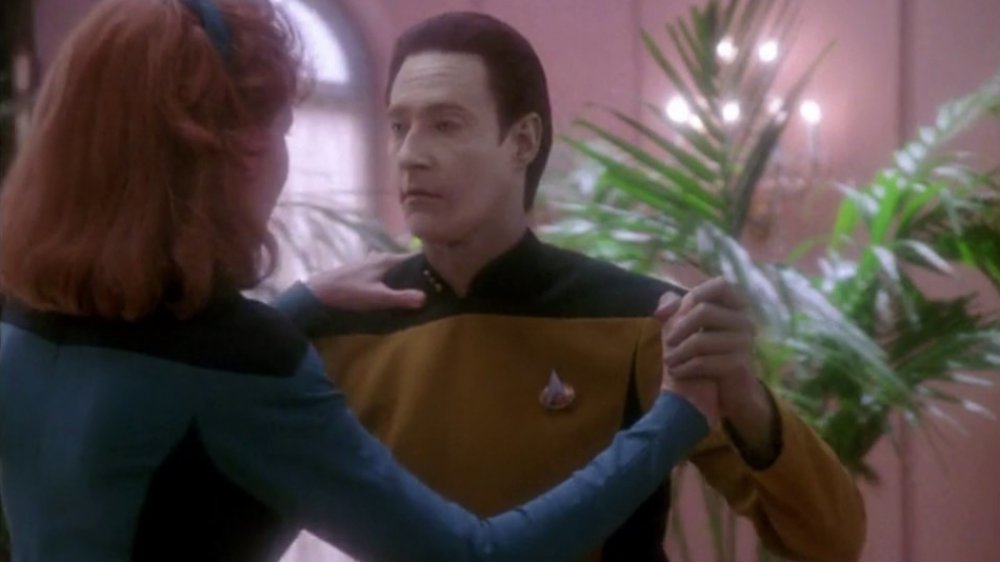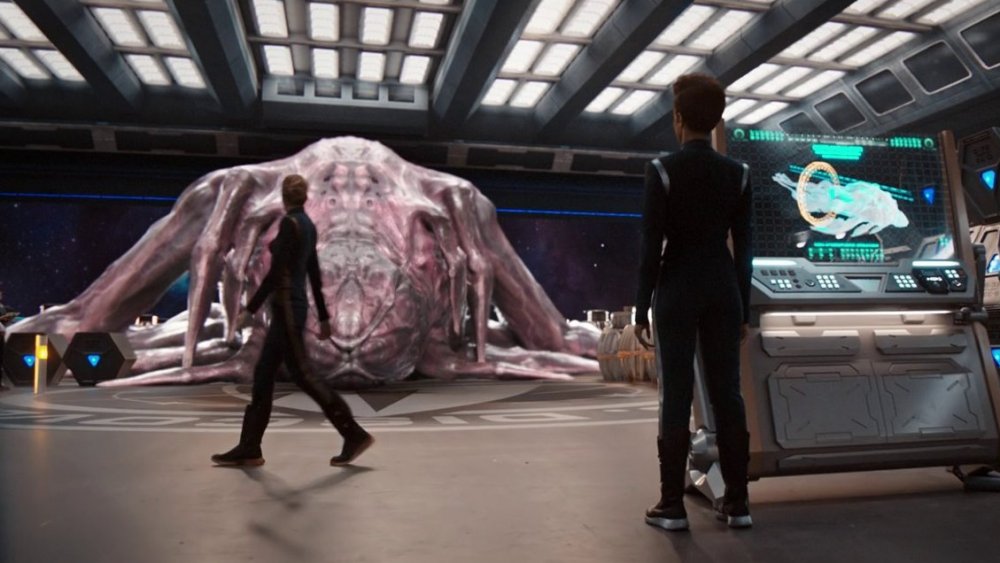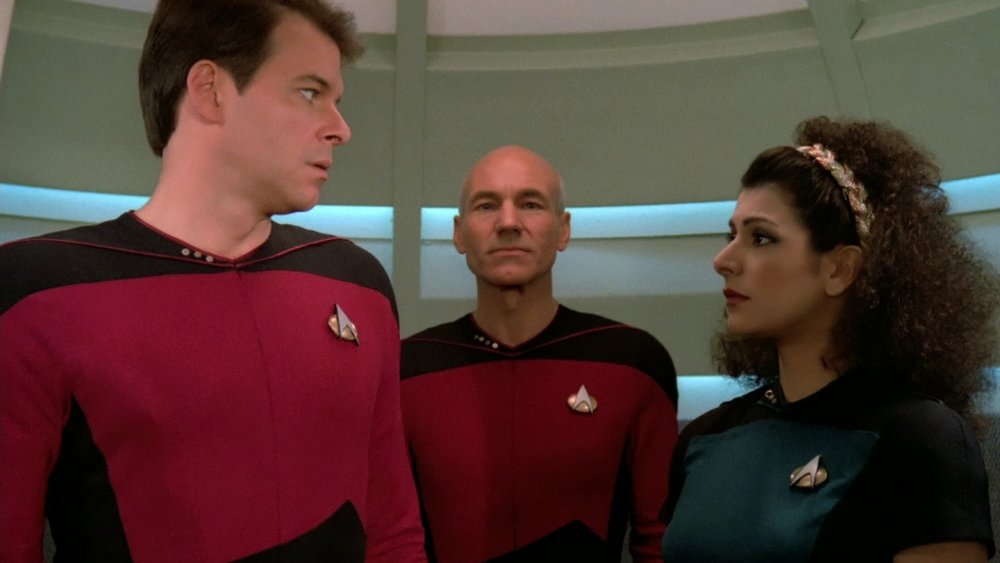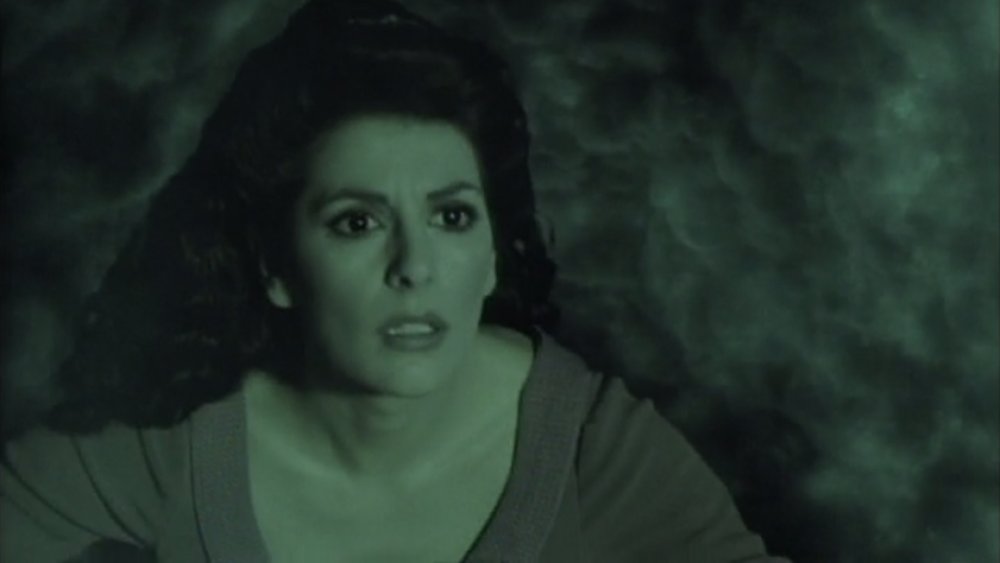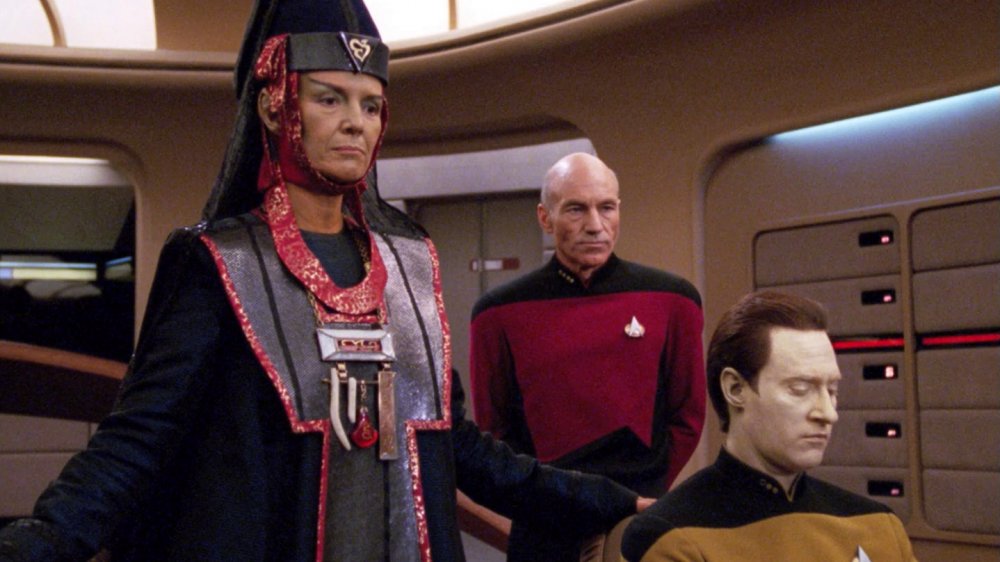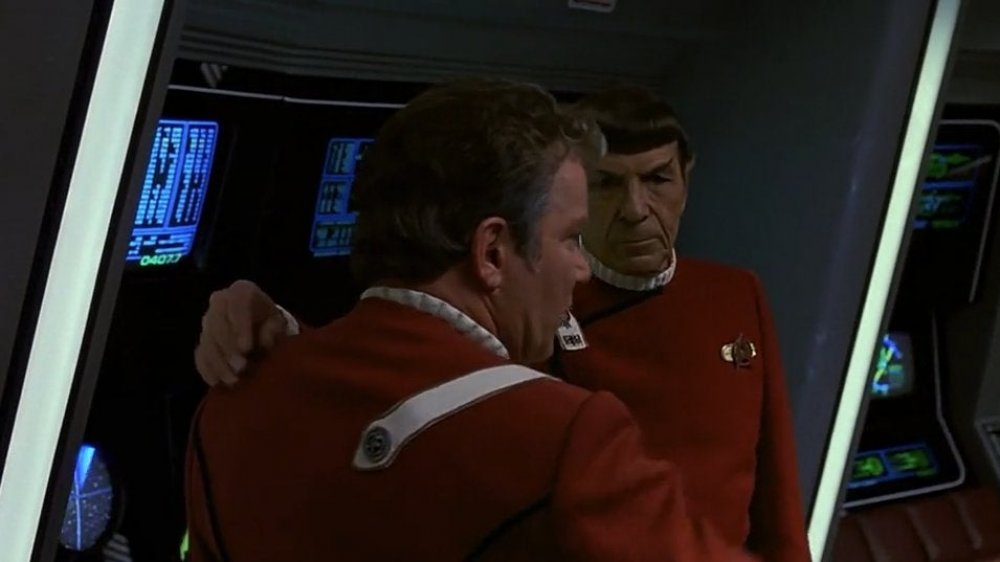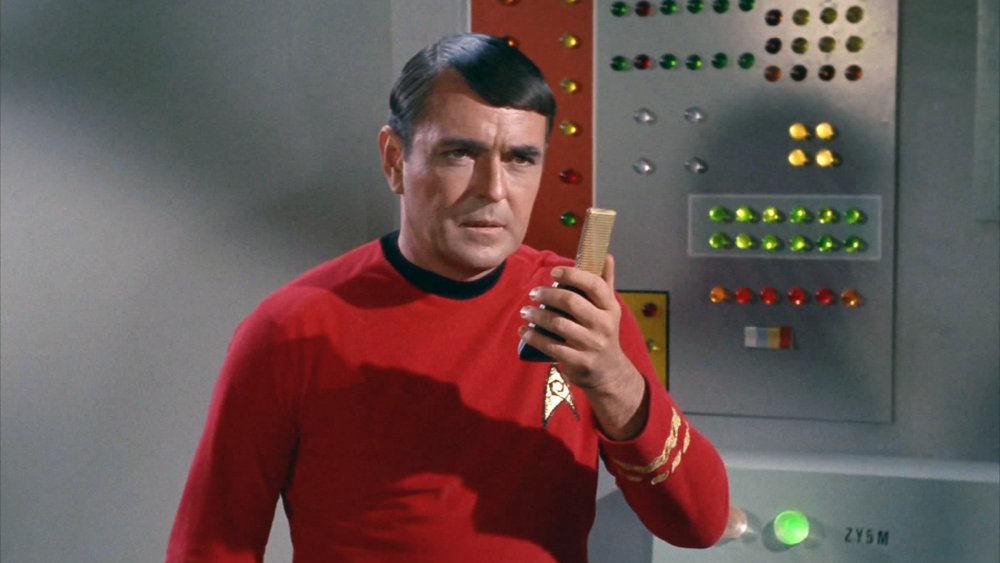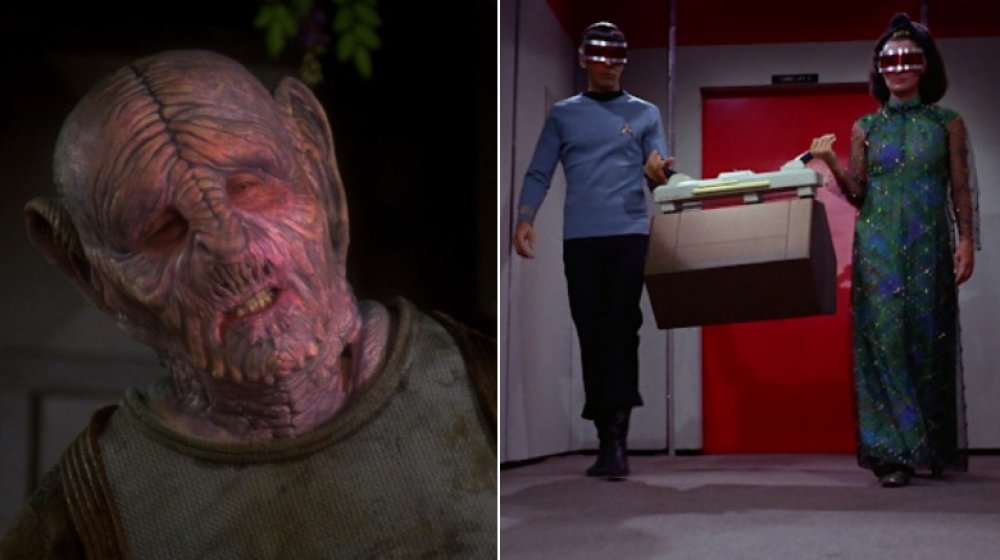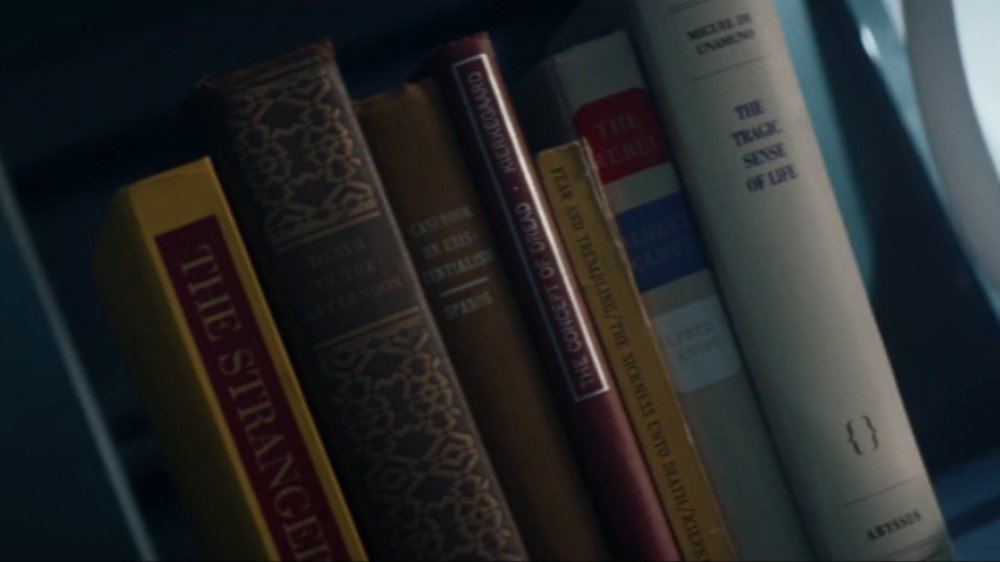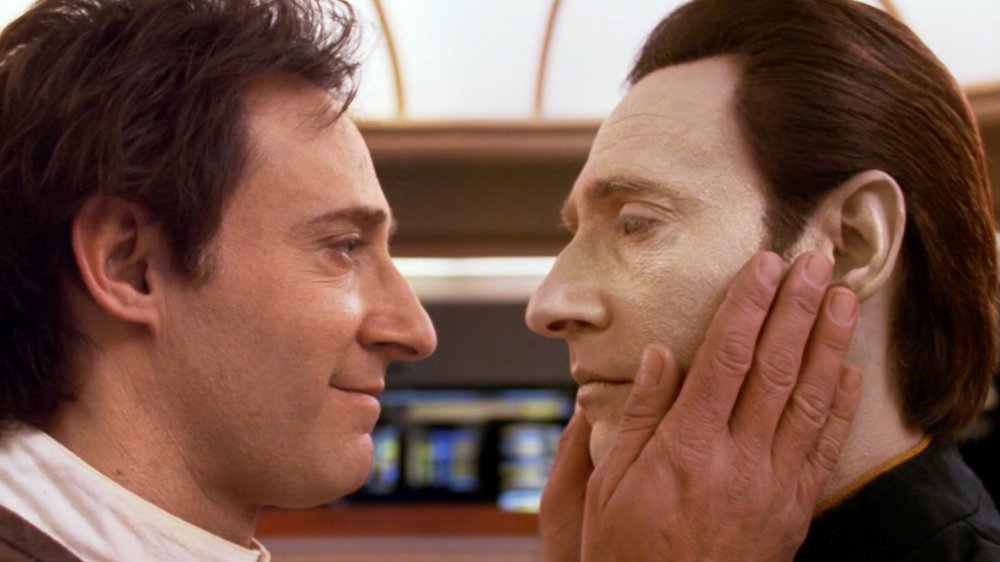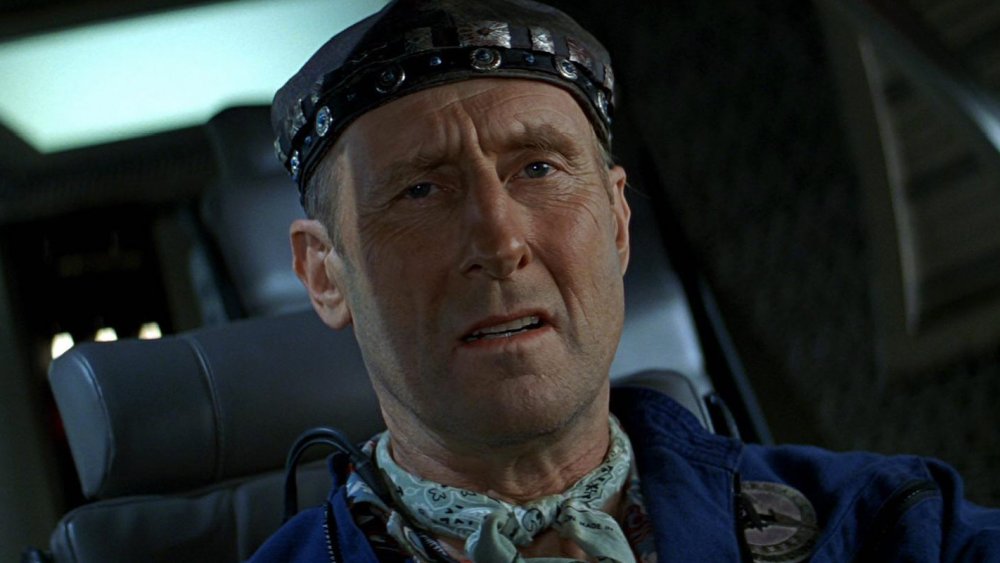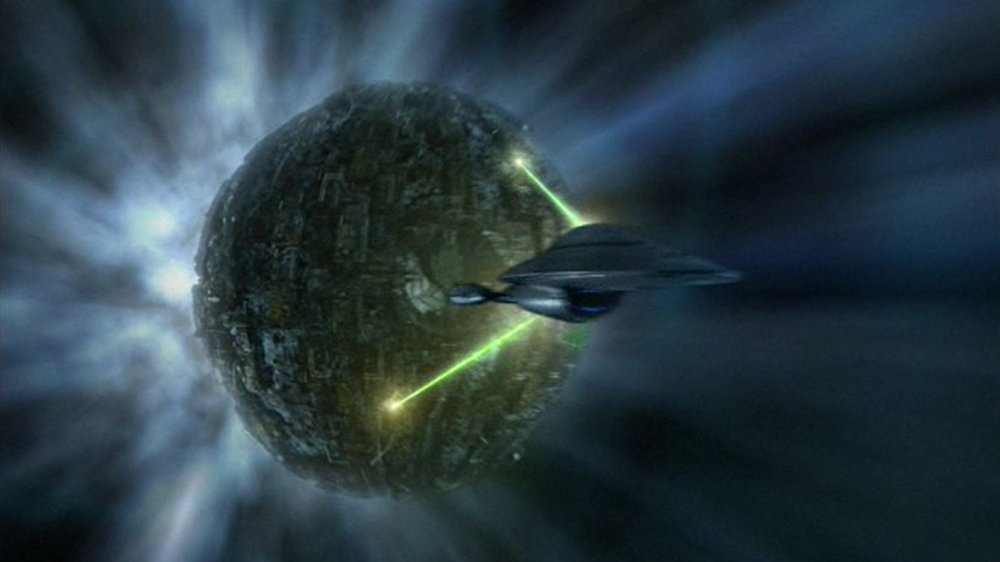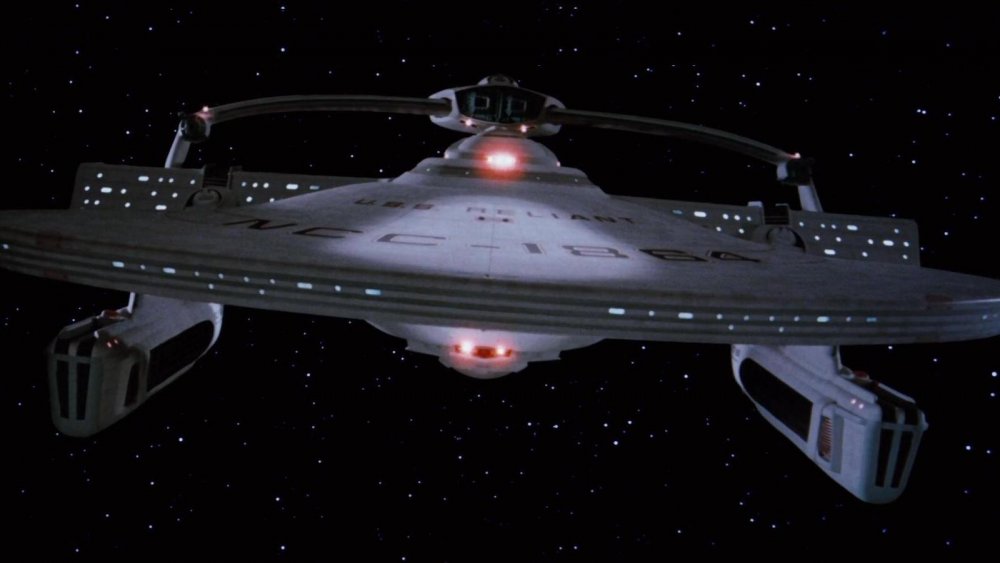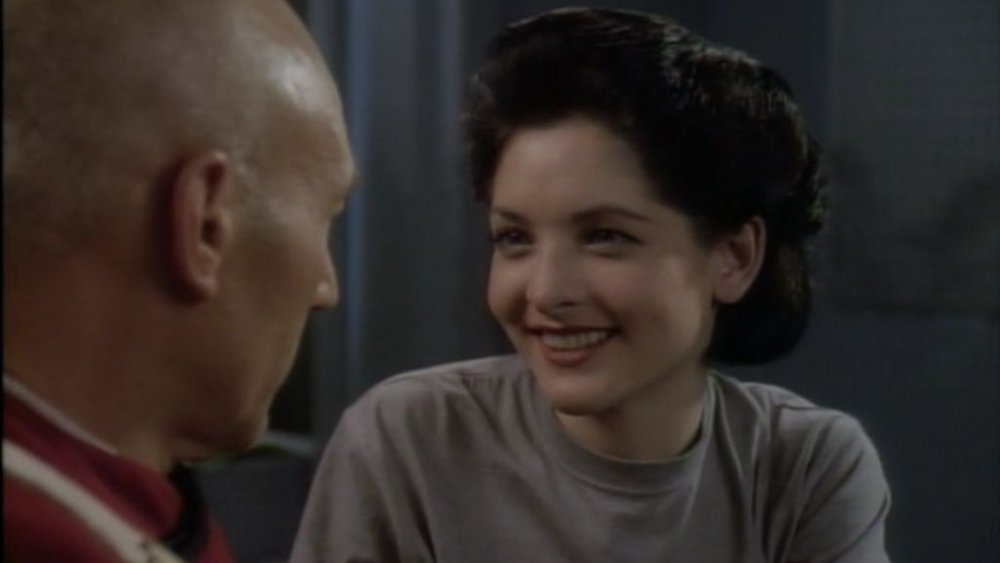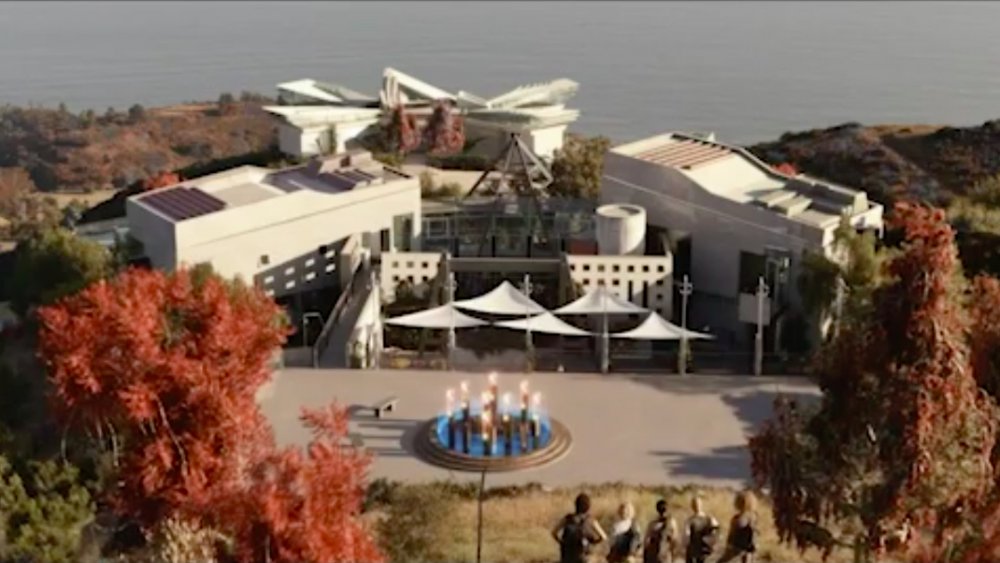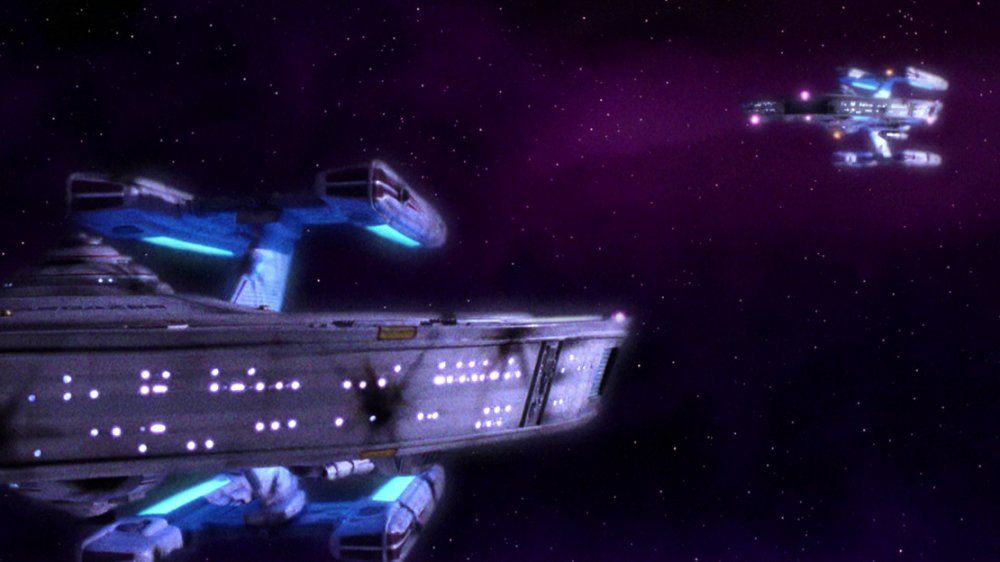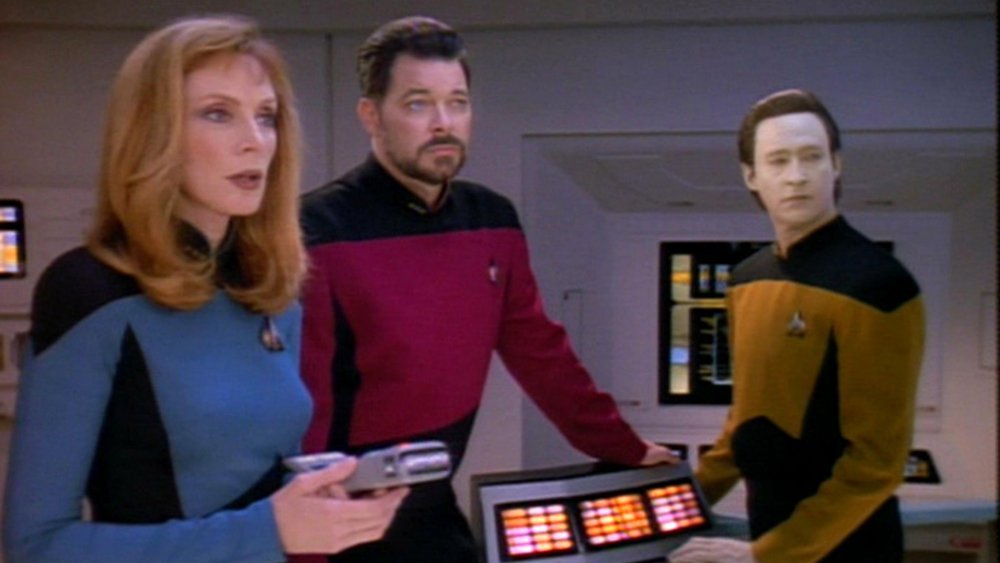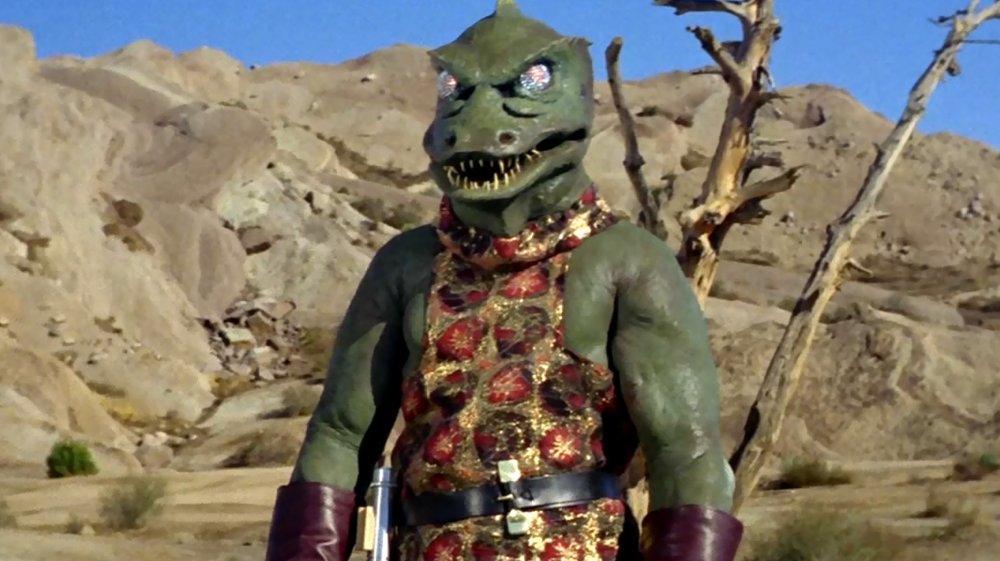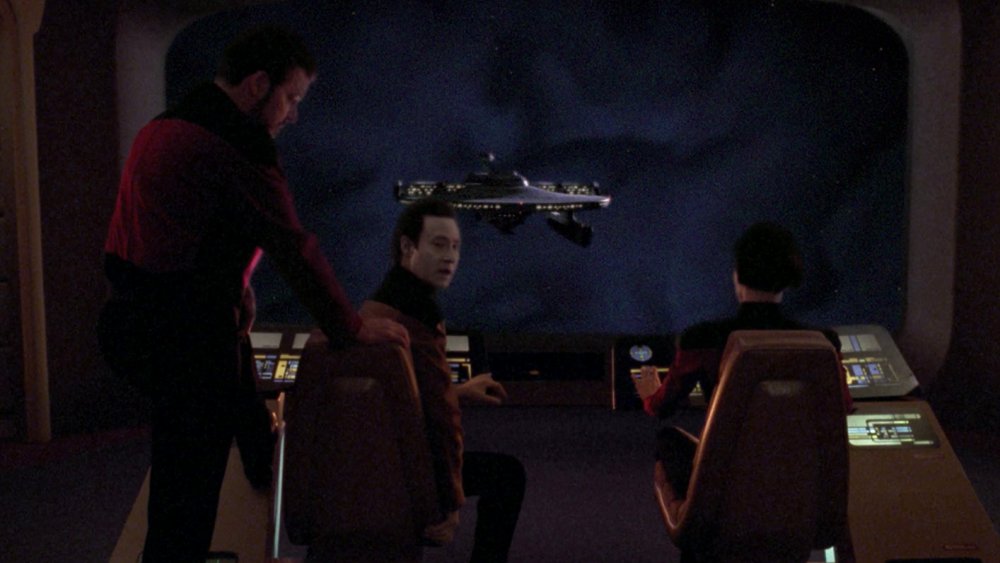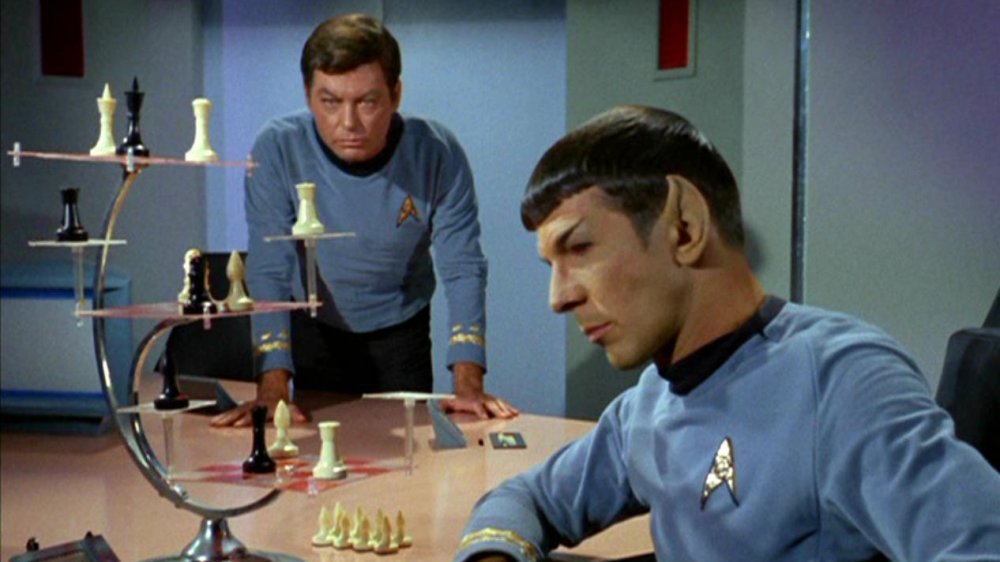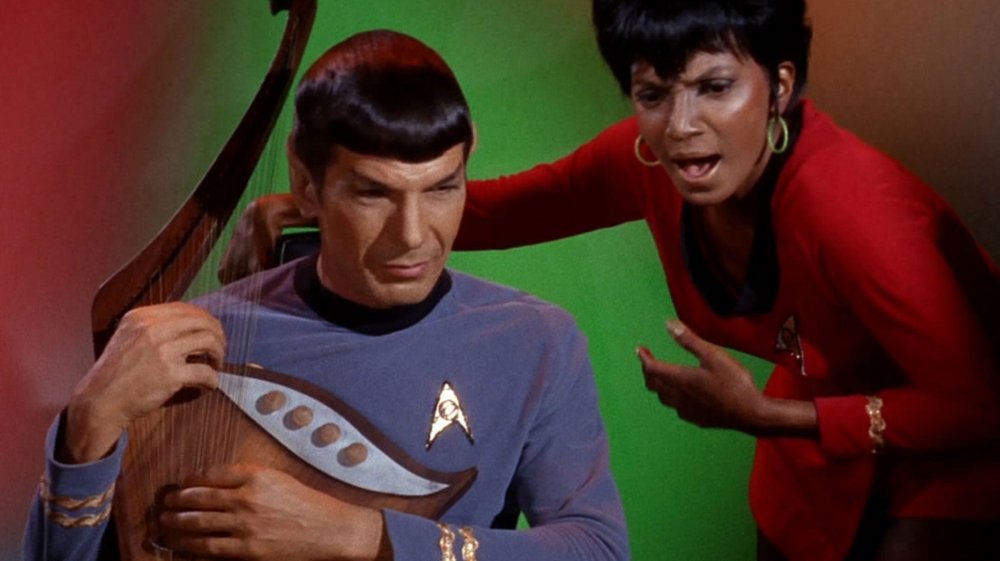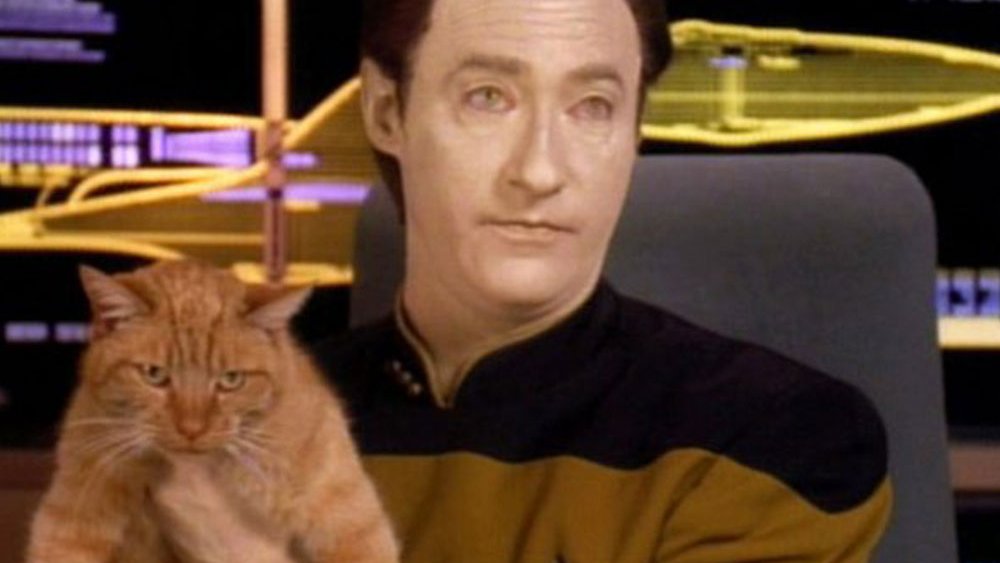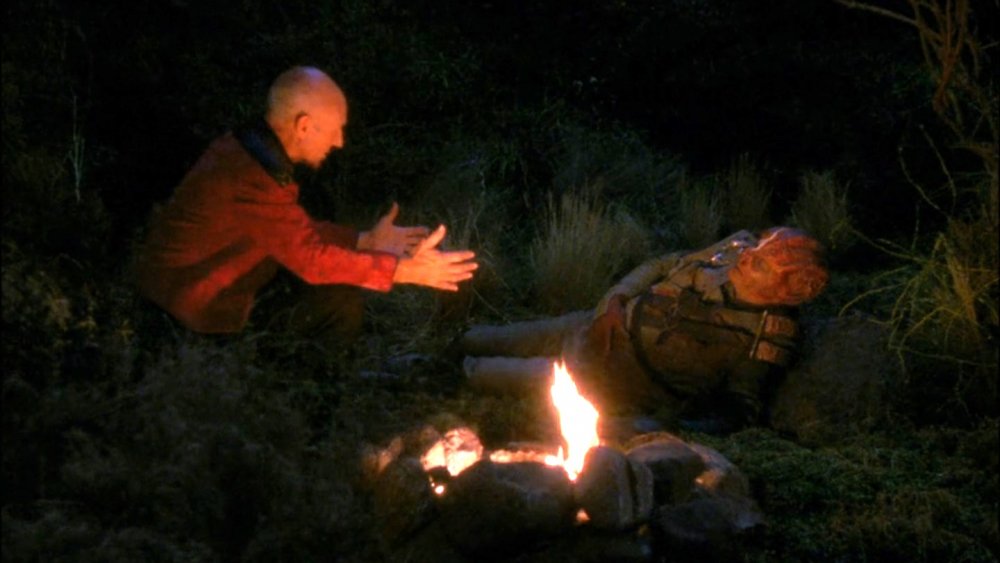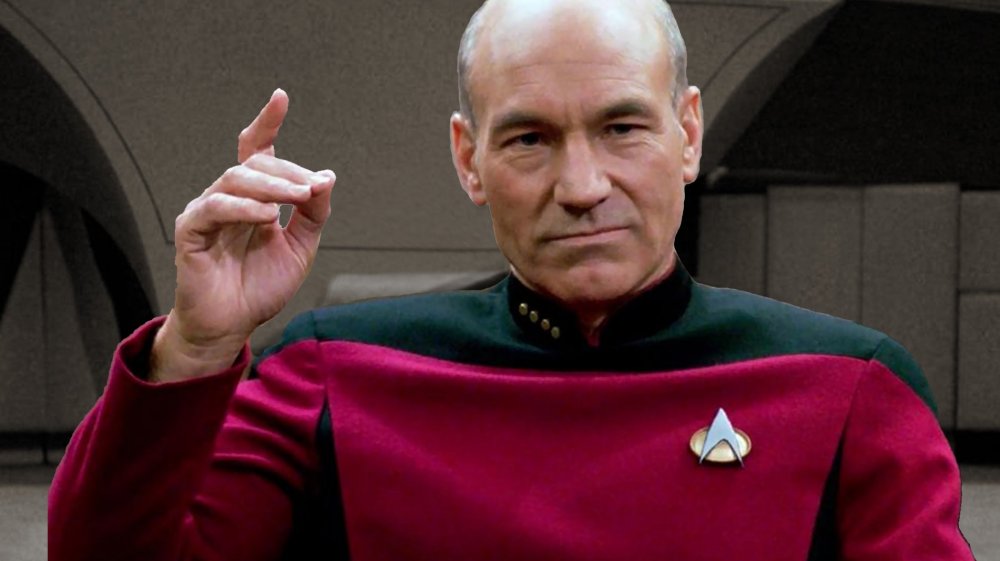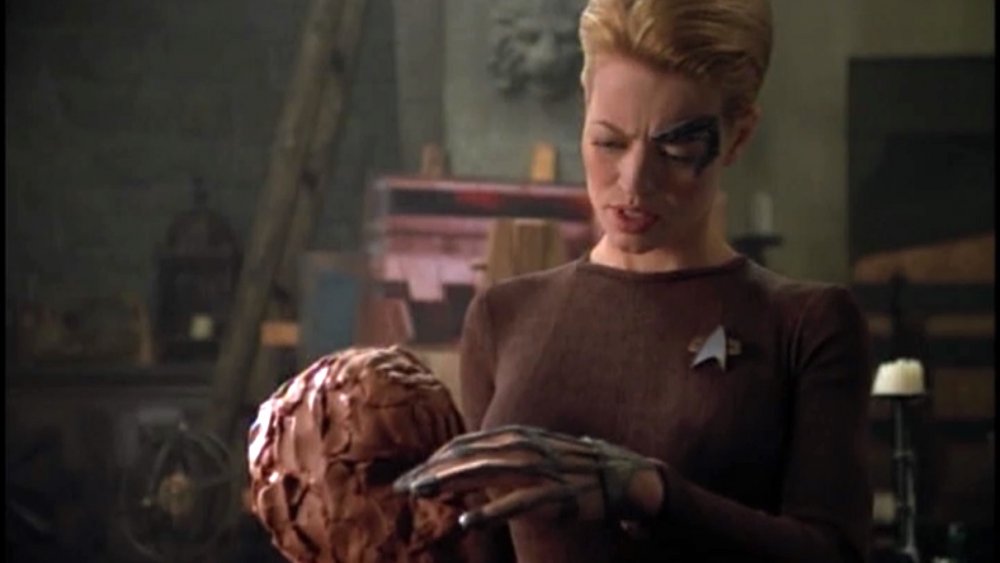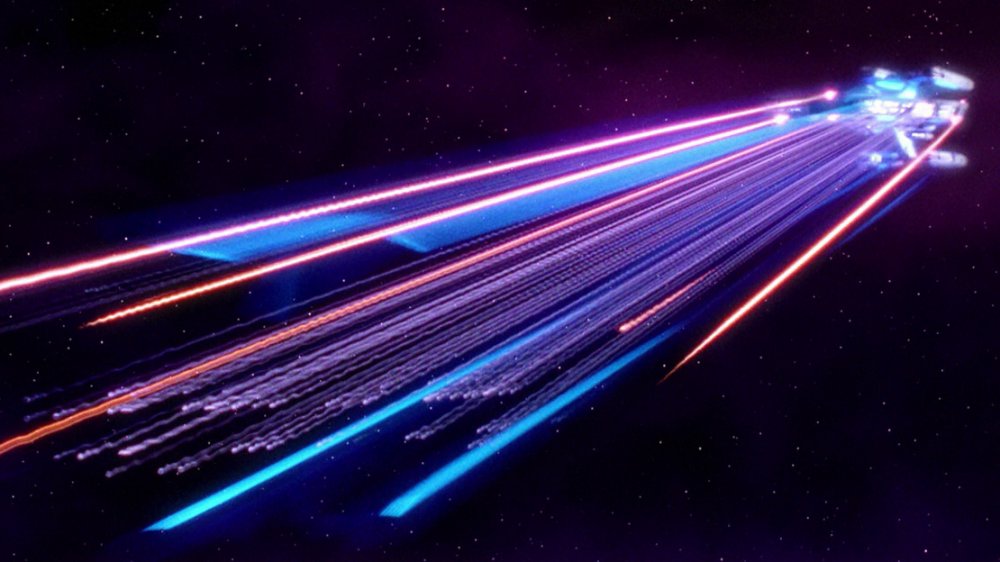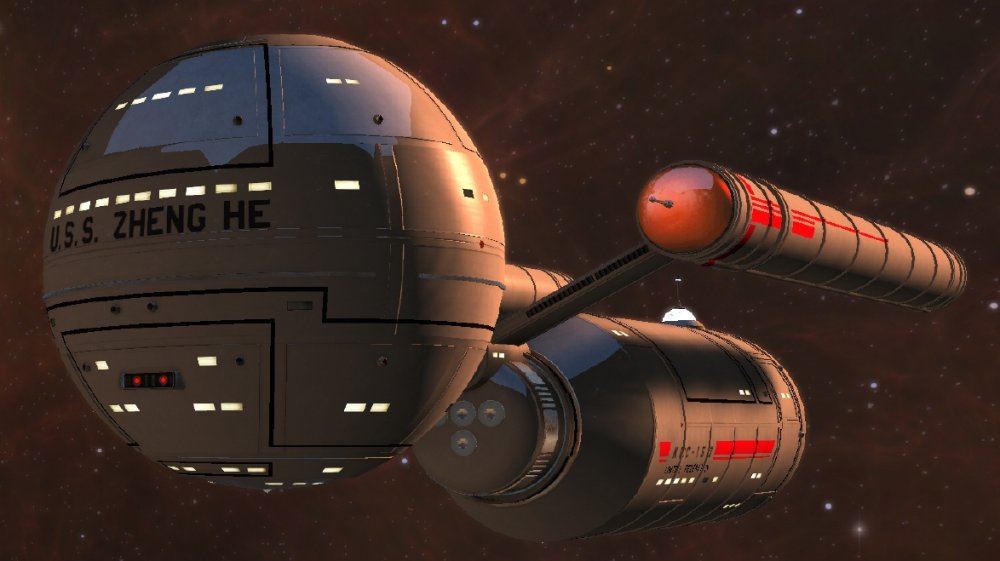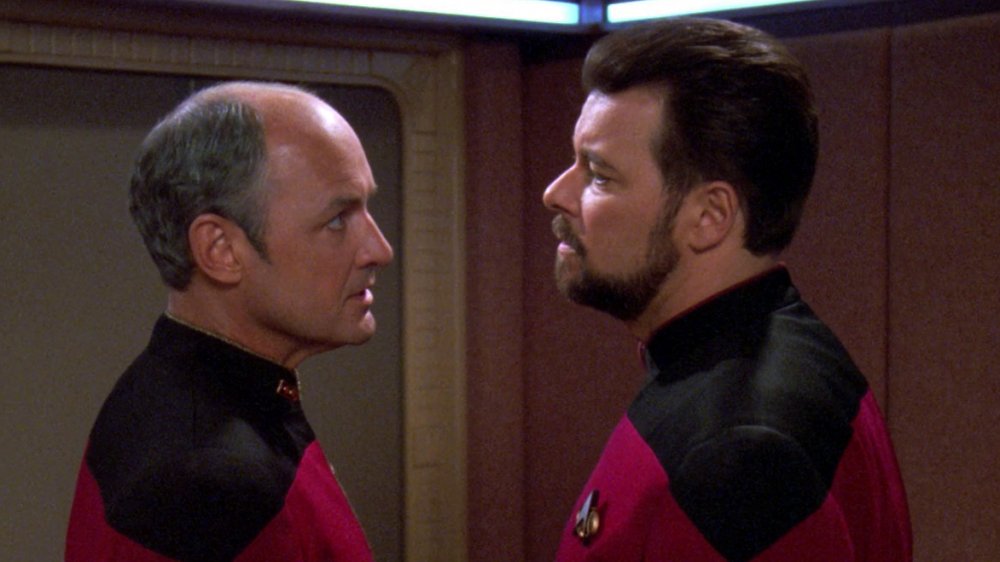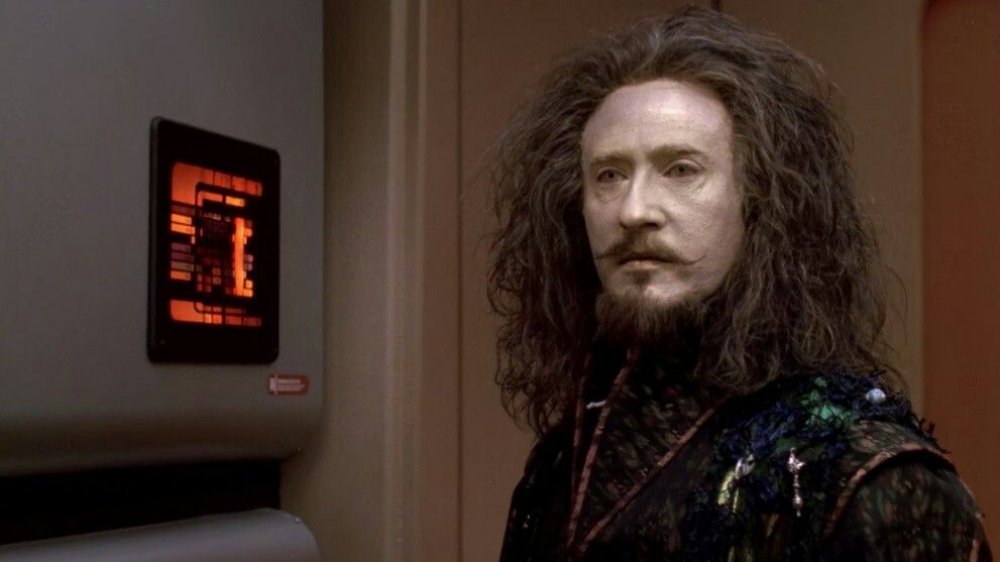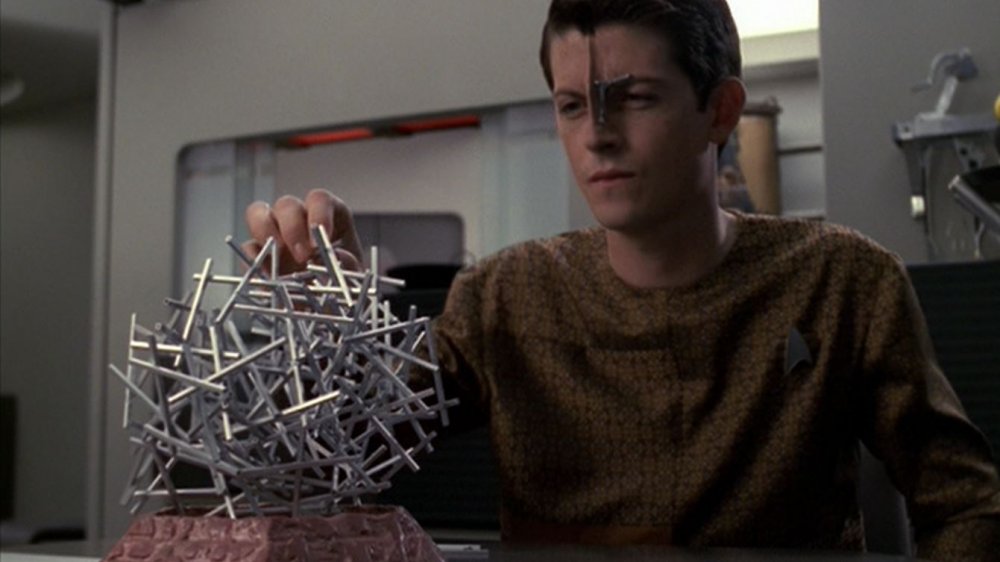Easter Eggs You Missed In Star Trek: Picard
Nearly two decades after bidding farewell to the crew of the USS Enterprise-E in Star Trek: Nemesis, Captain (now Admiral) Jean-Luc Picard (Patrick Stewart) is back for a new adventure in Star Trek: Picard, once again boldly going where no one has gone before. A direct continuation of Star Trek: The Next Generation and its four spinoff films, Picard is chock full of nods to previous iterations of Trek, both bold and subtle. Whether you're a dedicated Trekkie or just a casual Star Trek fan, there's something for everyone to appreciate in Picard, which finds the retired former Starfleet officer swept up in an intriguing new mystery when an enigmatic — and startlingly familiar — young woman seeks out his help after being targeted by masked assassins.
Since Picard builds on the events of The Next Generation and its subsequent feature films, you can hardly sweep all of the show's references to those earlier stories under the umbrella of "Easter eggs." After all, things like the Daystrom Institute, Jean-Luc's trademark order of "tea, Earl Gray, hot" (which has become "tea, Earl Gray, decaf" in his twilight years), and the fact that he named his adorable pit bull terrier "Number One," turning his old nickname for Commander Riker into a literal pet name, are all impossible to miss. But there are also a number of sneakier references that even eagle-eyed Trek fans may have missed in Star Trek: Picard.
Obviously, spoilers ahead.
Blue Skies opens Picard with an echo of Star Trek past
The first episode of Star Trek: Picard opens to the music of Irving Berlin, as Bing Crosby croons the lyrics to "Blue Skies." It's a curious song choice for a show set in the distant future, but the nearly century-old song holds a surprising amount of significance for Jean-Luc Picard. Early on in Star Trek: Nemesis, the final Next Generation film which culminates in Lieutenant Commander Data (Brent Spiner) nobly sacrificing himself for Picard, Data channels the classic crooners of the past by performing "Blue Skies" at the wedding of Will Riker (Jonathan Frakes) and Deanna Troi (Marina Sirtis).
Toward the end of the film, before Data is destroyed along with the Reman ship Scimitar, Data attempts to transfer his memories to B-4, an earlier prototype of the android made by his creator, Dr. Noonian Soong. Unfortunately, B-4 is not nearly as advanced as Data, and it appears the transfer was a failure — until B-4 begins softly singing "Blue Skies" to himself. Picard's reaction in Nemesis indicates that he suspects there may be some of Data still alive after all, a thread that is carried forward into the first episode of Picard, in which the former captain not only visits with Data in his dreams, but speculates that the "essence" of Data now lives on in a new form.
Picard's poker game
Since The Next Generation ended with a poker game, it's only fitting that Picard should begin with one. The first episode sees Jean-Luc and Data playing cards aboard the Enterprise, engaged in the same sort of conversation we've seen them participate in countless times before: analyzing yet another of Data's attempts to appear more human. This time, it's in the form of a "tell" — Data is dilating one pupil in order to fool the Captain into believing he has a good hand, while Picard deduces that his real tell is when he does nothing at all.
The scene helps viewers feel immediately at home in the new show, bringing back settings, themes, and characters that have already been familiar for decades, but it also calls back to the final episode of The Next Generation, "All Good Things..." After skipping through time and saving all life in the universe, the final scene finds the crew of the Enterprise engaged in their regular poker game. They're surprised when Picard arrives and asks to join, but welcome him to the table, and the series ends with the Captain dealing the cards while saying, "The sky's the limit." In Picard, the poker game makes it clear that we're picking up where the previous show left off, and setting it to "Blue Skies" could even be calling back to Picard's final line.
A poker game also opens the Next Generation episode, "The Measure of a Man," in which Data's humanity is put on trial. In that episode — which was nodded to several times in Picard's first episode, "Remembrance" — Data also uses poker as an analogy to try to illustrate the difference between knowledge and memories. The themes of that episode feel relevant to Picard, in which synthetics have been deemed too dangerous to exist, and have been outlawed entirely.
The Dixon Hill hat hides in plain sight in Picard's first episode
When Jean-Luc is getting ready for his interview in the first episode of Picard, as he evaluates his appearance in the mirror we get a brief glimpse of a cream-colored fedora with a black band hanging on a coat rack behind him. From perspective of the camera, the hat almost appears to be sitting on Picard's head at a jaunty angle.
What at first glance could be mistaken for just a random piece of set dressing actually hearkens back to one of Picard's favorite holodeck characters — the 20th century detective, Dixon Hill. The gumshoe was one of young Jean-Luc's childhood heroes, and Picard donned the private investigator's characteristic trench coat and fedora on numerous occasions during The Next Generation's run, most notably during the season one episode "The Big Goodbye." In that episode, the simulated mystery Picard is trying to solve on the holodeck involves the murder of a young woman, foreshadowing the real-life puzzle he finds himself caught up in as Picard begins.
The destruction of Romulus
Set in the year 2399, the first episode of Star Trek: Picard takes place on the 14th anniversary of the Romulan supernova, an event which destroyed the planet Romulus and would've killed over 900 million Romulan people, if Picard hadn't intervened and beseeched Starfleet to mount a rescue mission. However, in the midst of the evacuation efforts, a group of synthetics rose up and attacked the rescue armada, wiping it out, and Starfleet subsequently abandoned their rescue efforts and banned synthetics entirely, prompting Picard to resign his commission in protest.
While we've never before witnessed the aftermath of the Romulan supernova, we have actually heard about it before — in J.J. Abrams' 2009 Star Trek film. In that film, Spock mentions that he tried to prevent the supernova in the year 2387, but failed to do so and accidentally created a rift in time, sending a Romulan ship back to the year 2233 and spawning an alternate timeline, where the subsequent Star Trek films have taken place. In Picard, we finally see the events of that original timeline play out, even though Spock and his role in what happened are never mentioned.
The Utopia Planitia shipyards
During an interview that is ostensibly supposed to be about raising awareness of the lingering harmful effects of the Romulan supernova (but is actually more of an ambush regarding Picard's retirement from Starfleet), the interviewer mentions that the Utopia Planitia shipyards on Mars were completely destroyed in the synthetic attacks during the supernova. It's a passing comment in a laundry list of the catastrophic events that brought Picard and the Federation to their ultimate opposing positions, but "Utopia Planitia" aren't just some random futuristic words thrown in for emphasis — the shipyard has a lot of significance in Star Trek lore.
The Utopia Planitia shipyards served as one of the primary Starfleet ship construction sites across several Star Trek series. Among the many ships that were constructed there were the USS Voyager, the USS Defiant (which featured prominently in Star Trek: Deep Space Nine), and of course, the flagship herself, the USS Enterprise 1701-D. Further, Commander Benjamin Sisko (Avery Brooks) served for several years at Utopia Planitia before taking command of the Deep Space 9 space station near the planet of Bajor.
Data's painting plants an Easter egg in Picard's dreams
Jean-Luc has several dreams of Data during the first episode of Star Trek: Picard, but one of the most pivotal moments occurs when he dreams of Data painting a woman in white robes gazing out over a turbulent sea. This dream cues Picard to go find a painting the real Data gifted to him 30 years earlier, which — to Picard's extreme surprise — depicts the same young woman who showed up in Picard's vineyard earlier in the episode.
While Data explored a lot of artistic pursuits over the course of The Next Generation, his painting in Picard seems to call back specifically to the sixth-season episode "Birthright, Part 1," in which Data experiences a confusing vision and asks Captain Picard how he should go about interpreting it. Picard urges him to explore what he saw in a way that feels meaningful to him, and Data decides to use painting to explore the images in his head. Ultimately, after painting dozens of pictures, Data determines that he has accessed a new level of his programming and can now dream, which he resolves to continue doing henceforth. It seems only fitting that in Picard, Data's painting comes full circle, with Picard using the image of Data painting in his dreams to find meaning in what's happening in his real life.
The Stargazer and the Cousteau
When Picard goes to visit his vault in the Starfleet Archives during the first episode of Picard, we get a brief glimpse of two prominently displayed model ships, neither of which is the Enterprise. The first is the USS Stargazer, the first starship Picard ever commanded. This was the ship where he would first perform the battle tactic that eventually came to be called the "Picard Maneuver," using a brief burst from the ship's warp drive to confuse the sensors of the opposing ship, making it appear as though the Stargazer was in two places at the same time. While Picard sometimes spoke disparagingly of the Stargazer, he once admitted that he occasionally longed to command the old ship again.
The second model is the captain's yacht from the Enterprise-E, christened the Cousteau. The Cousteau was featured in Star Trek: Insurrection, in which Picard and the crew of the Enterprise stood against the Federation to keep them from forcibly relocating a peaceful species so that they could harvest (and subsequently destroy) their planet's resources. In Insurrection, Picard temporarily resigns from Starfleet, disgusted by their abandoning of the Prime Directive and their dismissal of innocent lives in the name of their own self-interest — which is exactly the same issue that ultimately led to his permanent resignation following the Romulan supernova.
The Klingon bat'leth
There is also a Klingon weapon in Picard's vault in the Starfleet Archives, a curved blade called a bat'leth. In The Next Generation, episodes often featured Lieutenant Commander Worf (Michael Dorn) training and fighting with a bat'leth that had been in his family for generations. While Klingons possessed other weapons, the bat'leth was often preferred in combat and considered a more honorable weapon than a disruptor.
It's unclear exactly where Picard's bat'leth came from; while it's possible it's Worf's, it could also be one that Picard came by through his other dealings with the Klingons. Picard notably served as Arbiter of Succession at the request of the Klingon leader K'mpec during the Next Generation episodes "Reunion" and "Redemption," and it's possible his high standing with the Klingon Empire led at some point to him receiving his own bat'leth.
Regardless of where Picard's bat'leth came from, the weapon's presence in his vault serves as a reminder that Picard is highly respected among the Klingons, who used to be the Federation's fiercest enemies. That theme feels significant to Star Trek: Picard, which reveals that the former officer resigned from Starfleet over their treatment of the Romulans, who stepped into the role of primary Trek villains after the Federation finally made peace with the Klingons.
Captain Picard Day
One of the final treasured items that Jean-Luc Picard has kept stored away in his vault all these years is the banner that the children of the Enterprise made for him to celebrate "Captain Picard Day," an annual event in which the children of the starship honor its captain through original artwork. While Picard was reluctant to participate in Captain Picard Day while aboard the Enterprise, it would seem he may have appreciated it more than he let on, if he kept the banner for decades after leaving his post.
We witness Picard receiving the banner in The Next Generation's season 7 episode "The Pegasus," which sees the crew of the Enterprise facing off against the Romulans to recover a Starfleet ship near the neutral zone. During the course of the episode, it becomes clear that Starfleet violated their peace treaty with the Romulans and tried to cover it up, but Picard refuses to go along with the deception, revealing the truth to the Romulans and siding against his Starfleet colleagues. In short, this is yet another Easter egg in Picard's first episode that calls back to a time when our hero took a stand against the Federation, possibly foreshadowing that the one-time captain and Starfleet are about to find themselves at odds once more.
One Picard Easter egg makes mention of a familiar doctor
When Picard travels to the Daystrom Institute in Okinawa in order to dig into the possibility that Dahj (Isa Briones) may be a flesh and blood synthetic, he meets with Dr. Agnes Jurati (Alison Pill), who assures him that sentient flesh and blood synthetics are nothing more than a forgotten pipe dream. Jurati then mentions that she was recruited by Dr. Bruce Maddox, and that the two of them had worked together to create a sentient android similar to Data. She says they'd been close until the synthetic ban, after which Maddox disappeared.
If the name of the missing scientist sounds familiar, there's a good reason for that. Bruce Maddox first appeared in the Next Generation season 2 episode "The Measure of a Man," in which he argued against Data's sentience in the hopes of being able to override his free will and study him. Opposing Maddox was none other than Captain Jean-Luc Picard, who presented a moving (and ultimately, victorious) case for Data's personhood. Mentioning Maddox — who does indeed resurface later in Picard — in an episode already rife with themes of sentience, identity, free will, and individuality feels like a very deliberate nod to one of The Next Generation's most fascinating core debates, and hints that we haven't heard the last of either side of this argument.
Data always wanted a daughter
When Picard is telling Dahj his theory about her origins, she tells Picard about a hybrid orchid that her father engineered, splicing two genuses and naming "the offspring" after her. Later, Picard mentions to Dr. Jurati that Data always wanted a daughter. Both lines together seem to be a direct reference to "The Offspring," a season 3 episode of The Next Generation in which Data constructs an android daughter named Lal (meaning "beloved") from his own design.
In "The Offspring," Lal evolves quickly, surpassing even Data's abilities in a short amount of time and revealing that she can feel emotion, but ultimately her experiences wind up overloading her positronic brain. Despite Data's best efforts, he is unable to save her. Data then downloads Lal's memories into his own neural net, so that in a way, she can live on through him. "The Offspring" also sees Picard side against the Federation yet again, when a Starfleet Admiral attempts to claim Lal for scientific research, and Picard refuses to let her go. Dahj's journey in "Remembrance" mirrors Lal's in many ways — in how she surpassed her creator, how Picard tried to protect her, and ultimately, in how she died after only being truly awake for a brief time.
A shuttlecraft from Star Trek past appears in Picard episode 2
The second episode of Picard opens by jumping back to the fateful day in 2385 (kicked off, appropriately, by the actions of a synthetic worker named "F8") when the synthetic workers stationed at the Utopia Planitia shipyards rose up against their flesh and blood coworkers, killing them and destroying the site so entirely that it is still burning 14 years later. Before the day starts going very, very badly, we get several shots of business as usual in the shipyards, complete with a close-up of an Argo-type shuttlecraft.
The Argo was first seen in Star Trek: Nemesis, in which Picard, Worf, and Data flew the shuttlecraft from the Enterprise-E to the surface of the planet Kolarus III. There, they recovered the android B-4, who we already saw make an appearance in Picard's first episode, "Remembrance." While the Argo-type craft that we see in "Maps and Legends" is likely not the exact same ship (although it could be, since the Enterprise-E returned to Earth for repairs at the end of Nemesis in 2379, which is not far from Utopia Planitia), it still calls back to an extremely significant event in Picard's lore, tying into the show's central mystery of Data's involvement in Dahj and Soji's creation.
Happy First Contact Day
Although the first episode of Picard ties the 2385 massacre at Utopia Planitia to the Romulan supernova, the second episode links it to another hugely significant event in Star Trek's history: First Contact Day. Established to commemorate both the first successful warp flight and the first inter-species contact between humans and Vulcans in the year 2063, as shown in Star Trek: First Contact, First Contact Day has long been established as an annual holiday in the world of Star Trek.
In Star Trek: Voyager, we even got to see a First Contact Day celebration, complete with warp engine creator Zefram Cochrane's favorite food, and the ship's Vulcan science officer reciting the Vulcans' initial greeting to the people of Earth. Captain Janeway also mentioned in Voyager that as a child, she always got the day off from school. In 2385, though, the workers at Utopia Planitia complain that they still have to work on the holiday.
Having the synthetic attack on Mars take place on First Contact day underscores the jarring thematic juxtaposition of an event that ultimately sparked intensified xenophobia occurring on a day meant to celebrate good-faith interspecies cooperation and trust. Following the attack, the Federation would abandon their attempt to save the Romulan people from the supernova, and would also ban synthetics entirely.
The flowers in Picard's study have deeper significance
When Picard's doctor comes to visit him in "Maps and Legends," the walls of his study can be seen to have been decorated in pink and yellow flowers. While the color choice is no doubt aesthetically pleasing to Jean-Luc and the other inhabitants of his home at Château Picard, the flower colors also nod back to a line Dahj had in "Remembrance." In Picard's first episode, Dahj tells a story of how her father spliced together two genuses of orchids — pink and yellow — in order to create the hybrid strain that he named after her.
The combination of the colors pink and yellow also has another, subtler significance to the story unfolding in Picard. Lieutenant Commander Data, whose life, death, and legacy loom large in the first two episodes of Picard, was always easy to spot in a crowd with his pale yellow skin and bright yellow eyes (not to mention his yellow uniform). However, when he designed his own child in the Next Generation episode "The Offspring," the being he initially created was pink, before she selected a human appearance and gender for herself. The yellow and pink flowers in "Maps and Legends" are clearly meant to represent Dahj, but the colors and her story of her father's creation of a pink and yellow hybrid are likely yet another clue of her ties to Data.
The defect in Picard's parietal lobe
When Picard's doctor (who previously served with him on the Stargazer) comes to visit him in the second episode of Picard, he brings with him the somber news that he suspects that a small defect in Picard's parietal lobe may have triggered one of several related neurological syndromes. The two of them talk about the defect itself as though the knowledge of it is old news, which it is — the defect was first discovered by Dr. Beverly Crusher (Gates McFadden) in the Next Generation series finale, "All Good Things..."
That episode saw Picard skipping through time, including one thread in the distant future, when he learns that he will eventually develop Irumodic Syndrome, a degenerative and ultimately terminal neurological condition that can cause symptoms of confusion, hallucinations, and paranoia. Picard has Crusher scan him in his "present" timeline for possible warning signs, and while she finds no traces of Irumodic Syndrome, she does notice a small defect in the parietal lobe which could — but won't necessarily — eventually lead to Irumodic Syndrome.
While neither Picard nor his doctor mention Irumodic Syndrome by name in "Maps and Legends," it's clear that this is what Picard is worried about. In "All Good Things...," we see that the future, older Picard is often second-guessed and discounted due to his diagnosis, leading to him going against the orders of Starfleet and calling in favors to obtain a ship and carry out his mission — a plotline strongly echoed by the first season of Star Trek: Picard.
Paging Patrick Stewart
When Picard steps into the lobby of Starfleet Headquarters in "Maps and Legends," taking in the sights and sounds of the building, a voice can be heard over the intercom paging "Admiral Gurney" to conference room B. Although it's easy to dismiss the line as simple background chatter, the name "Gurney" has some surprising significance to the lead actor of Picard.
In the 1984 science fiction film Dune, Patrick Stewart played a character named Gurney Halleck, who was both a skilled musician and a formidable warrior. Although Gurney Halleck's specific character traits are likely not particularly relevant to Picard, the name over the pager is almost assuredly a sly tip of the hat to Stewart's character in Dune. Making the reference even more amusing is Picard's line later in the episode in which he claims that he's "never really cared for science fiction" — an obviously tongue-in-cheek jab at the fact that Stewart himself has starred in several sci-fi classics over the years.
5,843 days
When Soji goes through orientation at the Romulan reclamation station located on the decommissioned Borg cube in "Maps and Legends," a sign can be seen stating that "This facility has gone 5,843 days without an assimilation." It's an amusing joke, likening Borg assimilations to everyday workplace accidents, but the number may also have interesting interpretations within the Star Trek universe. Several theories on Reddit postulate that 5,843 days — which is almost exactly 16 years — could point to a significant date in the Star Trek world. The trailer for Picard debuted on July 20, 2019, precisely 5,843 days after original Enterprise designer Matt Jeffries died on July 21, 2003. 16 years is also the amount of time that passed between Star Trek: Nemesis in 2002 and the announcement of Picard in 2018, although the number of days between the two events isn't exactly 5,843.
5,843 days is also a prime number, which could be a subtle nod to the Prime Directive, Starfleet's core tenet that the Federation cannot interfere in the development of alien civilizations, which has been at the center of many of the conflicts between Picard and Starfleet. While Picard viewed the Prime Directive as a governing principle which he frequently fought to uphold, he at times seemed to go against it, arguing that the philosophical nature of the Prime Directive allowed for differing interpretations in the name of greater justice.
Isaac Asimov's The Complete Robot
When Picard meets with Dr. Jurati in "Maps and Legends," he comes upon her paging through Isaac Asimov's The Complete Robot, a collection of science fiction short stories about robots. Asimov's fiction often explored ideas of sentience and morality in robots, which was also one of the main philosophical quandaries of Star Trek: The Next Generation, and is shaping up to be a central question of Picard.
It feels additionally significant that The Complete Robot makes an appearance in an episode that opens with a scene of robots — called "synthetics" in Star Trek's world — violently acting out against their creators. All three of the actions shown by F8 in the opening sequence are expressly prohibited by Asimov's Three Laws of Robotics, which state that a robot may not injure a human being or, through inaction, allow a human being to come to harm; a robot must obey the orders given it by human beings except where such orders would conflict with the First Law; and a robot must protect its own existence as long as such protection does not conflict with the First or Second Laws. The opening scene shows F8 attacking his coworkers, ignoring their orders to stand down, and ultimately destroying itself, violating all three of Asimov's laws in sequential order.
Vasquez Rocks
After opening with a flashback to Picard's resignation from Starfleet 14 years earlier, the third episode of Picard (titled "The End is the Beginning") finds the erstwhile Admiral paying a visit to his former first officer, Raffi, who was fired from Starfleet after Picard resigned. Raffi is now living in a self-described "hovel" in the Vasquez Rocks, where it seems she passes her time getting high and trying to forget the years she spent working alongside Picard.
However, for long-time Star Trek fans, the Vasquez Rocks are more than just a cool location for Raffi to park her 24th century trailer. The Vasquez Rocks Natural Area Park, located in the Sierra Pelona Mountains in southern California, has been a frequent shooting location for past Star Trek productions, including episodes of the original series, The Next Generation, Voyager, and Enterprise, along with scenes in the films Star Trek IV: The Voyage Home, J.J. Abrams' 2009 Star Trek, and its 2013 sequel, Star Trek Into Darkness. As a matter of fact, the Vasquez Rocks have been featured so prominently within Star Trek lore that the location has even been nicknamed "Kirk's Rock."
Rios' mermaid tattoo
When Picard meets his new pilot-for-hire, Cristóbal "Chris" Rios, in "The End is the Beginning," it's under less than ideal circumstances, as Rios is in the process of having a piece of titanium shrapnel removed from his shoulder. In order for the Emergency Medical Hologram to access the injury, Rios is shirtless, giving us a clear view at the prominent mermaid tattoo on his upper left arm.
Rios' ship is named the La Sirena, which translates from Spanish as "The Mermaid." It makes sense that Rios would have such a strong personal connection to his ship that he'd want to permanently mark it on his body, but his choice to name his ship "The Mermaid" could also be a hint that Rios and Picard may have more in common than it might appear at first glance. Mermaids and mermaid tattoos have long been associated with a romanticized image of sailors heading out on perilous voyages, which is how Picard often seemed to view his role as the commander of a Federation starship (made plain by the opening of Star Trek: Generations, in which Picard and the crew of the Enterprise stepped into their equivalent roles as officers on a 19th century naval ship). Rios' embracing of such a classic maritime symbol may indicate that despite their apparent differences, Rios and Picard may in fact be kindred spirits.
The Tragic Sense of Life by Miguel de Unamuno
After the two meet in "The End is the Beginning," Picard notices that Rios is in the middle of reading a hardcover version of The Tragic Sense of Life by Miguel de Unamuno. Written in 1912, The Tragic Sense of Life was a philosophical essay in which the author grapples with his own existentialist questions, namely his struggle to reconcile man's pursuit of wisdom, knowledge, and reason with his belief that those pursuits (and consciousness in general) actually work in opposition to leading a happy life. The particular passage that Rios is reading later on in the episode, on page 140 of the book, deals with the link between consciousness and suffering, in which Unamuno muses, "How do we know that we exist if we do not suffer, little or much? How can we turn upon ourselves, acquire reflective consciousness, save by suffering?"
While Picard hasn't been explicitly shown to be a fan of Unamuno specifically, it's well established that he considers himself a philosophical scholar, and was shown reading and referencing various works of philosophy multiple times throughout The Next Generation's run. Rios' interest in philosophy is yet another clue that the pilot may have more in common with the Admiral than meets the eye. But the passage Rios was reading also seems to point — somewhat ominously — to the theme of sentience and personhood that so strongly define Picard. Unamuno argues that suffering is essential to consciousness, and that without it, we have no way of knowing that we are truly alive — a philosophy that we may see revisited as we learn more about Dahj and Soji's origins, and the circumstances leading up to the synthetic uprising.
Picard's Gorn (Easter) egg
Despite Raffi's insistence that she wants no part of Picard's new mission in "The End is the Beginning," he sends her all of the information he has on Bruce Maddox's research anyway, and she can't help digging into it. As Raffi sifts through the files from the Daystrom Institute, there's a brief shot of her screen, on which the words "Crypto Algorithm Identification: Gorn Egg" can be read in glowing orange and green text.
The Gorn are a reptilian alien species first introduced on the classic Trek episode, "Arena," in which Captain Kirk is transported to the surface of a rocky planet (filmed at the Vasquez Rocks, featured earlier in "The End is the Beginning") by aliens called the Metrons, and told he must battle the captain of an opposing Gorn ship to the death, with the winning captain allowed to leave with his ship and crew, and the losing captain's ship and crew being destroyed. Kirk and the Gorn captain both manage to injure one another, but Kirk ultimately decides to show mercy and spare the Gorn's life, which in turn leads to both crews being spared by the Metrons.
At the end of "Arena," the Metrons tell Kirk that while humans are a savage race, there is hope for them due to their capacity to show mercy to their enemies. Conversely, the beginning of Picard's third episode finds Picard and Raffi lamenting that the Federation is refusing to show mercy to the Romulans, capitulating instead to "intolerance and fear." Had Kirk given into those same tendencies in "Arena," it would've led to a far different and more disastrous outcome.
Picard's impressive resume
Despite Rios' many personal similarities to Picard, the pilot is initially reluctant to agree to help the former Starfleet Admiral when they first meet in "The End is the Beginning." Later, when Rios is alone in his quarters, the Emergency Navigational Hologram (which, interestingly enough, is modeled to look exactly like Rios, albeit with a different accent) appears and attempts to talk Rios into helping Picard, despite his reservations. One of the ENH's persuasive tactics is reading highlights from Picard's resume, which include a number of references that will be immediately recognizable to dedicated Star Trek fans.
As the ENH runs down his laundry list of Picard's accomplishments, he mentions that Picard was "chief contact with the Q continuum," which is a reference to both the pilot episode and series finale of Star Trek: The Next Generation, as well as a number of notable episodes during the series run. Picard's encounters with Q also led to the first introduction of (and subsequent attacks by) the Borg, which the ENH references in the next item on his list, "savior of Earth from Borg Invasion," referring to Picard's role resisting the Borg in the two-part episode "The Best of Both Worlds," and again in the film First Contact. He also mentions that Picard was "Arbiter of Succession for the Klingon Empire," which was already nodded to in Picard's premiere episode, and that he was "captain of the Enterprises D and E," a reference that needs no explanation.
The ENH wraps up his exultations of Picard by name-dropping that he "worked alongside the great Spock," calling back to the Next Generation episode "Unification," and could also be a nod to Spock's role in attempting to prevent the Romulan supernova, as explained in 2009's Star Trek.
The return of Hugh
While the first few episodes of Picard are set mostly on Earth, all of Dahj's twin sister Soji's scenes have been set aboard a Romulan reclamation station on a repurposed Borg cube, on which she encounters an ex-Borg drone named Hugh. Alongside the Romulans, the Borg were one of the primary villainous races in The Next Generation, and even assimilated Picard into their Collective at one point in the two-part episode "The Best of Both Worlds." However, the Borg gained some added depth in the episode "I Borg" (the title a riff on Isaac Asimov's "I, Robot," which was itself referenced in Picard's second episode), which saw the Enterprise crew encounter a young Borg drone who had been abandoned by the Collective. Although Picard initially sees the Borg as nothing more than a way to help him bring down the Collective, he ultimately is forced to recognize his sentience and personhood when the drone begins exhibiting signs of individuality and gives himself the name "Hugh."
Hugh pops up again in the two-part TNG episode "Descent," where it is revealed that after rejoining the Collective, his sense of individuality spread to his entire cube, and they were cut off from the Collective. In "Descent," Hugh proved himself a loyal ally of Picard and the Enterprise, rescuing several members of the crew and resisting Data's megalomaniacal brother, Lore. It's hard to predict what's in store for Hugh on Picard, but if Hugh's past history with the Admiral are any indication, he may prove to be an important — albeit unexpected — ally for Picard and his rogue crew.
All for one, and one for Picard
Over the course of Star Trek: Picard, the show has pieced out glimpses of the events that occurred 14 years prior to its main narrative, during the Romulan supernova. "Absolute Candor" shows us what Picard was doing immediately prior to the synthetic attack on Mars — visiting an order of Romulan assassin nuns called the Qowat Milat on the planet Vashti. The Qowat Milat are also caring for a young boy named Elnor, a refugee Picard entrusted to the order until a more suitable home could be found for him. Until then, Picard has a fond relationship with the child, and brings him a copy of Alexandre Dumas' The Three Musketeers. Picard reads the book aloud to Elnor, and the two of them enthusiastically enact some of its more energetic fencing scenes before Picard receives the tragic news about Mars.
While The Three Musketeers is a popular tale that has been referenced numerous times in Star Trek history, the book plays a significant role in the Next Generation episode "Hollow Pursuits," in which a crewmember of the Enterprise creates a holodeck program that allows Picard, Data, and Geordi play the Musketeers, with Riker joining later on as a diminutive D'Artagnan. In "Hollow Pursuits," the Musketeer version of Picard challenges the real-life Riker to a duel, then taunts him when Riker refuses, saying he has no sword and doesn't want to fight. Later on in "Absolute Candor," Picard will be challenged to a duel, throw down his sword, and refuse to fight.
Picard revives a running joke about Klingon opera
Early on in "Absolute Candor," Dr. Agnes Jurati wanders onto the bridge, desperate for some conversation to take her mind off of the boredom and monotony of space travel. When Rios seems reluctant to talk, Jurati runs through a list of the things she's already done to occupy her time. She reveals that she's read through two years' worth of back issues of The Journal of Theoretical Cybernetics and watered his plants, and then mentions that she "was going to watch a holo, but weirdly, all you have on board is Klingon opera." Rios replies, "Long story."
While we're definitely curious what the story is behind Rios' Klingon opera collection, the discordant and jarring nature of Klingon opera is a long-running joke in Star Trek. Characters from multiple Star Trek iterations have repeatedly likened listening to Klingon opera to a form of torture, as it is commonly viewed as extremely unpleasant to listen to for non-Klingons. However, on both Next Generation and Deep Space Nine, Worf had a great love for Klingon opera, prided himself on his extensive Klingon opera collection, and was even known to occasionally break out in song himself if he thought no one was listening. Rios' Klingon opera holos could indicate that he and Worf share a similar taste in music, or possibly that sometime before Rios' crew consisted entirely of holographic versions of himself, the La Sirena may have been home to yet another Klingon music aficionado.
A ship in Picard honors a Star Trek legend
We have a lot of questions about Narek, the enigmatic Romulan who has wasted no time in getting close to Soji aboard the Artifact in the name of — according to Narek himself in "Absolute Candor" — eventually wiping out all synthetics everywhere. However, Narek has some questions of his own, mostly about Soji's own personal history. When Narek asks Soji how she speaks such excellent Romulan, she says that she learned it from a friend of her father, who was a professor. Narek observes that she must have learned it prior to May of 2396, when her records say that she shipped out to the Beta Quadrant aboard the Ellison.
Most of the ships mentioned on Star Trek have some sort of deeper significance, and the Ellison is no exception. The ship is likely named for Harlan Ellison, an influential and prolific writer who passed away in 2018. One of Ellison's best known works was the Star Trek episode "The City on the Edge of Forever," which is widely considered one of the original series' finest episodes, although Ellison famously insisted that the episode that aired was drastically different than the one he'd written, and that he did not approve of the changes. In the episode, McCoy accidentally travels back in time to 1930s New York and inadvertently alters history, and Kirk and Spock then follow him in order to restore the timeline. Ellison won several awards for his writing on the episode, including a Hugo, and "The City on the Edge of Forever" is still often cited as one of the best Star Trek episodes of all time.
Wallenberg-class transport
When Picard beams down to the Romulan relocation settlement on the planet Vashti in "Absolute Candor," he's unprepared for the frosty welcome he receives from its inhabitants. One man confronts Picard, saying that he used to be a member of the Romulan senate who had heard Picard speak 14 years prior, when the Federation was still promising the Romulans aid in anticipation of the supernova. He then recalls Picard returning with "great big Wallenberg-class transports" to help relocate the Romulan people to safety.
Wallenberg-class transports are a new type of ship in the Star Trek universe, and are likely named for Raoul Wallenberg, a Swedish diplomat credited with saving tens of thousands of Jewish people in Nazi-occupied Hungary during World War II. It's an apt name for transports designed to carry people to safety in the face of extinction. Of course, it's also a tragic one, given the Federation's abandoning of their rescue efforts shortly thereafter. Wallenberg's story was turned into the television film Wallenberg: A Hero's Story in 1985, which was overseen by Rick Berman, who served as executive producer for numerous Star Trek series and films, including The Next Generation, Deep Space Nine, Voyager, and Enterprise.
The Nightingale
In "Absolute Candor," the specific Wallenberg-class ship that the former Romulan senator, Tenqem Andrev, says he boarded during the evacuation of Romulus was named the Nightingale. Of course, this ship name is an obvious reference to Florence Nightingale, the 19th century woman who is commonly credited as being the founder of modern nursing. It is fitting that a transport designed to save lives would be named for a woman who acted as a pioneer in healthcare, relief efforts, and equity for women.
"Nightingale" was also the name of an episode of Star Trek: Voyager, in which Ensign Harry Kim takes command of a Kraylor medical transport, which he renames the Nightingale. Kim believes he is helping the Kraylor transport vaccines to their homeworld, but eventually finds out that their actual mission is to transport a group of Kraylor scientists and their prototype of a cloaking device to their planet, in violation of the Prime Directive. In "Absolute Candor," Tenqem Andrev is angry at Picard, believing that he willfully deceived and took advantage of the Romulan people during a time when they were most vulnerable, while in the "Nightingale" episode of Voyager, it is Kim, representing the Federation, who was deceived.
Picard reveals the sad fate of a Voyager character
The fifth episode of Star Trek: Picard opens with easily the grisliest scene in the series so far — and one of the grislier scenes in Star Trek as a whole — as we see an ex-Borg Starfleet officer getting his ocular implants removed without anesthetic, screaming helplessly, 13 years before the start of the series. While the scene would be difficult to watch no matter who it was on that operating table, it becomes even more of a gut punch when Seven of Nine (Jeri Ryan) arrives to rescue him, and reveals that the poor guy being tortured is in fact Icheb (Casey King in Star Trek: Picard, replacing Manu Intiraymi, who originated the character), who was first introduced to audiences during Star Trek: Voyager's sixth season.
Icheb was one of several young Borg drones recovered by the Voyager crew in the episode "Collective," in which the ship comes across a Borg cube manned only by five Borg children who have been cut off from the Collective. Seven served as a surrogate parent to Icheb and the other ex-Borg children, and nurtured Icheb as he demonstrated an advanced aptitude for astrophysics, and voiced a desire to eventually enter Starfleet Academy. However, although an adult Icheb made an appearance in the Voyager episode "Shattered" (which takes place in an alternate 2394), we now know that in the prime Star Trek timeline, Icheb tragically didn't make it past 2386, although he did at some point achieve his dream of becoming a Starfleet officer.
Have some tranya.
When we finally meet Dr. Bruce Maddox (John Ales, replacing Brian Brophy, who portrayed the character on The Next Generation) in the fifth episode of Star Trek: Picard, "Stardust City Rag," he's not looking too great. Fearing for his life, the cyberneticist is hiding out on Freecloud, seeking aid from a crime lord named Bjayzl (Necar Zadegan). At first, Bjayzl orders Maddox killed, but then thinks twice about it and decides to try to find out who he's running from, thinking she might profit from trading him to his pursuers. In her attempt to butter up the traumatized doctor, Bjayzl offers him a drink of "tranya," some sort of bright yellow beverage that she keeps in a crystal decanter.
Star Trek has long been characterized by its distinctive food and drink, and tranya actually dates all the way back to the earliest episodes of the original series. The beverage first appeared in Star Trek's tenth episode, "The Corbomite Maneuver," in which it is offered to the crew of the Enterprise as a gesture of goodwill. Tranya has since popped up here and there throughout the Star Trek universe, making appearances in both Deep Space Nine and Discovery. Unfortunately for Maddox, the drink that was originally introduced as a way to signify trust and friendship doesn't carry the same significance in Picard; Bjayzl uses it to drug the scientist, rendering him unconscious so she can keep him as her prisoner.
Picard references Seven of Nine's Delta Quadrant origins
Several times throughout "Stardust City Rag," characters mention that ex-Borg Seven of Nine originated in the Delta Quadrant, relaying that information with an air of near-awe. This is, of course, a reference to the mysterious area of the galaxy that served as the setting for Star Trek: Voyager, where Seven of Nine was first introduced. While Starfleet has a decent presence in the other three Quadrants of the galaxy, the Delta Quadrant is full of unknowns due to how far removed it is from the rest of the Federation; when the Voyager first became stranded in the Delta Quadrant, they estimated it would take them 70 years to return to familiar space.
While in the Delta Quadrant, the crew of Voyager encountered a number of new alien species, but the most powerful force in the Delta Quadrant was actually one that had been introduced much earlier in Star Trek lore — the Borg. Although the species originated in the Delta Quadrant, the Borg's first appearance was in The Next Generation season 2 episode "Q Who", in which the alien Q (John de Lancie) flings the Enterprise deep into uncharted space — in this case, the Beta Quadrant — to prove to them that they're not yet ready to handle all the challenges of the universe. It was this encounter with the Enterprise that prompted the Borg to travel to Federation space, with the goal of assimilating its many planets.
The Red Bolian
As soon as the La Sirena draws near to Freecloud, its crew becomes inundated with the Star Trek version of pop-up ads, in the form of holograms that aggressively attempt to hawk their products until they are dismissed by their targeted customer. One such ad, aimed at Rios, is for a maintenance service called the Red Bolian, which promises to boost the La Sirena's power conversion efficiency by 91%. Rios gets rid of the ad with a flick of his fingers, but the Bolians have a long history in the world of Star Trek.
First introduced in the Next Generation season 1 episode "Conspiracy," the Bolians were named for that episode's director, Cliff Bole. In that episode, it is discovered that insect-like parasites have infected a trio of Starfleet admirals and are controlling them from within, despite their normal outward appearances. In "Stardust City Rag," Picard and the crew of the La Sirena all pretend to be people they're not in order to infiltrate Bjayzl's operation, Seven is revealed to be secretly playing a very different game than Picard and the others, and at the end of the episode, Maddox is betrayed by Agnes, a person he loved and trusted. While the Red Bolian was just a silly ad, it could also have been a subtle nod to the episode's themes of misplaced trust and deceiving appearances — especially considering that actual Bolians are blue-skinned, not red, making one wonder whether the Red Bolian is just another con.
Mr. Mot's Hair Emporium
There's a lot to take in when Rios first beams down to the neon-lit streets of Freecloud in "Stardust City Rag," but it would be hard to miss the prominent signage for "Mr. Mot's Hair Emporium." A recurring character on Star Trek: The Next Generation, Mr. Mot (played by Ken Thorley) was a Bolian barber who worked aboard the Enterprise. Despite the fact that Bolians are characteristically bald, Commander Riker once praised Mot as being the best barber in Starfleet. Mot often took it upon himself to give Picard and other members of the Enterprise crew unsolicited advice that went far outside the bounds of his hairdressing expertise. On a couple occasions, he actually played an instrumental role in their missions.
In the fifth season Next Generation episode "Unification," Mot provided the hairpieces that allowed Picard and Data to go undercover as Romulans in their search for Ambassador Spock. Of course, this seems extra significant in Picard, given its focus on both Data and the Romulan people. Later, in the sixth season episode "Starship Mine," Picard actually claimed to be Mot, telling a group of mercenaries who had captured him that he was only the ship's barber. In "Stardust City Rag," Picard dresses up as a different character, albeit without a custom Mot hairpiece this time.
Picard hits the dabo tables
To the left of the screen when Rios beams down to Freecloud in "Stardust City Rag" is a yellow sign advertising "Dabo Tables," one of the many diversions offered to visitors of the Las Vegas-like city. Dabo is a Ferengi game of chance, similar to roulette — although given the origins of the game, it comes as no surprise that the odds for dabo tend to be considerably worse than those of the casino staple. Although games of dabo have been mentioned on several Star Trek shows, it was most prominently featured on Deep Space Nine, where the dabo wheel was a fixture in Quark's bar.
Although the rules of dabo are simple, it is extremely difficult to win due to the high prevalence of cheating in the game. Dabo girls are often employed to distract players' attention away from the wheel, so that they don't notice the house's shady tactics, and it is not uncommon for both players and business owners alike to attempt to tip the scales of chance in their own favor. The prominent positioning of a dabo hall in Freecloud is likely a pointed hint that deception is lurking just beneath the surface of the recreational hub.
Quark seems to be doing pretty well for himself
Speaking of Quark (Armin Shimerman), it appears the Ferengi barkeep has successfully franchised his establishment in the years since he was a main cast member on Deep Space Nine, including a location on Freecloud. When Rios beams down to the city in "Stardust City Rag," a large sign advertising Quark's Bar can be seen to the right of the screen, along with the slogan, "What is yours is ours." This is likely a riff on the motto of the pleasure planet Risa, "All that is ours is yours." Quark visited Risa in the Deep Space Nine season 5 episode, "Let He Who Is Without Sin...," and was an enthusiastic recipient of the traditional Risan greeting, which he appears to have since appropriated for himself in a new form.
Quark is name-dropped again when Mr. Vup (Dominic Burgess) tells Rios that his references have checked out, saying, "Mr. Quark of Ferenginar was especially satisfied with your handling of his trouble with the Breen." The Breen are a mysterious, mercenary alien species that have popped up on numerous Trek series, including The Next Generation, Deep Space Nine, and Voyager. Quark had been reluctant to work with them in the past, but it appears that since his Deep Space Nine days, he wound up unfortunately entangled with them anyway — or at least, that's what Rios wants Bjayzl and her people to believe.
The USS Coleman
When Seven of Nine confronts Bjayzl in "Stardust City Rag," she finally gives Picard the full tale of what happened to Icheb: he was stationed as a science officer aboard the USS Coleman, but was on leave from his ship in order to help Seven attempt to maintain order among the people who had been left behind by the Federation, following Starfleet's abandoning of their rescue efforts around the Romulan supernova. Icheb was on a recon mission near Daimanta when his ship responded to a distress call that turned out to be an ambush orchestrated by Bjayzl and her people.
Icheb's ship, the Coleman, likely refers to a character from the original series, Dr. Arthur Coleman, who appeared in the season 3 episode "Turnabout Intruder." In the episode, the Enterprise responds to a distress call, and the away team finds an injured Janice Lester (Sandra Smith) being tended by Arthur Coleman (Harry Landers). However, the distress call turns out to be a ruse so that Lester can switch bodies with Kirk and take control of the Enterprise. Icheb's stationing aboard the Coleman nods to a similar scenario playing out with him, in which he responds to a fake distress call, and is ambushed so that someone else can take control of his body. In "Turnabout Intruder," the body swap is reversed and Coleman volunteers to care for Lester, but unfortunately, Icheb meets a much darker fate in "Stardust City Rag."
Picard's research
Early on in "The Impossible Box," as the La Sirena nears the former Borg cube now known as "The Artifact," Picard decides to prepare for his return to the site of his former trauma with some exposure therapy. He instructs the computer in his study to search for the terms "the Artifact," "treaty," and "the Borg," and then sits down to reluctantly scroll through the results. The images on which Picard chooses to linger are easily identifiable: the ex-Borg, Hugh, both when he first came aboard the Enterprise on The Next Generation, and then again as he appears in Picard as the Executive Director of the Borg Reclamation Project; several shots of ex-Borg in the midst of their reclamation procedures; and of course, Picard as Locutus of Borg, as seen on both The Next Generation and in Star Trek: First Contact.
But there are also several other quick glimpses of search results that may not have been as easily recognizable. The first, which was barely visible, was a shot of a Federation ship firing on a Borg cube and seemingly doing some damage, which could have been from the battle at the opening of Star Trek: First Contact. The next image is of the Romulan Continuing Committee, which is taken straight from the Deep Space Nine episode "Inter Arma Enim Silent Leges," ("In times of war, the law falls silent") in which a character becomes entangled in a Tal Shiar plot. There is also a brief image of the Paris skyline in the year 2372, which was taken from the Deep Space Nine episode "To the Death," in which the crew has to destroy an Iconian Gateway, a sort of technological portal which could instantly transport people over enormous distances. At the end of "The Impossible Box," Picard and Soji will use a similar gateway (in this case, a Sikarian spatial trajector) in order to escape the Romulans.
The Romulans' 250-year bad mood
As the La Sirena nears the Borg Artifact in "The Impossible Box," Raffi turns on the charm to contact her old friend and Starfleet contact, Emmy, leveraging Picard's name recognition and long history with the Federation to strongarm her into giving him some diplomatic credentials. Emmy (whose name itself could be a tongue-in-cheek jab at the fact that Patrick Stewart never received a single Emmy nomination for his portrayal of Picard on The Next Generation, and is thus long overdue) refuses at first, saying that the Romulans are being sticklers about who comes and goes on the Artifact, and that they're in a "250-year bad mood."
If you're wondering what happened to the Romulans two and a half centuries ago to make them so cranky, well, that's about the time they first came in contact with humans (247 years ago, to be exact). Just a few years later, in 2156, the Earth-Romulan war began, which only lasted for four years, but is still having repercussions over 200 years into the future. The end of the war was marked by the establishing of the Romulan neutral zone in 2160 (which the La Sirena travels through early on in "The Impossible Box"), and led directly to the formation of the United Federation of Planets in 2161, which initially consisted of the five species (Humans, Vulcans, Andorians, and Tellarites) who joined forces to oppose the Romulans. Given the Romulans' long-running tension with the Federation, it's no wonder that they're still in a bad mood.
New name, new identity
When Hugh mentions in "The Impossible Box" that the former Borg on the Artifact refer to themselves as "xBs," Picard wonders out loud at the reason for renaming themselves. "A new name can be the first step to a new identity," Hugh explains. "I learned that on the Enterprise all those years ago."
The lesson Hugh is referring to took place in his debut episode of The Next Generation, titled "I Borg," and came not from Picard, but from Geordi La Forge (LeVar Burton) and Dr. Beverly Crusher (Gates McFadden). At first, when Hugh comes aboard the Enterprise, he refers to himself not with a name, but with a number: Third of Five. He also doesn't see himself as an individual, but as a member of the Collective, referring to himself only as "we." However, after Geordi and Beverly explain the purpose of names to him, he decides he wants one for himself, and becomes Hugh. The adoption of his own name marks the beginning of Hugh being able to think of himself in terms of "I," not "we," and ultimately leads to his lifelong mission to free and rehabilitate other Borg.
As a former Borg himself, Picard was initially resistant to his crew's attempts to show compassion to Hugh in "I Borg," unable to shake his lingering PTSD from being assimilated. However, over time, even Picard came to accept and appreciate Hugh as an individual, and when they meet again in "The Impossible Box," they greet one another as old friends.
Now our queen is a Romulan
In part, Hugh's job as the Executive Director of the Borg Reclamation Project involves him overseeing the rehabilitation efforts of the traumatized ex-Borg who are trying to recuperate from their assimilation. However, as he shares with Picard in "The Impossible Box," even after the xBs have gone through reclamation, they still aren't accepted by free society. "We remain the most hated people in the galaxy," Hugh says sadly. "Just as helpless and enslaved as before. Only now, our queen is a Romulan."
While it's possible that Hugh was being literal, since the Romulans have had an Empress in the past, it seems more likely that he was making an extremely dark joke, referring back to the Borg Queen that Picard himself encountered in Star Trek: First Contact. The Queen was more individualized than the rest of the Collective, referring to herself in the first person and seeming to have her own ideas and agency. She was the one who directed the Borg's actions, and viewed their mission as constantly striving toward perfection. She revealed in First Contact that it was her idea to assimilate Picard as "Locutus," and not just another nameless Borg drone, because she had wanted him to serve as her counterpart. However, Picard's resistance proved not to be futile after all, forcing the Queen to abandon her plan.
Raffi loses two strips of latinum
When Picard finds Soji alive on the Artifact in "The Impossible Box," he checks in with the La Sirena, updating them that his mission, so far, has been a success. Rios brings this news to Raffi, who irritably reveals that this means she lost their bet — she'd wagered that Soji would already be dead, which she'd thought was a given. Instead, Rios informs her that she now owes him "two strips of latinum."
While latinum has popped up here and there across multiple Star Trek shows, it was most frequently mentioned in Deep Space Nine as the preferred currency of the Ferengi Alliance, and specifically of Quark, the Ferengi bartender on the space station. Latinum is often referenced in the Ferengi Rules of Acquisition, around which Ferengi society is structured. There were 285 Rules, many of which were latinum-centric, such as the 102nd ("Nature decays, but latinum lasts forever"), the 229th ("Latinum lasts longer than lust"), and the 263rd ("Never allow doubt to tarnish your lust for latinum").
Latinum was also used widely by the Cardassians, along with various other species. Raffi and Rios choosing to place their bets in latinum may be all in good fun, but their choice of currency may indicate that despite their association with arguably the noblest person in the galaxy, they both have a bit of a mercenary streak.
Sectors 5-8 through 5-21
When Picard and Hugh enter Soji's quarters in "The Impossible Box," a voice can barely be heard in the background announcing that "Sectors 5-8 through 5-21... are temporarily closed due to detected chronometric activity." In Star Trek: First Contact, the controlled emission of chronometric particles is what allowed the Borg to travel back in time and assimilate Earth, which forced the Enterprise crew to chase after them and re-establish the original timeline. Apparently the Artifact still has some unregulated chronometric particles floating around, and although we're not sure what would happen if an unsuspecting person happened to wander into them, we can't imagine it would be good.
Even more interesting than the reference to chronometric activity, though, are the specific sectors that are mentioned. While 5-8 and 5-21 could just be random numbers chosen to create background filler, it's worth noting that in the fifth season of Star Trek: The Next Generation, episode 8 ("Unification Part II") and episode 21 ("The Perfect Mate") were both directed by Cliff Bole, who also served as the namesake for the Bolian species, which were referenced in episode 5 of Star Trek: Picard. While neither of these episodes feels particularly relevant to "The Impossible Box," the same cannot be said of two other Bole-directed episodes of The Next Generation: "The Best of Both Worlds," parts I and II. Those, of course, are the episodes in which Picard is assimilated by the Borg and becomes Locutus, an event which was heavily referenced in "The Impossible Box."
The Sikarian spatial trajector
During the final minutes of "The Impossible Box," Picard, Soji, Hugh, and a stowaway Elnor find themselves trapped in the former Queen's chamber aboard the Artifact, as Romulan soldiers bear down on them. Fortunately, despite never having been there before, Hugh is able to use his Collective memories of the area (an ability all ex-Borg seem to possess, Picard included) to grant them access to the Queen's failsafe escape route: a spatial trajector built from technology the Borg acquired after assimilating Sikarians. The doorway has a theoretical range of 40,000 light years, instantly transporting those who pass through it nearly anywhere they could possibly want to go.
Although its presence on a Borg cube is new, Star Trek fans have actually seen a spatial trajector once before: on Star Trek: Voyager's first season episode "Prime Factors." In the episode, Captain Janeway and her crew encounter the Sikarians, whose teleportation technology has the potential to cut their decades-long journey home in half. However, the Sikarians are reluctant to share their technology due to their own version of the Prime Directive, which prohibits them from interfering in the development of less advanced cultures. Ultimately, Janeway and her crew realize that Voyager can't use the trajector anyway, since it's incompatible with Federation technology, and are forced to destroy it. Sadly, it seems that the technology the Sikarians were so protective of has since been taken out of their hands by force. Although Picard was certainly grateful for the escape, he'd probably be the first to agree that the cost was too high.
Picard brings back the Vulcan mind meld
The seventh episode of Star Trek: Picard flashes back to the mysterious meeting between Dr. Agnes Jurati and Commodore Oh right before the La Sirena departed on its treacherous mission. During the scene, we finally learn what Oh told Jurati that caused her to turn on her former mentor and lover, Bruce Maddox, whom she killed in the episode "Stardust City Rag." It turns out that Oh used a Vulcan mind meld to give Jurati a vision of what would happen if Maddox was allowed to continue his work. While it's hard to discern exactly what it was that Agnes saw, we can extrapolate from all the quick flashes of fire and screaming that it wasn't anything good.
While this is the first Vulcan mind meld we've seen on Picard, the practice dates all the way back to the first season of the original series. In the episode "Dagger of the Mind," Spock uses a mind meld in order to learn the truth about a stowaway on the Enterprise who has great difficulty communicating his concerns verbally. Before performing the mind meld, Spock reveals that he's never before tried to use the technique on a human, but it turns out to be successful, as it is in "Nepenthe" with Oh and Jurati. Since "Dagger of the Mind," multiple characters have participated in mind melds across most Star Trek shows, including Picard himself, who entered into mind melds with both Spock (in the Next Generation episode "Unification, Part II") and his father, Sarek (in the episode "Sarek").
Picard's duritanium heart
When Picard and Soji are confronted in the woods of Nepenthe by Riker and Troi's daughter, Kestra, she is in the middle of play-acting as a "Viveen Wild Girl of the Woods," a character she's imagined out of one of her older brother's invented languages. In her Wild Girl persona, Kestra points her bow and arrow at Picard's heart, but he tells her she may want to aim at his head instead, since, "My heart is solid duritanium."
Picard's artificial heart wasn't referenced often over the course of The Next Generation, but it has been established canon ever since the second season episode, "Samaritan Snare," in which Picard has to undergo an operation to replace it. In the episode, Picard tells Wesley that his original heart replacement was due to a fight with a group of Naussicans, back when he was an ensign. Later, in the sixth season episode "Tapestry," we actually see this confrontation play out thanks to some time meddling from Q, who gives Picard an opportunity to change the mistakes of his youth.
Kestra Troi and Thaddius Riker
When Picard visits Will Riker and Deanna Troi on Nepenthe, it's quickly established that the couple has had two children in the time that has passed since Star Trek: Nemesis. Their first, a boy named Thad, would've been 18 in 2399, but tragically passed away several years earlier from mendaxic neurosclerosis, a disease that would've been curable if not for the synthetic ban. At the time of "Nepenthe," they only have one surviving child, a precocious young teen with a vivid imagination named Kestra.
Neither Thad nor Kestra's names were pulled out of thin air; both were actually named for members of their parents' families. As revealed in the Voyager episode "Death Wish," Thaddius Riker was a soldier in the Union Army during the American Civil War whose life was saved by a Q named Quinn, in order to ensure that Will Riker would eventually be born and save the Federation from assimilation by the Borg. But while Thad Troi-Riker was named for a distant ancestor of Will's, Kestra got her name from a much closer relation: her aunt, Kestra Troi.
As revealed in the Next Generation episode, "Dark Page," Kestra was Deanna's older sister, who died as a child in a tragic accident, and whose memory haunted their mother, Lwaxana. Deanna didn't know about Kestra until she was an adult, when she helped their mother finally work through her decades-old grief and guilt. In naming her daughter Kestra, Deanna is honoring the sister she never knew.
Will Riker's hobbies
We've known since the first trailers for Star Trek: Picard that Will Riker would eventually show up, and when he finally does in "Nepenthe," there are a number of nods to his tenure on Star Trek: The Next Generation. In Riker's first scene in Picard, he's working in the kitchen, preparing ingredients for homemade pizza while listening to jazz. Of course, both of these pastimes are things Picard's erstwhile Number One enjoyed in between shifts on the Enterprise.
In the second season episode "Time Squared," Riker makes scrambled eggs from scratch for his fellow crewmates, using Owan eggs he picked up on their last stop at Starbase 73. Unfortunately, it turns out that Owan eggs aren't appetizing to humans (although Worf thinks they're pretty tasty), and most of Riker's guests can't manage more than a mouthful. "A cook is only as good as his ingredients," Riker says in his defense — which may be why, in "Nepenthe," he's growing his own, using tomatoes and basil from his own garden in his pizza.
Will Riker's love for jazz has also been well established in Star Trek canon, as first shown in the Next Generation season 1 episode, "11001001." In the episode, an alien species called the Bynars distracts Riker from their mission to hijack the Enterprise by keeping him on the holodeck, where he plays trombone with a 1958 New Orleans jazz combo.
Riker gives familiar commands
It's been a long time since Will Riker and Jean-Luc Picard have served together on the bridge of the Enterprise, but as soon as they reunite in "Nepenthe," it's not long before we get to hear Riker bark some familiar orders. As soon as Picard even hints that he may have been followed by Romulans, Riker gives his home computer the command, "Shields up!" It turns out that Troi and Riker's elegant cabin in the woods has a few hidden tricks, and seems to be equipped with defenses equal to any Federation starship.
Later in the same episode, we hear Riker call out, "Red alert!" But there's no need to be alarmed — he's merely burned the homegrown tomatoes on his pizza. Both commands have been given countless times by Riker while aboard the Enterprise, and hearing him utter them again in "Nepenthe" is sure to bring back vivid memories for any Next Generation fan.
The Kzinti
When Riker enables his perimeter defenses in "Nepenthe," he explains to Picard that the reason for the heightened security is because the Troi-Rikers have been experiencing some trouble with the Kzinti. This is actually a reference to a species that originated on Star Trek: The Animated Series. The Kzinti are a hostile, cat-like race that fought numerous wars against humans, which the Kzinti always lost.
It's interesting that Picard would bring the Kzinti into Star Trek's live-action universe, since in the animated series, it's established that the last of the Earth-Kzin wars was fought in the late 21st century — which, of course, is the century we're living in now — sometime around the year 2069. However, in Star Trek: First Contact, it's stated that the first-ever contact between humans and alien life was in 2063, and Voyager seemed to imply that humans still hadn't encountered any significant extraterrestrial threats by 2067. That doesn't give a lot of time to fight four wars against the Kzinti by 2069, so we hope that eventually Star Trek: Picard decides to circle back around to Riker's conflict with the feline race and explain the timeline in a little more detail.
Kestra inquires about Soji's interests
After learning that Soji is a synthetic modeled after Commander Data, Kestra begins quizzing her new acquaintance on her interests and abilities, asking her if she plays the violin, if she likes Sherlock Holmes, and if she can run really fast or bend metal with her bare hands. Kestra didn't pull any of these android litmus tests out of thin air; all of these are things we've seen Data express an interest in during his time on the Enterprise.
Data actually first picked up the violin in order to get into character as Sherlock Holmes in the Next Generation season 2 episode "Elementary, Dear Data." In the episode (which takes place mostly on the holodeck), Data and Geordi are confronted with a hologram of Holmes' arch-nemesis, Moriarty, who begins to gain sentience. The themes of "Elementary, Dear Data," about artificial intelligence which becomes self-aware, are very in-line with those of Picard and its ongoing questions about the personhood of synthetics.
As for bending metal, this is one of the demonstrations that Riker himself (representing Bruce Maddox) uses to argue against Data's humanity back in the Next Generation episode, "The Measure of a Man." Fortunately, despite Riker presenting a strong case, the judge rules in Data and Picard's favor. Riker later apologizes to Data for arguing that Data wasn't a person, but Data immediately absolves him, telling him that if he hadn't done it, Data never would've been given the opportunity to defend himself in the first place.
Data's human pursuits
After quizzing Soji on whether she inherited any of her interests and abilities from her "father," Data, Kestra moves on to her biological functions, wondering if her synthetic body produces things like saliva and mucus. When Soji confirms that she does, Kestra muses that it would make sense that Data's synthetic offspring would have so many of these biological traits, since he was "always trying to be more human." She goes on to explain that despite all of Data's impressive android abilities, "all he ever really wanted to do was, like, have dreams and tell jokes and, like, learn how to ballroom dance."
Data was featured doing all three of these activities during various episodes of Star Trek: The Next Generation. Data first starts experiencing dreams — which he initially assumes are a malfunction, before ultimately determining that they're an intentional part of his programming — in the sixth season episode, "Birthright, Part I." After that episode, he says that he plans to incorporate dreaming into his regular routine. He also repeatedly tries to tell jokes — with varying degrees of success — throughout The Next Generation's run, and even receives lessons in humor from a holographic standup comedian in the season 2 episode "The Outrageous Okona." And he hilariously asks for dancing lessons from Dr. Crusher in the season 4 episode "Data's Day," which also features the return of Bruce Maddox. Due to a miscommunication, Crusher teaches Data to tap dance, when what he really needed to learn was ballroom dancing for an upcoming wedding.
A Discovery nod in Picard does double duty as a Star Wars reference
While Picard and Soji are off on Nepenthe, Rios, Raffi, and Agnes spend most of Picard's seventh episode trying to shake Narek, who remains stubbornly on their tail no matter what sorts of clever maneuvers they pull. Of course, Agnes knows this is due to the tracker she swallowed before boarding the La Sirena, but she can't bring herself to tell them that, and instead begs to just return to Earth and abandon Picard, in the hopes that she won't have to betray anyone else in order to prevent the horrible future she saw. In her attempts to persuade them, she says that while she'd hoped to be the "fun crew member who says 'let's hide in that comet' and it turns out to be a giant gormagander or something," she'd rather just head home.
Gormaganders are something resembling giant space whales that first seen in the Star Trek: Discovery episode "Magic to Make the Sanest Man Go Mad," in which a character hides inside an injured gormagander in an attempt to smuggle himself on board the Discovery and take over the ship. But of course, hiding in a comet that turns out to be a giant organic lifeform is also a clear reference to that other hugely popular space saga in which a group of characters do exactly that. In Star Wars Episode V: The Empire Strikes Back, Han Solo hides from the Imperial Navy by piloting the Millennium Falcon into a "cave" in an asteroid, which turns out to actually be the mouth of a giant exogorth, or space slug.
Riker and Troi's old term of endearment
A couple times during "Nepenthe," we get to hear Riker and Troi refer to one another as "Imzadi," a term of endearment that dates all the way back to the pilot episode of The Next Generation, "Encounter at Farpoint." In that episode, when the two come face to face aboard the Enterprise, Troi speaks to Riker in his mind, calling him "Imzadi" and referring back to a time when the two of them were romantically involved prior to their assignment together.
Although it was later explained that "Imzadi" could have both romantic and platonic implications, it was always used to help denote Troi and Riker's strong bond, and tended to be used during times when they were either feeling particularly close or when one of them was in peril and called out to the other. In "Nepenthe," the two of them seem to have evolved to using "Imzadi" not only in moments of extreme emotion and closeness, but also as a simple pet name, which speaks to how their bond appears to have only deepened during their decades of marriage.
Qo'noS to Tyken's Rift
A character that is often mentioned but never seen in "Nepenthe" is the mysterious Captain Crandall of Infinity Lake, whom Kestra seems to greatly admire, even though he's "older than Picard." When trying to convince the adults around the dinner table that Crandall would be the ideal candidate to transport Picard and Soji off-world on his ship, the Inside Strait, Kestra brags that Crandall has been "everywhere from Qo'noS to Tyken's Rift."
Qo'noS has been mentioned many times throughout Star Trek history, and Picard and his crew have even visited it a few times, since the planet is home to the Klingon Empire. Meanwhile, Tyken's Rift isn't a planet at all, but rather a type of spatial anomaly that absorbed all the surrounding energy. The Enterprise became trapped in a Tyken's Rift in The Next Generation's season 4 episode "Night Terrors," after tracking a lost Starfleet vessel whose crew had all killed each other upon being driven mad by some external force. Ultimately, Counselor Troi is the one who decodes the telepathic communication that was affecting the crew, and it's by following her advice that the Enterprise is finally able to break free of the Rift. Years later, in "Nepenthe," we see that Picard is still seeking advice from Troi to get himself out of seemingly impossible situations, and she's still more than willing to give it.
Vulcan-Romulan spies
The eighth episode of Star Trek: Picard, titled "Broken Pieces," opens with a pretty harrowing scene, as the members of the Zhat Vash experience the "Admonition," a ritual that allows them to see visions of a horrific event in the distant past that wiped out an ancient civilization. The Admonition took place 14 years before the start of Star Trek: Picard, and as we learn in "Broken Pieces," is the source of many of the show's mysteries, including the origins of Commodore Oh, Narissa, and the xB Ramdha, and of course, the true motivation behind the synthetic attack on Mars.
We also finally get confirmation in "Broken Pieces" that Commodore Oh is what many have long suspected — a half-Romulan, half-Vulcan spy for the Zhat Vash, who orchestrated the attack on Mars, as well as ordered the murder of a pair of synthetics on Rios' former ship, the Ibn Majid. This isn't the first time Romulan spies who are half-Vulcan have played a significant role on Star Trek. In The Next Generation season 4 episode "Data's Day," Data is assigned to serve as an escort for a "Vulcan" ambassador named T'Pel who later is revealed to be a Romulan spy. Given that "Broken Pieces" reveals that the Admonition is a ritual going back hundreds of years, and that one of the flashes the Zhat Vash receive include an image of a synthetic shifting into Data, it's safe to assume that the Zhat Vash was wary of Data from the moment he was created. Perhaps T'Pel wasn't just a Romulan spy, but was actually an earlier generation of Zhat Vash, gathering information on Starfleet's sentient synthetic in order to determine how far away the apocalyptic threshold she saw in the Admonition really was.
Viridium trackers
Although we found out in episode 7 of Star Trek: Picard that Agnes Jurati had ingested a Romulan tracking device at the behest of Commodore Oh, it wasn't until "Broken Pieces" that we learned precisely what type of tracker Agnes swallowed. Turns out it was made of viridium, which explains why Agnes injected herself with a neurotoxin at the end of "Nepenthe" — she was attempting to use a hydrogen compound to destabilize the viridium, enabling the La Sirena to finally shake the Tal Shiar ship that was following them.
Despite never having seen viridium in its shiny blue pill form before, viridium trackers have actually been used within the Star Trek canon since the days of Star Trek VI: The Undiscovered Country. In that film, Spock places a viridium patch on the uniform of Captain Kirk before Kirk beams over to a Klingon ship following an assassination attempt on the Klingon chancellor. Later, Spock uses the viridium patch to rescue Kirk and McCoy from where they're being held captive.
Ian the Scottish engineer
Star Trek: Picard has been doling out a new Rios-based hologram on the La Sirena every couple episodes like carefully rationed treats, but by "Broken Pieces," it seems as though we've finally met all of them. In total, there are five, each with a different accent: a British Emergency Medical Hologram (EMH), an Irish Emergency Navigational Hologram (ENH), a Spanish Emergency Tactical Hologram (ETH), an American Emergency Hospitality Hologram (EHH), and finally, a Scottish Emergency Engineering Hologram (EEH), whom we meet in episode 8.
While the different accents and mannerisms of the various holograms are an effective way of differentiating six different characters that all look exactly the same, Picard's inclusion of a Scotish engineer who liberally tosses around the word "lassie" feels far from coincidental. On the original Star Trek series, the chief engineer was the jovial Montgomery Scott, known among the rest of the Enterprise crew as "Scotty." While Ian the EEH appears to be his own character, and not a carbon copy of Scotty, his heavy accent and Scottish slang all seem to be deliberate tips of the hat to the much-beloved original character.
Gaps in the Rios holograms' memories
After seven episodes of wondering why all of the Emergency Holograms on the La Sirena look exactly like Rios, we finally get an answer in "Broken Pieces." It turns out that when Rios acquired the La Sirena, he selected the "self-scan" option, ostensibly by accident, which led to the ship creating five identical copies of Rios, overlaid on the five basic installs. However, although the self-scan option seemingly preserved all of Rios' memories, the captain later went in and deleted a few of them in order to cover up what happened to the captain on his previous ship, the Ibn Majid. In the process, Rios also made some careless deletions of unrelated information, including the EHH's knowledge of the proper temperature for Yridian tea, and the ENH's familiarity with Medusan astrogation techniques.
The Yridians were an alien species that first appeared on The Next Generation, where a Yridian named Jaglom Shrek (played by actor James Cromwell, who received not one, but two nods in "Broken Pieces") lured Worf to a Romulan prison camp by lying to him about his father still being alive. Yridians are known for being untrustworthy, so it's fitting that they were mentioned in Rios' attempts to conceal the truth of his past.
Meanwhile, the Medusans are a non-corporeal race first introduced in the original series episode "Is There in Truth No Beauty?" In the episode, the Enterprise finds itself flung into uncharted space, and has to use Medusan astrogation (navigation through space) techniques to get back. Considering that "Broken Pieces" ends with the La Sirena jumping light years away to an unexplored destination, those Medusan astrogation techniques may be sorely missed.
Rios' books
After coming face to face with Soji for the first time in "Broken Pieces" and realizing she looks just like the girl whose murder he helped cover up several years before, Rios sequesters himself in his quarters, sinking into a deep melancholy. While he's there, we get a good look at Rios' bookshelves, which is how we learn that Rios is an avid reader of existentialist novels and philosophical texts. On Rios' shelf are The Stranger and The Rebel, both by Albert Camus; Death in the Afternoon by Ernest Hemingway; A Casebook on Existentialism by William V. Spanos; The Concept of Dread and Fear and Trembling and the Sickness Unto Death, both by Søren Kierkegaard; The Tragic Sense of Life by Miguel de Unamuno, which is the book Rios was reading when we first met him, and the Vulcan philosophy book, Surak and Existentialism.
While there's no single philosophy or idea that all of these books have in common, some of the recurring themes present within most of these works include musings on the concept of existence and what it means to be truly aware; the essential role that fear, anxiety, and suffering play within the human experience; and the consequences of acting outside of societal norms. The Vulcan philosopher Surak was first introduced in the original series' third season episode, "The Savage Curtain," and is credited as being the father of Vulcan civilization. Of all the books on Rios' shelf, it is Surak's teachings that are the most unique, since he was a proponent of peace and his teachings led to the Vulcans purging themselves of emotion, while many of Rios' other books advocated for the value of intense feeling. Interestingly, it is Surak's teachings which are off the shelf, suggesting that it is the more controlled Vulcan philosophy, and not the emotional Earth-originated teaching, which Rios gravitates toward when he's feeling lost.
The artistry of Noonian Soong
Agnes Jurati's vision of the literal hell that waited if she didn't help Commodore Oh and the Zhat Vash destroy all synthetic life may have been enough to get her to murder her mentor and lover, Bruce Maddox, but when Agnes finally came face to face with a sentient synthetic in Soji, she realized she couldn't bring herself to complete her mission. Agnes marvels over Soji's three beauty marks, the fact that she gets tired and hungry and thirsty, the revelation that she has a mole on her chest and a crooked pinky toe, and that when she gets sad, she cries. "You are a wonder," Agnes exclaims joyfully to Soji. "A technological masterpiece and a work of art."
Agnes explains that, "Noonian Soong, who made Data, thought of himself as an artist, but he never gave Data three beauty marks." Of course, as Data's creator, Noonian Soong has been brought up many times throughout Star Trek history, and actually modeled Data and the other androids he created after his own physical appearance. Soong did indeed consider himself an artist, and Data his masterpiece. In the fourth season Next Generation episode "Brothers," Soong likened his creation of Data to the sculptures of Michelangelo, telling Data that his drive to create was no different from the 16th century artist.
Zefram Cochrane
When Agnes finally comes clean to the crew of the La Sirena about why she killed Bruce Maddox earlier in the season, she explains that Commodore Oh had shown her a vision of the distant past, in which ancient civilizations had created intelligent synthetic life, and were subsequently wiped out in the most horrific fashion. Apparently the Admonition, and the entire star system around it, had been constructed to warn future civilizations away from synthetic life, so that they could avoid the catastrophe that befell its creators once they passed a "threshold" of advancement.
Rios immediately realizes what Agnes is talking about, and likens what happened to the creators of the Admonition with the history we saw play out in Star Trek: First Contact, explaining that, "like with Zefram Cochrane, warp drive. When you cross that line, somebody shows up." Zefram Cochrane was actually first introduced in the original series episode "Metamorphosis," in which the crew of the Enterprise encounters a de-aged Cochrane 150 years after his disappearance as an old man. However, the most memorable appearance of Cochrane was of course in First Contact, in which he was portrayed by James Cromwell.
In First Contact, it's explained that the Vulcans had thought of humans as too primitive to make contact, until they saw Cochrane's warp drive test flight. Then they changed their plans in order to make contact. It sounds as though there's another advanced race out there that may be ignoring the Federation for similar reasons — at least until their synthetics eventually evolve past the threshold.
Transwarp conduits
After learning the truth about the Zhat Vash plot that led to the synthetic ban, Soji suddenly gains access to a number of memories she didn't know she had, including knowledge of the Borg transwarp conduit network, which she assumes she must have picked up while stationed on the Artifact. By accessing a transwarp node, Soji will be able to use the conduit in order to traverse huge distances in a relatively short period of time. That's how she plans to get back to her home world, which she hopes to reach before the Romulans can get there.
Transwarp conduits were first mentioned in the Next Generation episode "Descent, Part I," in which Geordi explained to Picard, "A ship, when entering the conduit, is immediately accelerated to an extremely high warp velocity. It's like falling into a fast moving river and being swept away by the current." However, the technology played a much more significant role in Star Trek: Voyager, when the Voyager crew made several attempts to use transwarp conduits to make their way back to the Alpha Quadrant. Although they were unsuccessful the first couple times they tried to harness the Borg technology for themselves, they finally succeeded in the series finale, "Endgame," when they used (and subsequently destroyed) a transwarp conduit to travel back to Earth.
An ensign on the Reliant
On the bridge of the La Sirena during a quiet moment in "Broken Pieces," Picard reminisces that it reminds him of when he used to stand the night watch as a young ensign on the bridge of the Reliant. While we've heard many tales of Picard's service aboard the Stargazer many times throughout The Next Generation, there aren't all that many mentions of his time on the Reliant, possibly because as an ensign, he likely didn't have much responsibility. The only time on that show where Picard's service on the Reliant came up was during a deleted scene from "The Measure of a Man," which was subsequently restored for the extended Blu-ray version of the episode.
However, there was another, earlier version of the U.S.S. Reliant that played a much more significant role in Star Trek history. In the film Star Trek: The Wrath of Khan, the 23rd century Reliant is commandeered by the villainous Khan, which he uses to steal a terraforming instrument known as the Genesis Device, which he plans to use as a weapon. The Reliant ultimately wound up being destroyed in the final showdown between Khan and the Enterprise, but it appears that Starfleet later commissioned another starship with the same name, which is where Jean-Luc Picard began climbing the professional ladder that would eventually lead him to the bridge of the Enterprise.
Captain Marta Batanides
Toward the end of "Broken Pieces," as Picard and Rios discuss what really happened to Captain Alonzo Vandermeer aboard the Ibn Majid, Picard mentions that he once met Vandermeer when he served as first officer to one of Picard's Starfleet Academy classmates: Captain Marta Batanides. Rios then reveals to Picard that Batanides was "a legend to [Vandermeer]," saying that he talked about his former captain so much that Rios felt like he knew her.
Rios may never have met Marta Batanides, but viewers of The Next Generation have, during the sixth season episode "Tapestry." In the episode, Q brings Picard back to pivotal moments in his past, allowing him to change actions that he regrets. Marta Batanides was one of those regrets; she and Picard were close friends, but he never acted on his romantic feelings for her. Initially, he decided to change this, but ultimately reversed that decision when he realized that a romantic relationship would lead to the end of their friendship. Marta was also present for the bar fight with the Nausicaans which ended with Picard getting stabbed through the chest, leading to him receiving his artificial heart. During the fight, Marta took on one of the Nausicaans by herself, as did their friend Cortan Zweller, but both were ultimately defeated, which is how three Nausicaans were able to get the upper hand on Picard.
The balletic name of Soji's home planet in Picard
In "Et in Arcadia Ego, Part I," La Sirena finally arrives at Soji's homeworld, which the Federation refers to by the scientific name of Ghulion IV. Soji reveals that the planet's synthetic inhabitants have another name for it: the much more melodic "Coppelius." This is almost assuredly a reference to the 19th century ballet Coppélia, in which a young man falls in love with a life-size doll.
In the ballet, the doll's inventor, Dr. Coppelius, plans to sacrifice a young man in order to bring his creation to life. However, the young man's fiance manages to save him by dressing up as the doll, and using Coppelius' other creations as a distraction so that the young couple can escape. The first part of the plot sounds eerily similar to what Picard and his crew encounter on the planet Coppelius, where Dr. Alton Inigo Soong (played by Brent Spiner, the same actor who played Data) is willing to sacrifice the lives of all "organics" in order to ensure the continued existence of his sentient synthetic creations.
Narek's battle tactics are reminiscent of the Picard maneuver
Shortly after La Sirena first arrives at Coppelius in "Et in Arcadia Ego, Part I," Narek's ship also emerges from the transwarp conduit and immediately begins to attack. After trading shots back and forth, Narek's ship suddenly seems to be experiencing some sort of technical malfunction, with its cloaking device glitching out and Narek's life signs quickly fading. Picard orders Narek beamed aboard La Sirena, arguing that it's unethical to merely stand by and watch a wounded enemy die, but it turns out that it was all just a distraction — the ship they were seeing was just a projection of Narek's cloaking device. Really, his ship was behind La Sirena, and he exploited their attempt at mercy to attack them again.
While the mechanics are decidedly different, Narek's strategy of projecting an illusion of a ship while firing from the real ship is extremely reminiscent of the "Picard Maneuver," a battle tactic Picard invented while commanding the Stargazer that created the illusion of a second ship. Although Narek used his cloaking device to create that illusion, the original Picard Maneuver relied on a ship's warp drive. To execute the maneuver, a ship would accelerate into maximum warp from a standstill, in an extremely short burst, confusing the opposing ship's sensors and tricking them into firing on (or, in La Sirena's case, attempting to help) the illusion instead of the real ship.
Old school medical tricorder
After La Sirena crash lands (or perhaps we should say, orchid-lands?) on the surface of Coppelius in "Et in Arcadia Ego, Part I," the ship seems largely undamaged, except for the minor detail that none of the ship's electrical systems are up and running. This presents a problem for Agnes Jurati, who is tasked with figuring out what's wrong with Picard after the Admiral starts speaking nonsensically on the bridge. Although the medical scanners aren't working, Agnes lucks out when she finds an old med kit, complete with an "old school medical tricorder."
Of course, medical tricorders are very familiar to anyone who has watched previous iterations of Star Trek, and were so prevalent throughout the various series that it's impossible to narrow the reference down to a specific character or episode. However, for Picard himself, the most significant person from his past that was known for her frequent use of medical tricorders was Dr. Beverly Crusher, the Chief Medical Officer on board the Enterprise. Dr. Crusher was also Picard's closest friend (and in one version of the future, his eventual wife, and later, ex-wife). Seeing Agnes using the tricorder no doubt brought back all sorts of fond memories for Picard, and makes us wonder what Dr. Crusher is up to in 2399.
Angry reptiloids and homicidal fungi
When the La Sirena crew ventures out onto the surface of Coppelius in "Et in Arcadia Ego, Part I," Raffi attributes her nerves to the possibility of encountering "angry reptiloids" or "homicidal fungi." While Raffi is surely shooting from the hip here, versions of both of those things have appeared at one point or another in Star Trek history. The most notable encounter with an angry reptiloid occurred in the original series episode "Arena," in which Captain Kirk is told he must fight to the death with the captain of a Gorn ship. The Gorn are a bipedal reptilian species who were also referenced in the earlier Picard episode, "The End is the Beginning."
As for homicidal fungi, while no Star Trek crew has ever had a run-in with murderous mushrooms (yet), in the original series episode "The Conscience of the King," the crew of the Enterprise encounters the former governor of a colony responsible for massacring 4,000 of his colonists after an aggressive strain of exotic fungi wiped out most of their food stores. The governor's justification for his homicidal actions was that he was trying to ensure at least some of his people would live, even if it meant sacrificing many of them. This is not too far off from the logic presented by Sutra in "Et in Arcadia Ego, Part I," in which she argues that wiping out all organic life in the universe is a worthwhile trade-off if it ensures that the synthetic race will live on.
A significant number of Romulan warbirds appear in Picard
After arriving on Coppelius in "Et in Arcadia Ego, Part I," the long-range sensors on the crashed Borg cube confirm that a fleet of Romulan warbirds is indeed on its way to the planet, and will arrive uncomfortably soon. Raffi tells Rios that in total, there are 218 warbirds approaching, "although you really only have to worry about the first 109."
While it's always hard to say for sure if short numbers like these are supposed to be a reference to anything, or are merely a number pulled from a hat at random, it's fun to at least speculate that they could be sneaky references to past episodes of Star Trek. In this case, 218 might be referring to the fifth season Next Generation episode "Cause and Effect," which was given production code 218. In the episode, the Enterprise gets caught in a time loop, and only manages to escape after Data figures out a way to send a message to himself through time, giving him the information he needs to break the loop. In "Et in Arcadia Ego, Part I," Sutra realizes that the Admonition is a message being sent from an ancient race of synthetics to the synthetic lifeforms of the future.
Keeping with the idea of production codes, the Next Generation episode "Justice" was given the code 109, and sees Picard facing off against a powerful and highly advanced being who watches over a race of less evolved people. In "Justice," Picard opposes the death sentence given to an innocent member of his crew, arguing that there is nothing just about the sort of unilateral punishment the being was prepared to dole out, and saying that it's important to take individual circumstances into account – a similar argument to the one we see him attempt to make at the end of "Et in Arcadia Ego, Part I."
Picard's game of 3D chess
When Picard and the crew of La Sirena arrive in Coppelius Station, we get a brief glimpse of two synthetics playing a version of what looks very similar to the 3D chess that crew members of the Enterprise used to play frequently in Ten-Forward. The game popped up in several episodes of The Next Generation, sometimes played by the main characters, and other times merely appearing in the background as part of the social setting.
One episode of The Next Generation in which 3D chess played a prominent role was in the third season episode "Menage a Troi," in which Will Riker uses his captors' game to maneuver his way out of his cell after he and Deanna Troi are taken hostage. Of course, Riker and Troi both appeared in the previous Picard episode "Nepenthe," and Picard will likely have to employ similar levels of cunning and strategic thinking in order to escape the circumstances he finds himself in at the end of "Et in Arcadia Ego, Part I."
Sutra's Vulcan interests
Prior to "Et in Arcadia Ego, Part I," three synthetics who all looked the same had already been introduced through Soji, Dahj, and their lost sister Jana, who was killed by Rios' former captain. In the ninth episode of Star Trek: Picard's first season, we meet a fourth in the form of the golden-skinned Sutra, who seems to bridge the visual gap between her human-appearing sisters and their android "father," Data.
When Sutra is introduced, Dr. Soong mentions that she is extremely interested in all aspects of Vulcan culture, saying that she has read Surak and "plays the ka'athyra beautifully," and has even taught herself how to perform a Vulcan mind meld. Surak was already referenced once in the previous Picard episode "Broken Pieces," as the revered Vulcan philosopher who helped shape Vulcan culture with his teachings on peace and logic. Meanwhile, the ka'athyra was a form of Vulcan lute, a 12-stringed instrument which several characters have played on past iterations of Star Trek, including Spock and Uhura on the original series, and Tuvok on Voyager. However, although Sutra was knowledgeable about many aspects of Vulcan culture, she didn't appear to have taken many of them to heart, since her later actions don't appear to prioritize Surak's peaceful teachings much at all.
Meet Spot II
One of the cuddliest recurring characters on The Next Generation was Data's ginger housecat, Spot, who appeared in numerous episodes and was a pivotal part of Data's ongoing quest to become more human. Data was shown in many episodes trying to be the best cat parent possible, taking particular care with Spot's diet, exercise, and entertainment. Data even went so far as to make sure he was giving Spot plenty of verbal affirmation, building him up with kind words meant to help Spot be the best possible version of himself that he can be.
Since Spot was such a major part of Data's life, it's only fitting that Dr. Soong, who shared both a father and his physical appearance with Data, also shares his affinity for cats — specifically, Spot. In "Et in Arcadia Ego, Part I," Agnes is seen cuddling a remarkably familiar ginger housecat, whom she then confirms is even named "Spot II." But don't get too excited about Spot's family tree continuing on; this version of Spot is actually a synthetic, created by Soong and seemingly modeled after the original Spot. Soong technology has come a long way since Data's close-but-not-quite mimicry of humans; his recreation of Spot is nothing short of purr-fect.
The story of Ganmadan calls back to another campfire conversation
After hinting at it all season, in "Et in Arcadia Ego, Part 2," Narek finally reveals the full myth that has motivated the Zhat Vash for generations — the story of Ganmadan. It tells the story of demon twin sisters, one "the Foreteller," who beat a drum of death and destruction, and the other "the Destroyer," who used a horn made from a beast called Ganmadan to open a crack in the sky and call down hordes of demons like them, who in turn rained down destruction upon the living. Narek says he believes this myth isn't a prophecy, but rather the ancient past, one which the Zhat Vash believes they are doomed to repeat unless they can stop it.
Narek tells the tale of Ganmadan to the enthralled crew of La Sirena around a campfire at night, which is reminiscent of another time campfire stories and ancient myths were used to reach a place of mutual understanding. In the Next Generation episode "Darmok," Picard finds himself stranded on a planet with the captain of an alien race who communicates solely through references to his culture's stories. Together, the two of them must find a way to communicate and survive before a common threat annihilates them both. During one powerful scene around a campfire, Picard draws parallels between the alien captain's stories of "Darmok and Jalad at Tanagra" to the Babylonian Epic of Gilgamesh. Both stories are about adversaries coming together to fight a common foe, which is exactly what happens in "Et in Arcadia Ego, Part 2," with Narek joining forces with La Sirena's crew in order to save organics from the synthetics who created the Admonition.
At the end of "Darmok," the alien captain dies, but considers his sacrifice worthwhile since he was able to establish meaningful communication with Picard and the Federation. It's similar to how Picard accelerates his own death at the end of Picard's season finale, in the hopes that he might be able to convince the Federation, the Romulans, and the synthetics to finally listen to one another.
Make it so
We've heard a lot of familiar phrases from Picard's tenure aboard the Enterprise during the course of Picard's first season, but one of the former Captain's most well-known catchphrases has been notably absent. We finally get to hear it in "Et in Arcadia Ego, Part 2" — not from Picard, but from Agnes. As Picard gets La Sirena back in the air and prepares to do whatever it takes to get Soji to shut down the beacon and save all organic life in the universe while also saving the synthetics, Agnes nods her agreement with a resolved "Make it so."
Picard offered up "Make it so" so many times over the course of The Next Generation that it's impossible to keep count — enough to work as the chorus for a truly delightful Christmas-themed fan compilation video. And while we've had no shortage of other verbal callbacks to the previous series, in the form of Riker's "red alert" and "shields up" orders, and Picard's own "engage," and "tea, Earl Grey, decaf," it was impossible not to wonder if Picard would ever utter his own best-known command. And although we're still waiting to hear "Make it so" from Picard's own (synthetic) lips, there was still something soothing about finally getting to hear it from someone.
Annika's sixth birthday party
As Seven of Nine and Narissa fight on the crashed Borg cube in "Et in Arcadia Ego, Part 2," Narissa taunts Seven with the memory of her assimilation. "Sad Queen Annika," she says as they circle one another. "Six years old, and all she got for her birthday was assimilated."
The "Queen" part refers to Picard's earlier episode, "Broken Pieces," in which Seven rejoins the Borg Collective as the Queen in the hopes of seizing control of the Artifact away from the Romulans. She isn't totally successful — the Romulans jettison most of the dormant Borg into space before Seven can use them to win back the ship — but she still manages to pilot the cube through the transwarp conduit in order to come to Picard's aid before disconnecting from the Collective and relinquishing her throne.
However, the rest of Narissa's taunt calls back to the Star Trek: Voyager episode "The Raven," in which Seven processes the trauma of her assimilation. During that episode, she recounts the day the Borg attacked her ship, telling Tuvok, "I had my birthday here. My cake had six candles on it, and one more to grow on. And then the men came. Papa tried to fight them but they were too strong. I tried to hide. Maybe they wouldn't find me because I was little, but they did. And Papa said we were going to crash and the big man picked me up, and then suddenly we weren't on the ship anymore. We were somewhere else. And then I became Borg."
It's a difficult memory for Seven to face, and Narissa hopes that recalling it might weaken her opponent. But Seven refuses to let the Romulan get the best of her; she wins their fight, and Narissa falls to her (supposed) death.
A new Picard maneuver
While episode nine of Star Trek: Picard seemed to subtly call back to the classic Picard maneuver, with Narek tricking La Sirena into firing on an illusion of his ship, the season finale references it explicitly when Picard and Agnes find themselves facing off against a fleet of 218 Romulan warbirds. Desperate, Agnes asks Picard to come up with something brilliant that they can use to get out of their dire situation, saying that if he does, they could name the tactic after him — "the Picard maneuver" — before realizing that it actually exists. First invented by Picard when he was commanding the Stargazer, the Picard maneuver uses the ship's warp drive to make it appear as though it's in two places at once, a tactic that only works for a few seconds but could mark the difference between life and death for a ship with no other options. Agnes is then inspired to use the synthetic tool Rios acquired on Coppelius to execute a new form of the maneuver.
The Picard maneuver 2.0 involves using the synthetic technology to replicate hundreds of La Sirenas, each complete with its own warp signature, in order to trick the Romulans into thinking the opposing fleet has already arrived. Of course, only the original La Sirena is real, and once the Romulans hit it with their phasers, the illusion falters. Still, it buys them enough time for the real reinforcements from Starfleet (led by none other than Captain Will Riker) to arrive, saving the day. Only time will tell if Agnes' desperate tactic is indeed recorded in the Federation history books as a new iteration of the Picard maneuver, or whether we may have just witnessed the first-ever use of the Jurati maneuver.
The U.S.S. Zheng He
When Riker shows up at Coppelius in "Et in Arcadia Ego, Part 2" leading the Federation fleet, the flagship he commands is named the Zheng He. This ship is almost certainly named for Zheng He, a Chinese explorer and diplomat during the early Ming dynasty. Naming Starfleet ships after famous explorers is a long and well-established tradition in Star Trek; even within Picard, Rios' former ship, the ibn Majid, was named for Ahmad ibn Mājid, a 15th century Arabian navigator and cartographer.
But there has actually been a U.S.S. Zheng He once before in Star Trek history, although not in any of the shows or movies. The Zheng He appears in the Star Trek Online video game as a Daedalus-class science vessel, which is attacked by Gorn forces while on a research mission. This is obviously a different Zheng He, since the ship Riker was commanding was a Federation flagship, not a science vessel, but reusing the name marks yet another occasion Picard has tangentially referenced the Gorn, begging the question of whether the lizard-like people may eventually make an appearance on the show.
The Treaty of Algeron
Although Riker brings what looks like every ship in the Federation with him to back up Picard in "Et in Arcadia Ego, Part 2," he isn't spoiling for a fight (at least, not entirely). Instead, he just needs to show the Romulans that he means business when he holds them accountable to the Treaty of Algeron, flexing his superior firepower so they know exactly what the consequences will be if they throw the first punch.
The Treaty of Algeron dates back to the year 2311, and is the agreement that defined the Romulan Neutral Zone, prohibited the Federation from developing their own cloaking technology, and classified any violations of the Neutral Zone as an act of war. Riker's own former commander violated the Treaty of Algeron in the Next Generation episode "The Pegasus," in which both Riker and his former captain are arrested for developing an illegal cloaking device.
Although the Neutral Zone has been abolished by the time Picard takes place, and Coppelius isn't in the Neutral Zone, it sounds as though some version of the Treaty of Algeron is still in effect which prohibits the Romulans from firing on any planet under the protection of the Federation. General Nedar (the former Commodore Oh) acts as though she intends to attack anyway, but then Picard steps in and convinces Soji to destroy the beacon that had the Tal Shiar so scared, leaving the Treaty of Algeron still intact — for now.
Data's final moments
Although Picard finds a way to live on (sort of) at the end of "Et in Arcadia Ego, Part 2," the episode does bid farewell to a different Next Generation crew member in its final minutes, although it's someone we'd already thought was long gone. It turns out that when Bruce Maddox salvaged the single positronic neuron from Data that he used to create Soji and Dahj, he also used it to bring back a version of Data's consciousness in a simulated afterlife, where Data has been sitting alone beside a perpetually burning hearth. When Picard briefly joins Data in this simulation before being transferred to his new synthetic body, Data asks a favor from his former captain: when Picard wakes up, Data would like for him to terminate his consciousness, not because he wants to die, but because he thinks that by knowing his existence is finite, he may finally be able to truly live.
In Data's final moments as Picard shuts down the simulation, he listens to "Blue Skies," which also opened Picard's first episode. This time, it's sung not by Bing Crosby, but by Isa Briones, the actress who plays Soji, Dahj, and Sutra. In Star Trek: Nemesis, Data performs the song for his colleagues, so it's only fitting that his "daughter" would sing it over him as he dies.
Picard also bids farewell to Data with a quote from Shakespeare's The Tempest: "We are such stuff as dreams are made on, and our little life is rounded with a sleep." In the play, this is a line said by Prospero, a character that Data himself played in the Next Generation episode "Emergence." In that episode, Data asks for Picard's help understanding his character, and Picard explains how hopefulness helps balance out the tragedy in the character. In many ways, Data's death shows that he finally understands that lesson, and Picard's recitation acknowledges that in dying, Data has finally achieved his goal of becoming human.
Kal-toh
The closing moments of "Et in Arcadia Ego, Part 2" show the members of La Sirena's crew back on board their ship, looking ahead to the future. Agnes and Rios share a kiss, while Seven and Raffi link fingers, hinting at a possible future romance. But between Seven and Raffi on the table, seemingly forgotten as their hands meet, are what appears to be a pile of metal shards. This is actually a Vulcan game of logic and strategy known as Kal-toh, in which the object is to turn the seemingly random rods into a perfect sphere.
Kal-toh was a frequent pastime for Tuvok on Voyager, which he tended to play with Harry Kim, although it was also possible to play Kal-toh alone. Kim was never able to beat Tuvok despite numerous attempts, but the one time Seven of Nine played against him, she managed to beat him in a single move, claiming her strategy was merely "elementary spatial harmonics." Her young protege, Icheb (who met a grisly fate earlier in Picard's first season), was also once able to beat Tuvok, although Tuvok claimed his loss was due to a degenerative neurological condition.
Earlier in "Et in Arcadia Ego, Part 2," Seven confesses to Rios that she was troubled from killing Narissa, since she'd promised herself she'd never again kill someone just because she thought they deserved it. Perhaps bringing out the game of Kal-toh was part of her attempt to cope with what she'd done, helping her overcome her emotions with logic, as a Vulcan would, or maybe it was her way of remembering Icheb. However, the game seems mostly untouched as Seven instead connects with Raffi, making it seem as though perhaps she's found a different way to heal.
